
Main image, Pikachu Nudibranch - Thecacera pacifica, by [Rafi Amar](https://www.flickr.com/photos/100123353@N08/50500348261/in/pool-nudibranchsandseaslugscois/) Thecacera pacifica is a species of Dorid nudibranch, It is also known as the Pikachu nudibranch! [](https://mander.xyz/pictrs/image/f4e834ee-feb0-441b-9b29-57eea73830bd.jpeg) Above, Photo by [Connie Chen](https://www.flickr.com/photos/connie8d/4919884357/) It is found on the African coast of the Indian Ocean (Mozambique), Indonesia and Vanuatu. It has also been found on the Gulf of Mexico! [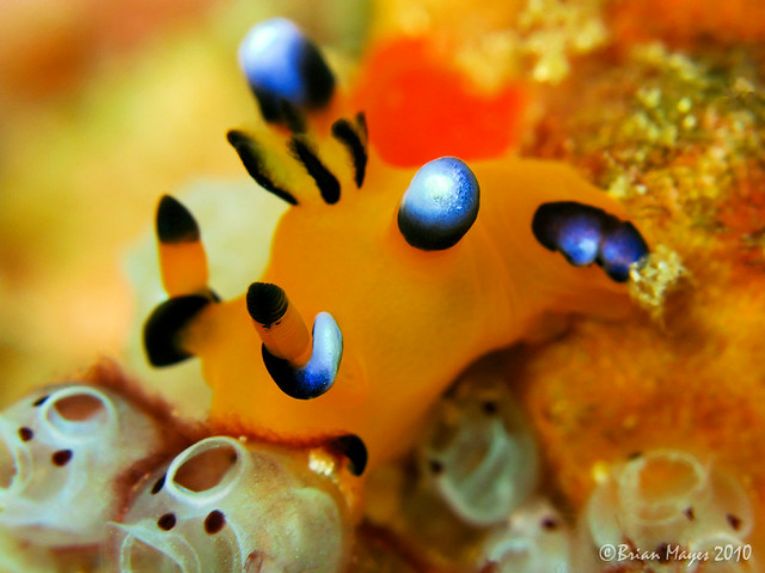](https://mander.xyz/pictrs/image/b7a401c0-61ab-4c3f-8d10-f95546d1156d.jpeg) Above, Photo by [Brian Mayes](https://www.flickr.com/photos/brianmayes/31617346927/) They grow to around 2-3cm in length, and live underneath loose rock and sand! A [video](https://live.staticflickr.com/video/28407361082/1cdb142ac6/1080p.mp4?s=eyJpIjoyODQwNzM2MTA4MiwiZSI6MTcyODA0ODA0OSwicyI6ImJjMWM3ZGUyMTZjZTAyODBjMTIyNjU5YzUzZGQ1N2U5YmU1YzdjMzEiLCJ2IjoxfQ) of one wobbling around in the sea! They also seem to have some variety in colour and patterning....! [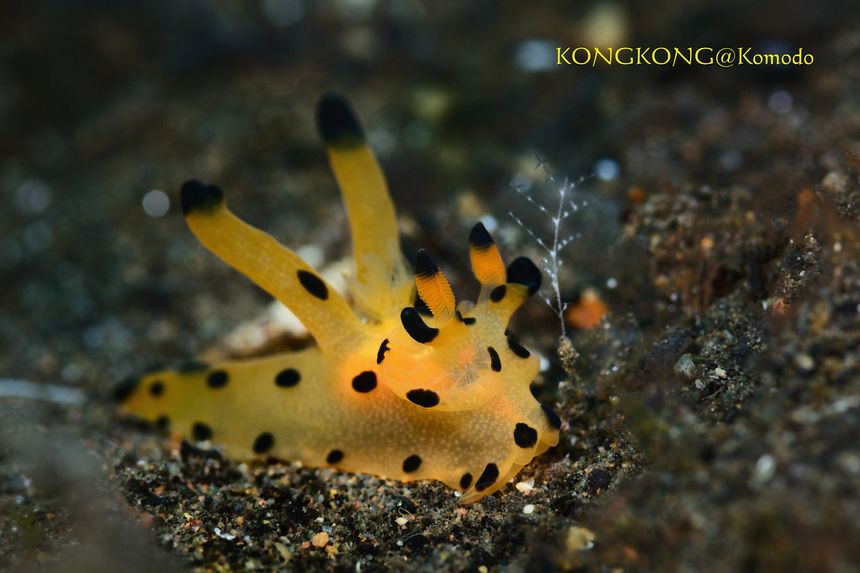](https://mander.xyz/pictrs/image/560ba4c4-5471-4af6-a209-2472a313e96d.jpeg) Above, Photo by [Francis Lau](https://www.flickr.com/photos/90859132@N07/53221851031) [](https://mander.xyz/pictrs/image/a8d8d96b-ded4-412e-92ad-99b6774ab658.jpeg) Above, Photo by [Ludovic](https://www.flickr.com/photos/luko/8433017895/in/set-72157635856595884) Info via [wikipedia](https://en.wikipedia.org/wiki/Thecacera_pacifica), and [seaslugforum](http://www.seaslugforum.net/find/thecpaci) edit- Once again I forgot to do the pop out image thing

Main image, While Gotham sleeps........ by [Michael Gerber](https://www.flickr.com/photos/gerb/172377411/in/pool-flatworms/) RED... [](https://mander.xyz/pictrs/image/66b8e645-e63b-416b-bf94-b9896b876bb0.jpeg) Above, Pseudoceros ferrugineus, by [Benjamin Naden](https://www.flickr.com/photos/ben-naden/4315110689/in/pool-flatworms/) PINK... [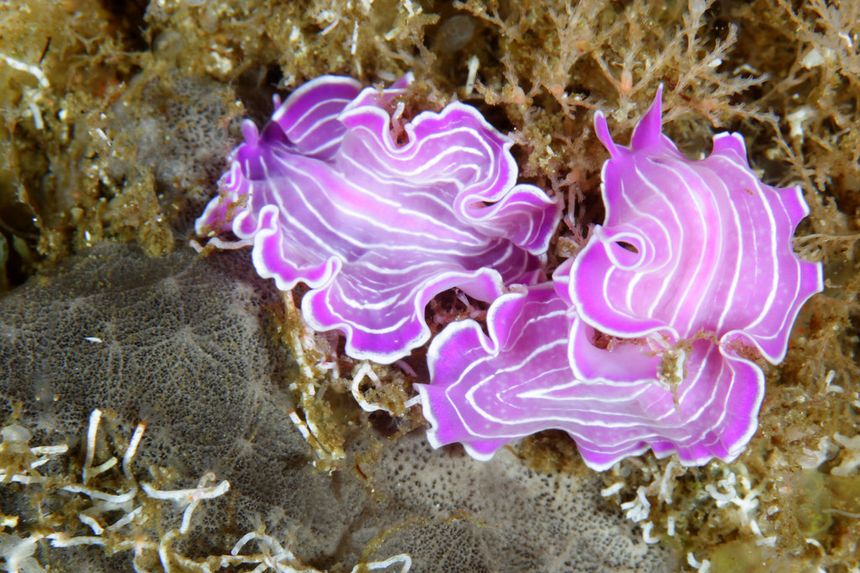](https://mander.xyz/pictrs/image/4b3a9c62-e275-4769-a3c7-23c848788263.jpeg) Above, Protheceraeus roseus, by [João Pedro Silva](https://www.flickr.com/photos/jpsilva1971/9462830326/in/pool-flatworms/) YELLOW... [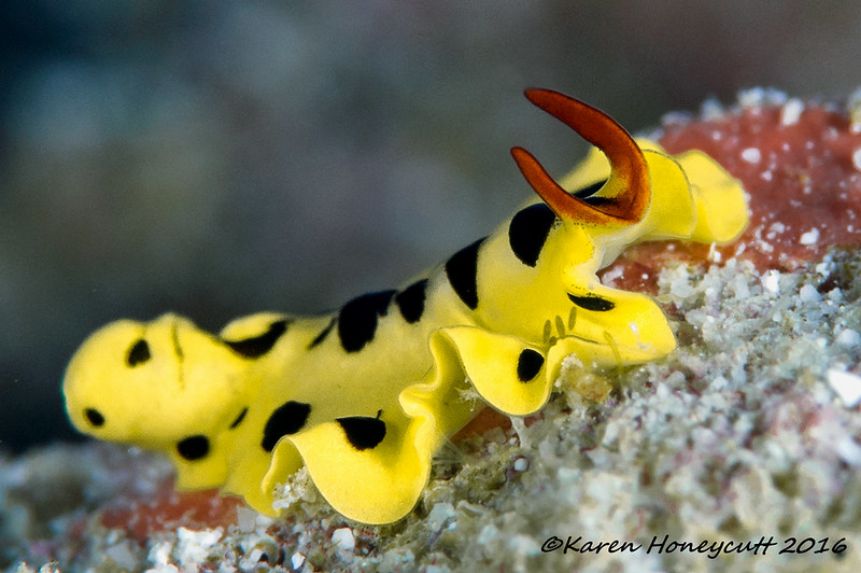](https://mander.xyz/pictrs/image/e12af1e9-66d5-40b2-afe8-0c7af2c61c9f.jpeg) Above, Eurylepta sp. by [Karen Honeycutt](https://www.flickr.com/photos/karenhoneycutt/28504327504/in/pool-flatworms/) ORANGE... [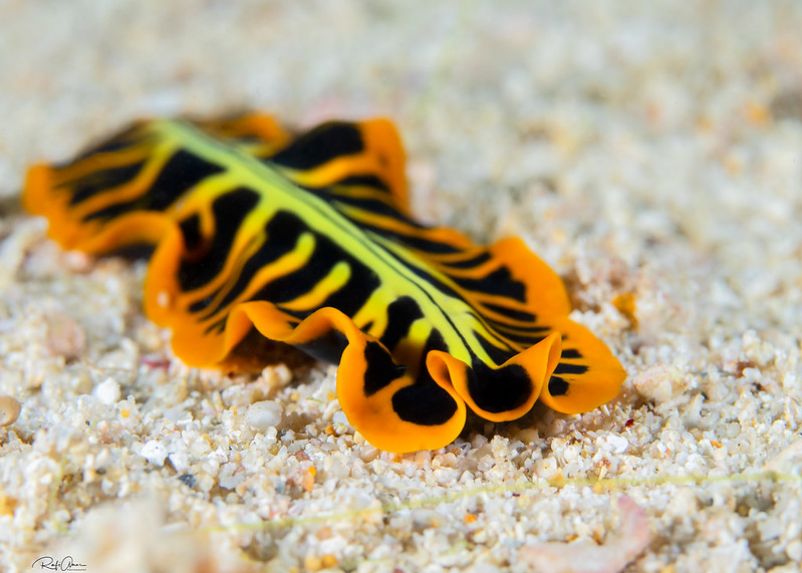](https://mander.xyz/pictrs/image/481479c1-5abf-4141-a476-70bdfeacc5e2.jpeg) Above, Pseudoceros sp. by [Rafi Amar](https://www.flickr.com/photos/100123353@N08/52079807111/in/pool-flatworms/) BLUE... [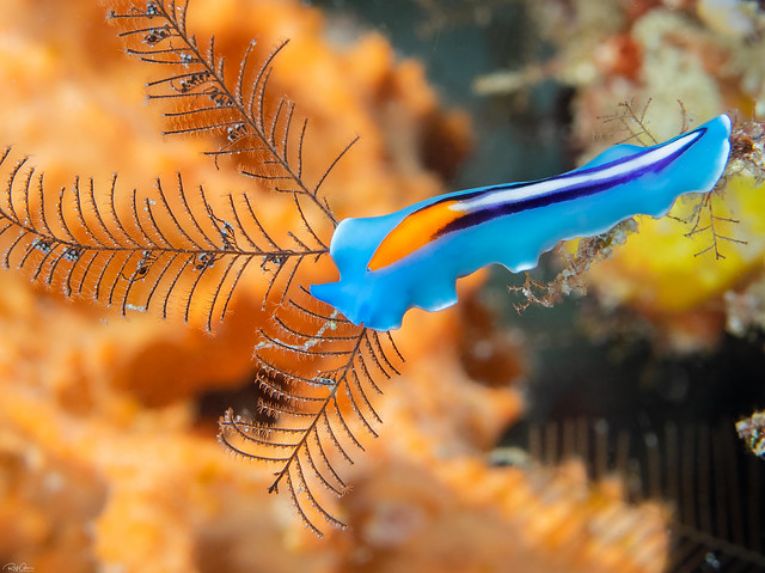](https://mander.xyz/pictrs/image/b4282c4c-7dbb-4321-9079-0d6c277bbb2b.jpeg) Above, Racing Stripe Flatworm - Pseudoceros liparus, by [Rafi Amar](https://www.flickr.com/photos/100123353@N08/52211636019/in/pool-flatworms/) PURPLE... [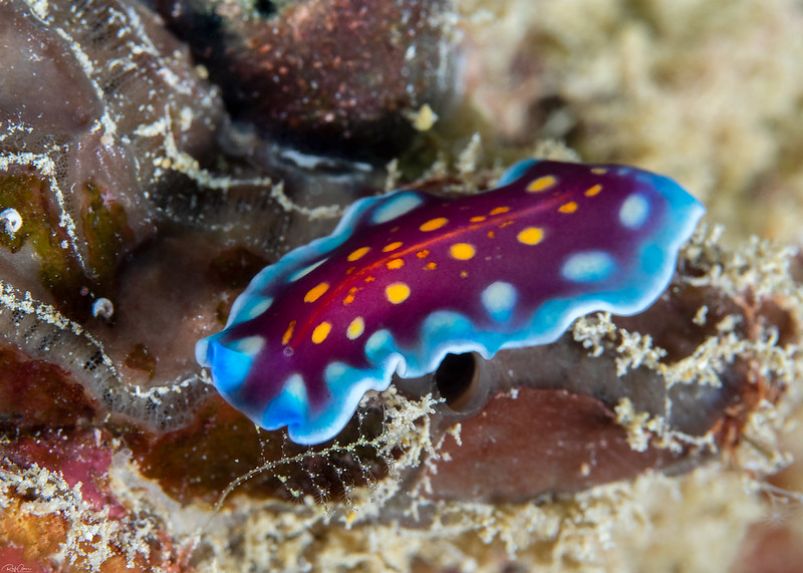](https://mander.xyz/pictrs/image/84ffd5fd-da2f-4b50-8761-32a47958b3b8.jpeg) Above, Linda's Flatworm - Pseudoceros lindae, by [Rafi Amar](https://www.flickr.com/photos/100123353@N08/52061577393/in/pool-flatworms/) BROWN... [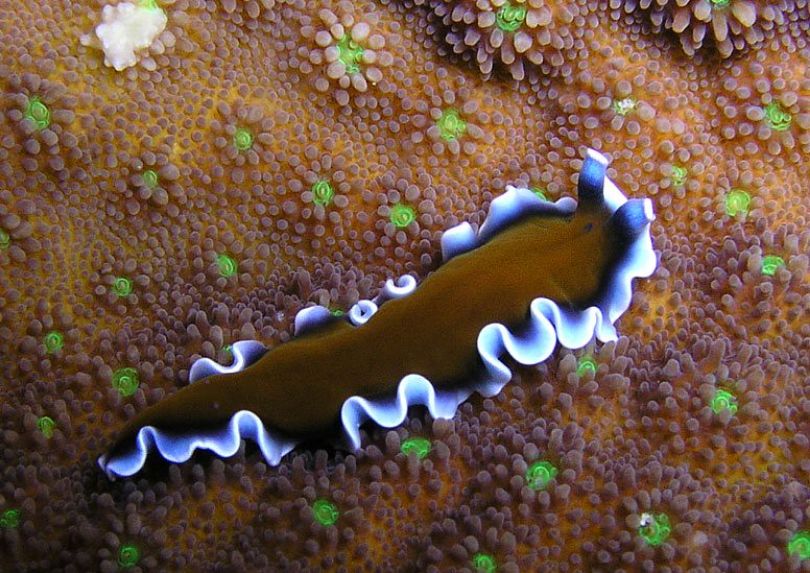](https://mander.xyz/pictrs/image/58be34a1-b3bc-4897-a0d3-a574b6c9a7c4.jpeg) Above, Photo by [Nick Hobgood](https://www.flickr.com/photos/globalvoyager/241392741/in/pool-flatworms/) TRANSPARENT... [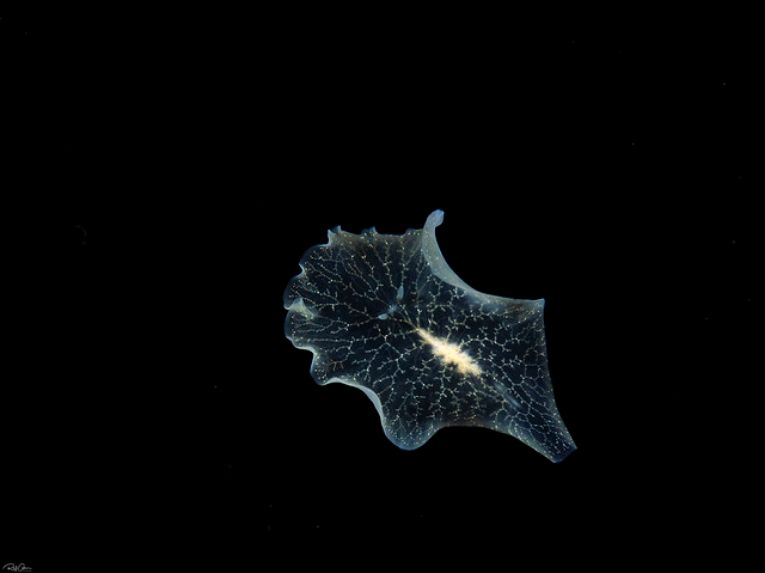](https://mander.xyz/pictrs/image/ea774573-e0e3-46c7-bd45-6213c9c1470e.jpeg) Above, Paraplanocera sp. by [Rafi Amar](https://www.flickr.com/photos/100123353@N08/50830924293/in/pool-flatworms/) SALAD... [](https://mander.xyz/pictrs/image/490d5dee-3ecc-4593-a9a3-ef34c1c410f8.jpeg) Above, Cryptic Flatworm - Pseudobiceros kryptos, by [Rafi Amar](https://www.flickr.com/photos/100123353@N08/52163040529/in/pool-flatworms/) GOTH... [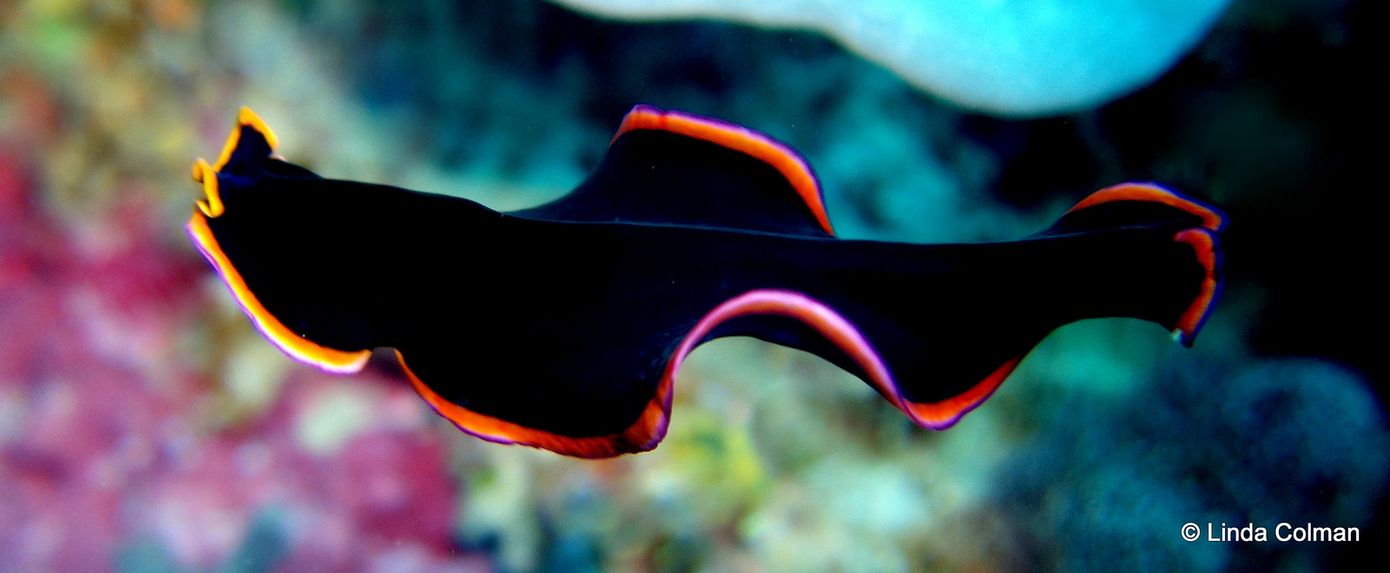](https://mander.xyz/pictrs/image/df00fcad-1746-4ca0-83a3-c7b2d01bf81c.jpeg) Above, Photo by [Bettydiver](https://www.flickr.com/photos/bettydiver/15861548039/in/pool-flatworms/) NEON... [](https://mander.xyz/pictrs/image/54247cf6-dd80-4ad1-beda-2d79162d1b5b.jpeg) Above, Pseudoceros dimidiatus, by [Richard Ling](https://www.flickr.com/photos/rling/438039243/in/pool-flatworms/) STARRY... [](https://mander.xyz/pictrs/image/7de46483-fc15-4da4-a577-af9ace0cfc46.jpeg) Above, Thysanozoon nigropapillosum, by [Patomarazul](https://www.flickr.com/photos/patomarazul/29477310198/in/pool-flatworms/) TRIPPY... [](https://mander.xyz/pictrs/image/e20c53cf-ec8a-40d7-8070-8d7d1bf26294.jpeg) Above, Persian Carpet Flatworm - Pseudobiceros bedfordi, by [Rafi Amar](https://www.flickr.com/photos/100123353@N08/52238541907/in/pool-flatworms/) GLITTERY... [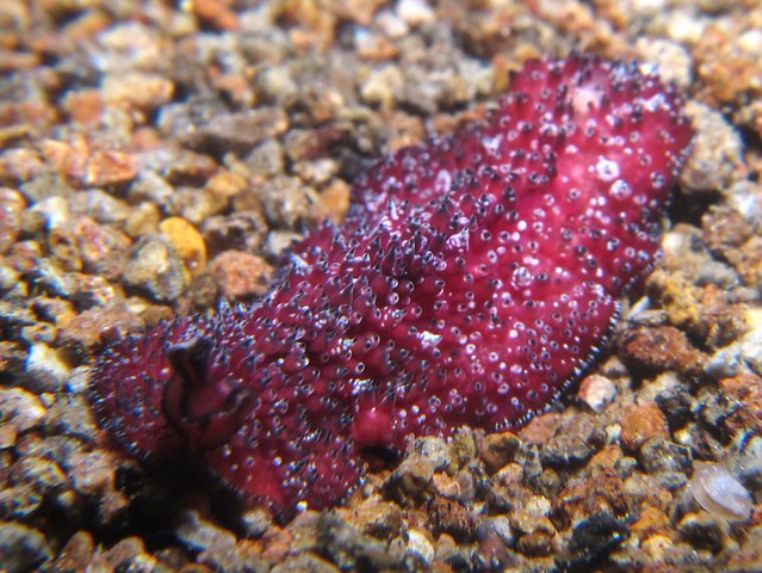](https://mander.xyz/pictrs/image/b36860e4-886a-4d50-a088-aa3d1200b7c6.jpeg) Above, Photo by [eunice khoo](https://www.flickr.com/photos/mermate/11247258695/in/pool-flatworms/) FRILLY... [](https://mander.xyz/pictrs/image/a8a80a94-d454-4e1b-8b7f-f1216494680d.jpeg) Above, Glorious Flatworm - Pseudobiceros gloriosus, by [Rafi Amar](https://www.flickr.com/photos/100123353@N08/52112748584/in/pool-flatworms/) STRIPEY... [](https://mander.xyz/pictrs/image/e01e35ec-ecf7-4434-b603-d614264a22ad.jpeg) Above, Pseudoceros zebra, by [Marina Poddubetskaia](http://seaslugs.free.fr/flatworm/planaire/pseudoceros_zebra_a.htm) SPOTTY... [](https://mander.xyz/pictrs/image/74e7b08c-e545-4764-87f2-27d1ca2e23d2.jpeg) Above, Pseudoceros scintillatus, by [ilan Lubitz](https://www.flickr.com/photos/128664509@N04/21538429653/in/pool-flatworms/) VEINY... [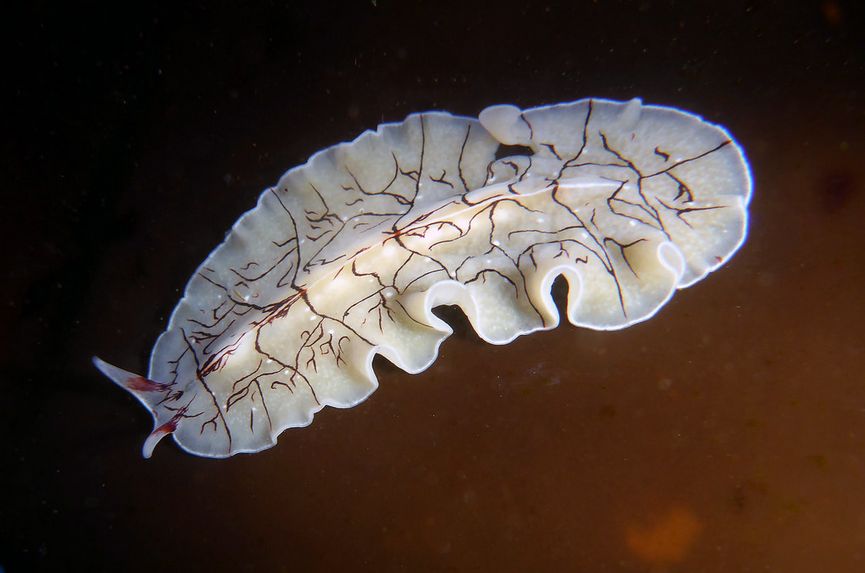](https://mander.xyz/pictrs/image/001ff75a-5a15-49d5-b4ba-a568b78a11e1.jpeg) Above, Eurylepta californica, by [Robin Gwen Agarwal](https://www.flickr.com/photos/30314434@N06/49986230652/in/pool-flatworms/) BRAINY... [](https://mander.xyz/pictrs/image/849f279b-4580-425a-80b7-fcc39a5f2d6d.jpeg) Above, Maritigrella fuscopunctata, by [Rafi Amar](https://www.flickr.com/photos/100123353@N08/51298717669/in/pool-flatworms/) SANDY... [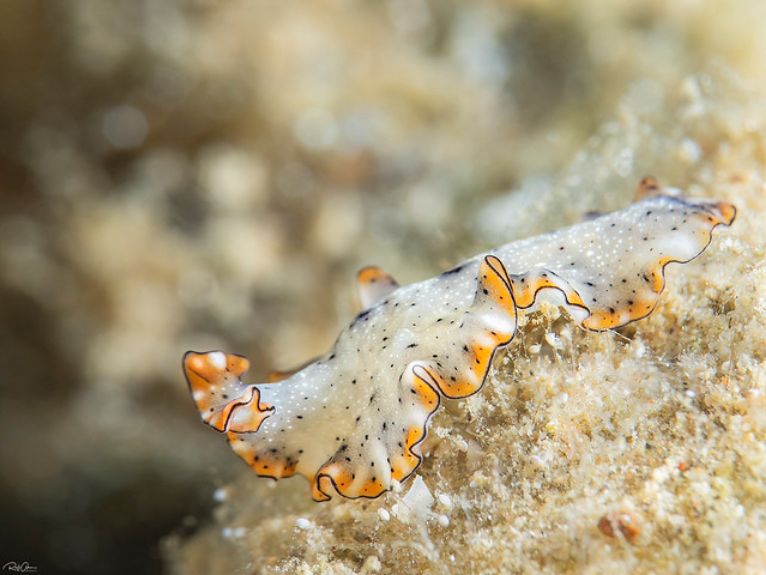](https://mander.xyz/pictrs/image/de07b242-5dc2-4cac-8433-3dc7c873fba0.jpeg) Above, Pseudobiceros damawan, by [Rafi Amar](https://www.flickr.com/photos/100123353@N08/50968755383/in/pool-flatworms/) CAKEY... [](https://mander.xyz/pictrs/image/72effc20-1748-41a9-ac8e-1d91679059f5.jpeg) Above, Lizard Island Flatworm - Tytthosoceros lizardensis, by [Rafi Amar](https://www.flickr.com/photos/100123353@N08/49586869821/in/pool-flatworms/) CAMOUFLAGEY... [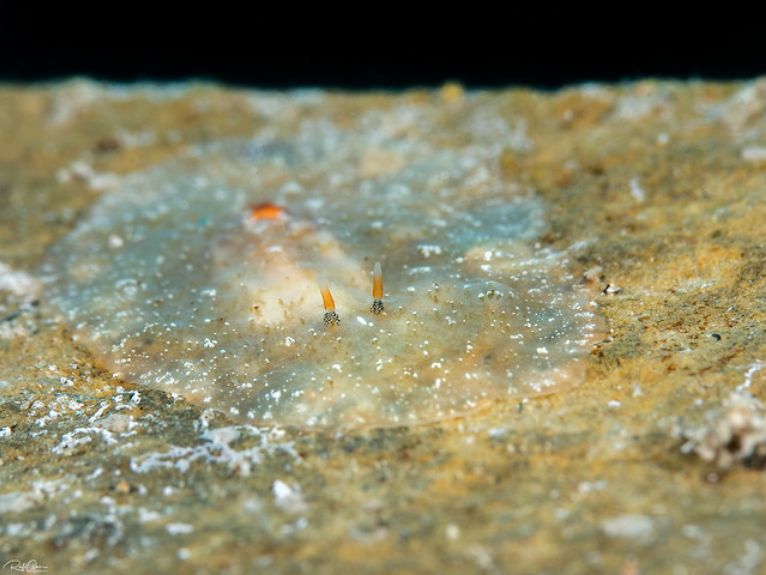](https://mander.xyz/pictrs/image/4121f3da-f381-4068-ae19-4707bce7c9d2.jpeg) Above, Flatworm - Paraplanocera sp. by [Rafi Amar](https://www.flickr.com/photos/100123353@N08/50810583871/in/pool-flatworms/) HOLSTEIN-FRIESIANY... [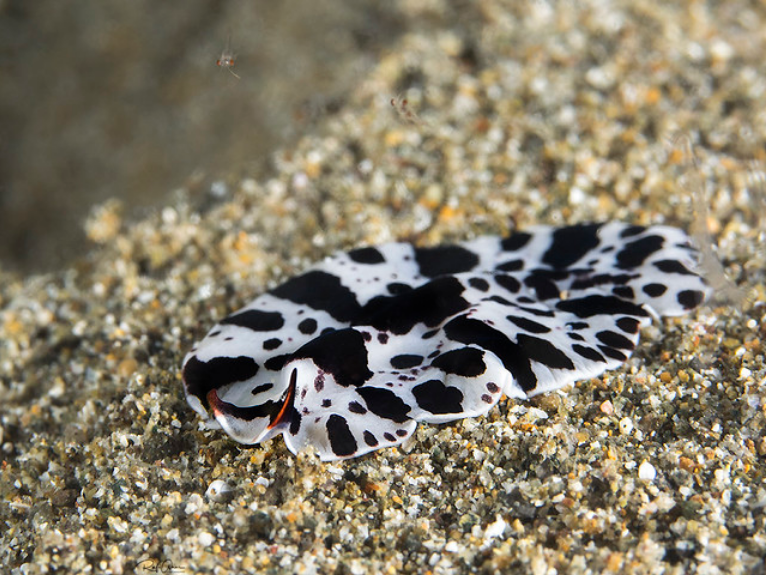](https://mander.xyz/pictrs/image/be51cfe5-9bdc-4f6e-94dd-282d37d90ccf.png) Above, Eurylepta sp.1, by [Rafi Amar](https://www.flickr.com/photos/100123353@N08/50508770776/in/pool-flatworms/) AMBUSH RUG... [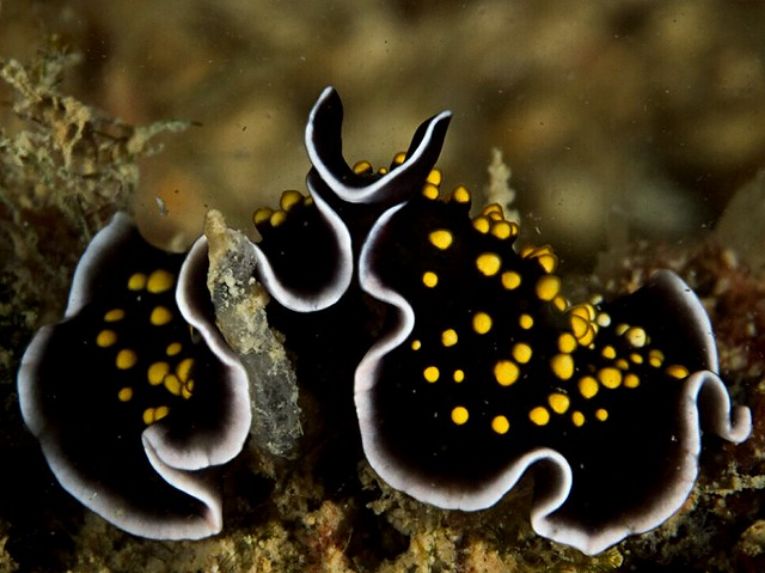](https://mander.xyz/pictrs/image/4411659d-24c1-463d-bd9d-98718ab21c54.jpeg) Above, Photo by [eunice khoo](https://www.flickr.com/photos/mermate/32158954940/in/pool-flatworms/) GOODBYE, FLYING FLATWORM! [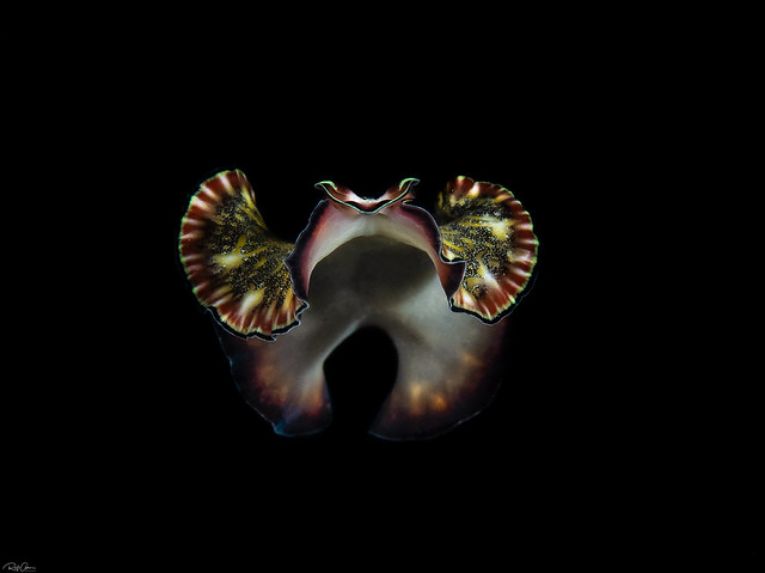](https://mander.xyz/pictrs/image/c99ac87e-705b-4fa8-ba47-89e63701d595.jpeg) Above, Persian Carpet Flatworm - Pseudobiceros bedfordi, by [Rafi Amar](https://www.flickr.com/photos/100123353@N08/52080288255/in/pool-flatworms/) edit- Forgot to do the thing that makes the image pop out when you click on it.....
 quinacridone
Now
•
100%
quinacridone
Now
•
100%
Mantis eyes would be great, especially if they could pop out on stalks!
 quinacridone
Now
•
100%
quinacridone
Now
•
100%
I wish my eyes could stand having water drops (or eye drops in general) in them..... I can't open my eyes underwater or in the shower, it's deeply unpleasant.
Maybe I need to evolve compound eyes? Ideally something iridescent for the bling factor

adj_DSC7484 sparkly nudi, by [Erwin Poliakoff](https://www.flickr.com/photos/erwin_poliakoff/2727462339/in/pool-nudibranchsandseaslugscois/)
 quinacridone
Now
•
100%
quinacridone
Now
•
100%
? I don't understand
edit, I ended up doing a search to understand your comment.... I get it now lol (I'm old, don't judge)
And yes, I <3 moths too 😍

Main image, Oleander Hawk Moth Caterpillar (Daphnis nerii, Sphingidae), by [itchydogimages](https://www.flickr.com/photos/itchydogimages/9398097107/in/photolist-fjtGR2-SBxjy3-EfnTag-KYYxyx-o1TNMJ-2gUpGUa-51Wk9Z-dp3Y3p-Sgt5GS-23wSphm-984Rxf-b2Bckc-dfCCpR-8KL1uA-Sgt5Ho-23wSp1u-cmsKUS-2o1dtRr-SBxjHw-dghVZ7-xfyRp6-21T9pAw-azxoTN-x3Qgys-8Xz2YR-2nxnVgT-rRY9fh-c25C49-2m8XUYV-qTUK8f-prCuKY-CWfTdy-4KjBBG-6YUxYw-fDA65w-9fFpnT-ap3TjH-2oDaGY1-rBF2Jb-qSYDx9-G3KUHY-rzWnEz-2jrsRvG-2oHhUdu-rU8ZHw-rUbDVZ-2qd8ntG-rzWmoM-2oD8rnt-psj38F) >Startled? Alarmed? Did I hear you mutter "WTF?" under your breath? > >Then evolution wins again. Imagine if you were confronted by the same sight if you were a bird or a praying mantis or a snake for that matter. Eyespots (markings that resemble vertebrate eyes) have evolved many times in Lepidopterans (butterflies and moths). The fact that this adaptation has arisen independently so often in this group indicates the general effectiveness of this anti-predator defence. [itchydogimages](https://www.flickr.com/photos/itchydogimages/9398097107/in/photolist-fjtGR2-SBxjy3-EfnTag-KYYxyx-o1TNMJ-2gUpGUa-51Wk9Z-dp3Y3p-Sgt5GS-23wSphm-984Rxf-b2Bckc-dfCCpR-8KL1uA-Sgt5Ho-23wSp1u-cmsKUS-2o1dtRr-SBxjHw-dghVZ7-xfyRp6-21T9pAw-azxoTN-x3Qgys-8Xz2YR-2nxnVgT-rRY9fh-c25C49-2m8XUYV-qTUK8f-prCuKY-CWfTdy-4KjBBG-6YUxYw-fDA65w-9fFpnT-ap3TjH-2oDaGY1-rBF2Jb-qSYDx9-G3KUHY-rzWnEz-2jrsRvG-2oHhUdu-rU8ZHw-rUbDVZ-2qd8ntG-rzWmoM-2oD8rnt-psj38F) 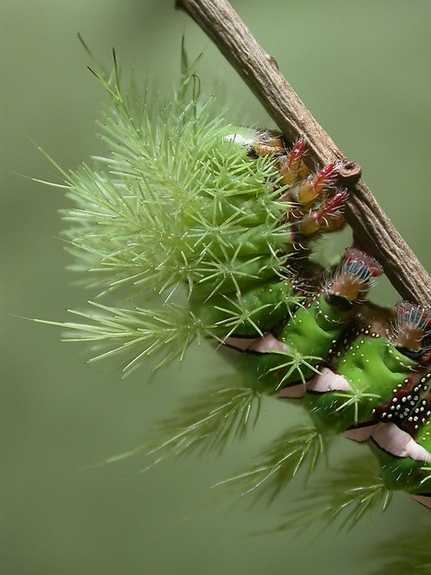 Above, Walking forest, by [Gabriela F. Ruellan](https://www.flickr.com/photos/ultimorollo/3115022468/in/photolist-5KgiDW) 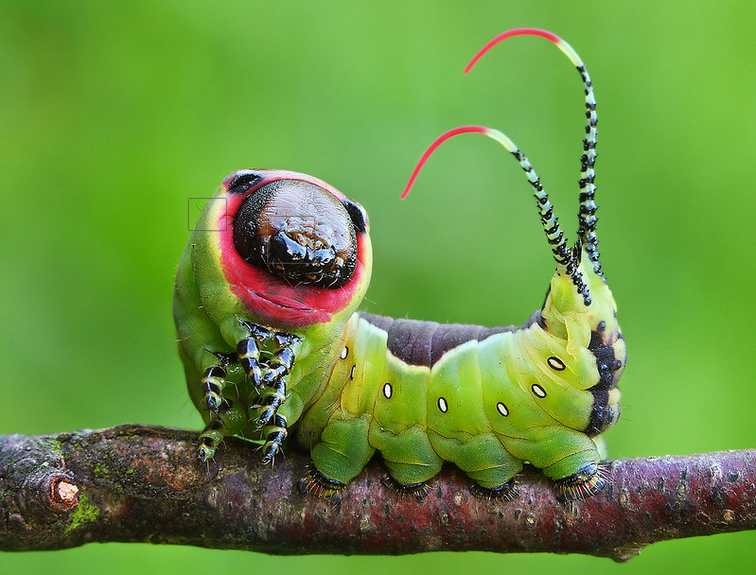 Above, Moth Caterpillar - Cerura vinula, by [Lukas Jonaitis](https://www.flickr.com/photos/38628972@N05/4300903417/in/photolist-7y4fKc-2mdU92U-ae99dT) >I took this photo last summer. This caterpillar is one of the most beautifull caterpillars in Lithuania. I think it is very photogenic caterpillar because of its green colour and red tails which are visible only when caterpillar is scared. He has very nice face. :) [Lukas Jonaitis](https://www.flickr.com/photos/38628972@N05/4300903417/in/photolist-7y4fKc-2mdU92U-ae99dT) 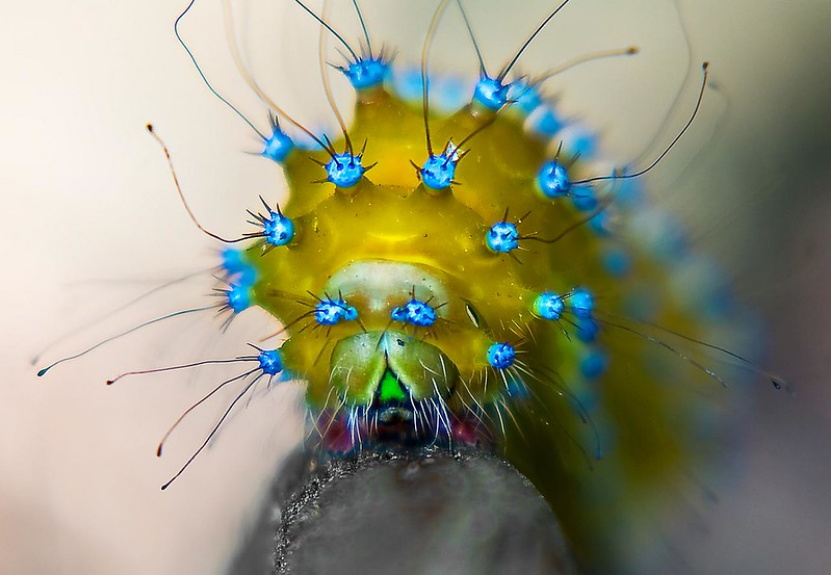 Above, Saturnia Pyri, by [Jano De Cesare](https://www.flickr.com/photos/janodecesare/2782412772/) >This is a beautiful larva of a Saturnia Pyri, a butterfly which is around 16cm in maximum dimension at its mature state. [Jano De Cesare](https://www.flickr.com/photos/janodecesare/2782412772/) 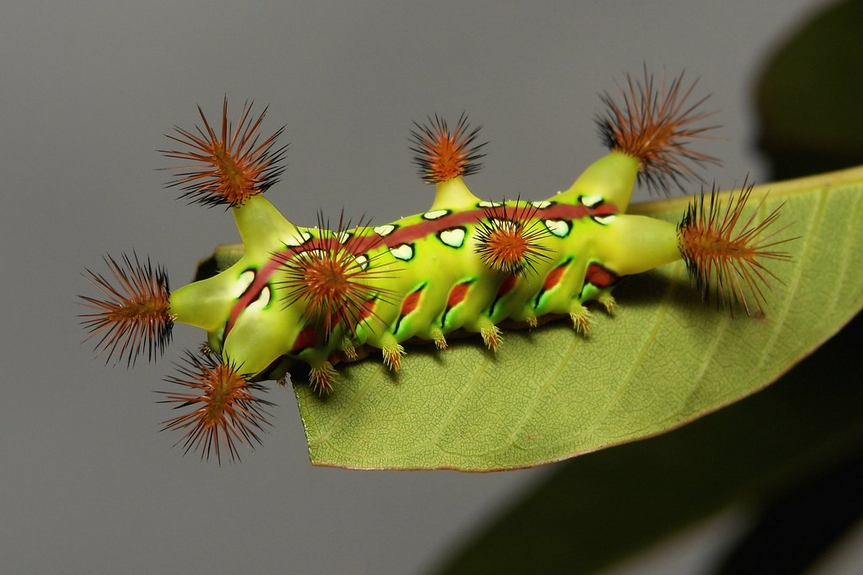 Above, Stinging Nettle Slug Caterpillar (Cup Moth, Setora baibarana, Limacodidae) "The Jester" by [itchydogimages](https://www.flickr.com/photos/itchydogimages/8265021217/) >First-in-line to the throne of the brilliant Yunnan lineage of Limacodid caterpillars, together with its alternate colour form, "The Clown", "The Jester's" livery is almost fluorescent. [itchydogimages](https://www.flickr.com/photos/itchydogimages/8265021217/) 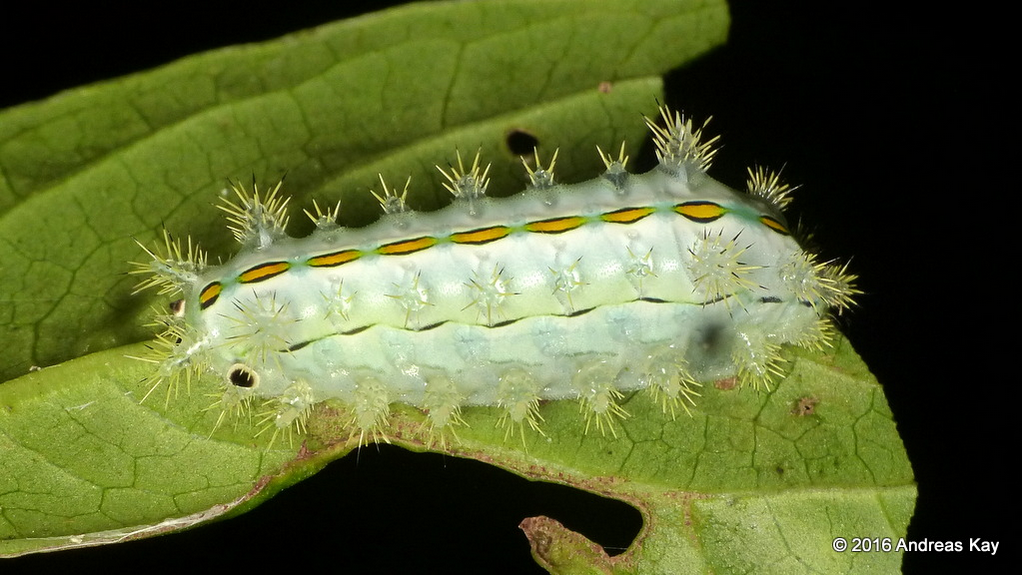 Above, Stinging Nettle Slug Caterpillar, Limacodidae, by [Andreas Kay](https://www.flickr.com/photos/andreaskay/28506148796/)  Above, 3rd Instar Cecropia, by [Barb Sendelbach](https://www.flickr.com/photos/88016566@N03/48304100062/) 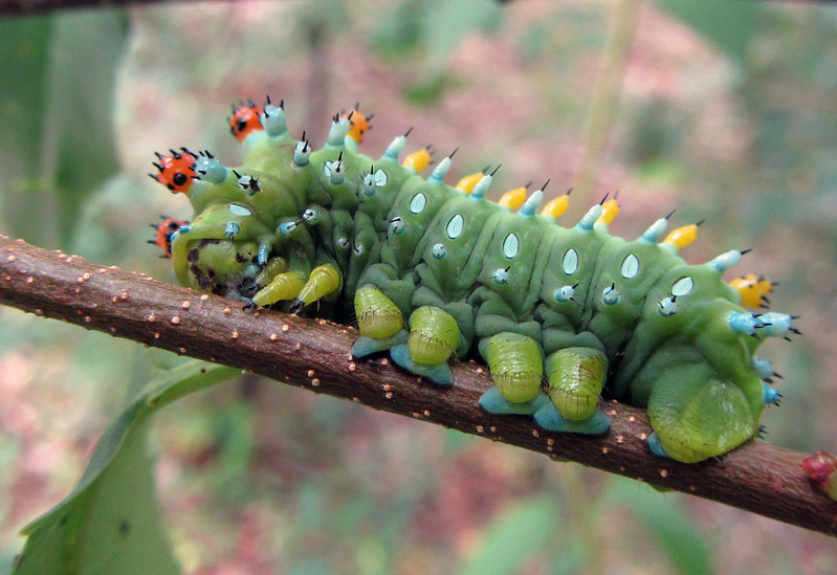 Above, Big Foot (Cecropia), by [MaggieDu](https://www.flickr.com/photos/maggiedu/5981591142/) 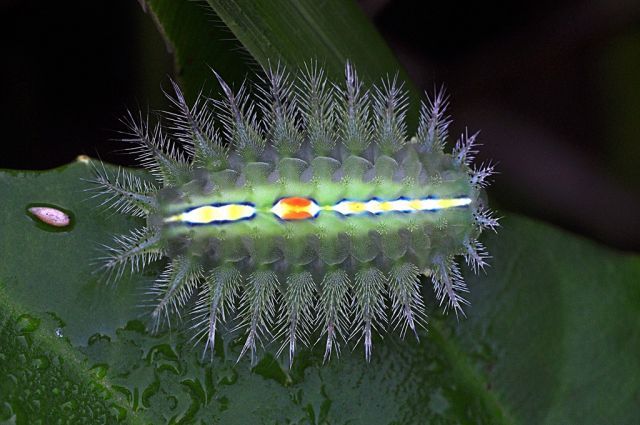 Above, Photo by [Frank Starmer](https://frank.itlab.us/photo_essays/wrapper.php?aug_22_2009_caterpillar.html) 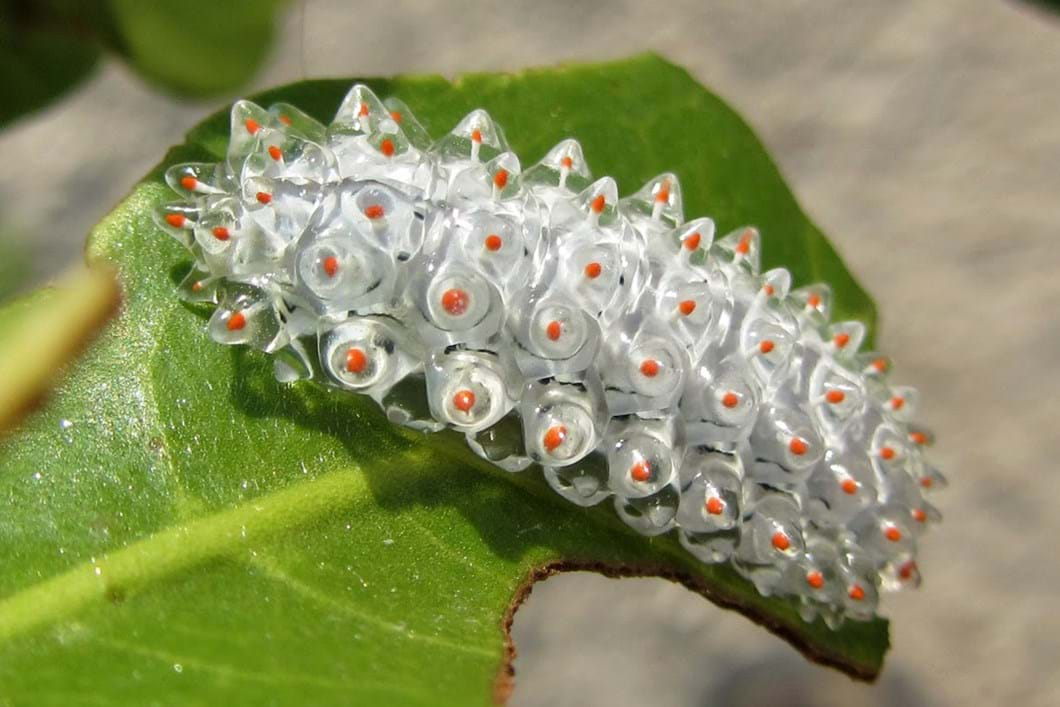 Above, Dalceridae moth caterpillar, by [Gerardo Aizpuru](https://www.projectnoah.org/spottings/10258111) >Dubbed the 'jewel caterpillar', this lovely, translucent larva belongs to a family of moths known as Dalceridae. Although scientists are still unsure about the exact function of the caterpillar's translucent, gooey attributes, the leading theory is that the slimy stickiness helps to deter predators. According to Scientific American, the jelly-like 'cones' that cover the body break off easily (sort of like a lizard's tail), helping the caterpillar slip out of a predator's clutches. [source](https://www.earthtouchnews.com/in-the-field/film-and-photo/12-weird-and-wonderful-caterpillars/) 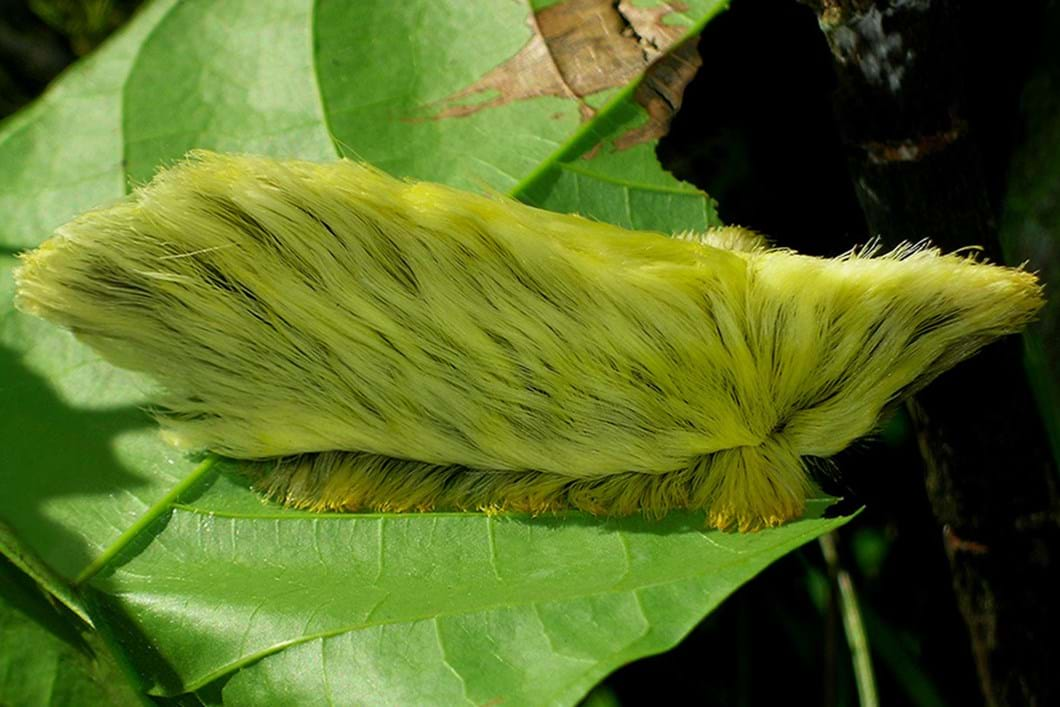 Above, Flannel moth caterpillar, by Drriss & Marrionn found [here](https://www.earthtouchnews.com/in-the-field/film-and-photo/12-weird-and-wonderful-caterpillars/) >It may look like Donald Trump's misplaced toupee (it's actually been dubbed the 'Donald Trump caterpillar'), but this flannel moth larva is actually not covered with hair at all. Those silky-looking threads are actually venomous spines that can cause intense, burning pain when touched, making the caterpillar one of the most venomous in the US. [source](https://www.earthtouchnews.com/in-the-field/film-and-photo/12-weird-and-wonderful-caterpillars/)

Facelina rhodopos, by [Rafi Amar](https://www.flickr.com/photos/100123353@N08/50906821128/in/pool-nudibranchsandseaslugscois/)

European Paper Wasp - Polistes dominula, by [Heath McDonald](https://www.flickr.com/photos/heathmcdonald/54025463926/in/pool-macrobugs/) >Whilst looking for the Bee Flies I came across a solitary male Paper Wasp on a dead leaf, it wasn’t the best angle, whilst moving the camera gear it started to be aware of me and moved to this position which looked even more awkward side one but from the front, gave a great position for a portrait, managed a few shots before it started moving again so left it alone at that point. > >Best viewed very large

Antiopella cristata, by [Jose Salmerón](https://www.flickr.com/photos/salmeroncasanova/53962411466/in/pool-nudibranch/) >It is a gift from the sea to find it, for me the most beautiful nudibranch in the Mediterranean. > >I like to investigate the origin of the names of the species and I especially liked the one of this nudi price: > >"Antiopella" the fact that it is a marine animal and in particular a nudibranch suggests that it is Antiope, the daughter of the guardian of the winds Aeolus and Enarete, lover of Poseidon, there it is😊😉 > >cristata: from Latin [cristatus, a, um] = crested, crested, related to the caruncle among the rhinophores.

Janolus by [Sergi Garcia](https://www.flickr.com/photos/sergi-foto/7613855538/in/pool-portraitsofplanetocean/) >Nudibranchs in particular are especially popular with divers and underwater photographers because of their often vibrant and beautiful color patterns. The coloration is useful for more than just a pretty photo, however. Bright colors warn predators that these nudibranchs would make a bad meal because they are armed with toxins and other defenses [Smithsonian](https://ocean.si.edu/ocean-life/invertebrates/collage-nudibranch-colors) edit- had to re-upload the photo
 quinacridone
Now
•
100%
quinacridone
Now
•
100%
Thank you 👍

Main Image of.... >....three species of tunicates ("sea squirts") - Polycarpa aurata is purple and orange, Atriolum robustum is green, and the blue is from the genus Rhopalaea. (Nick Hobgood) There are around 3000 species of Sea Squirts aka Tunicates! [](https://mander.xyz/pictrs/image/b98cbf28-a417-4672-a54f-9b651e57bdbb.jpeg) Above, Corella parallelogramma by [Mark N Thomas](https://www.flickr.com/photos/marknthomas/22166670620/) They are found in salt water throughout the world! They are our closest invertebrate relatives! [](https://mander.xyz/pictrs/image/8ba1f59d-746f-49f0-aa53-1e2b76822b27.jpeg) Above, Photo by [Chas Anderson](https://www.flickr.com/photos/naturetrek/30200588443/) They are called Sea Squirts because if they are touched or alarmed the muscle will suddenly contract forcing the water inside to shoot out! Sea Squirt larvae look like frog tadpoles! [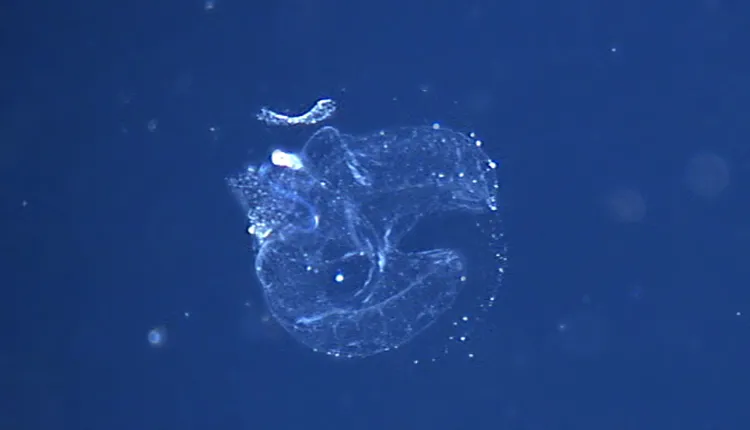](https://mander.xyz/pictrs/image/32779f94-f549-49ce-8c06-901a8f79c83e.webp) Above- > A deep-water larvacean (aka “sea tadpole”) inside its mucous “house,” which concentrates food from the water prior to reaching the animal’s mouth. (Hidden Ocean 2005, NOAA) As larvae they swim around in the ocean current, and when they find a food rich environment they use sucker to attach to a rock, dead coral, boat dock, or mollusk shell! [](https://mander.xyz/pictrs/image/b8ee19ca-9773-4f72-856f-087128182c9c.jpeg) Above, Photo by [prilfish](https://www.flickr.com/photos/silkebaron/19265281275/) Then they begin metamorphosis! [](https://mander.xyz/pictrs/image/18f59a8e-8ae3-4c41-bc0e-ade78562d391.webp) Above- >Tunicate larvae resemble tadpoles (developing frogs). (Van Name, 1945) Their notochord begins to shrink and is absorbed into the body, the tunic forms as the transformation continues and finally it becomes an adult Sea Squirt! As an adult it will now feed on tiny particles found in the water, primarily bacteria! [](https://mander.xyz/pictrs/image/314d0f8e-5f92-43dc-962d-9f07dfd4d300.jpeg) Above, Blue Bell Sea Squirt (or Tunicate) - Perophora namei by [Jim Greenfield](https://www.flickr.com/photos/jim1/51610071378/) There are two types of sea squirts- solitary and colonial! Both have 2 siphons. The Oral Siphon receives the nutrient content in the water, and the Atrial siphon excretes the waste! Colonies are formed when a newly settled larvae changes into an adult. It then splits or 'buds' producing new individuals! [](https://mander.xyz/pictrs/image/6c5f9076-74be-4f77-be57-5649d65094ae.jpeg) Above, Clavelina sp. by [Jim Greenfield](https://www.flickr.com/photos/jim1/48096788788/) Colonies can range from a few centimetres to several metres depending on food supply and predation! Colonial Sea Squirts share a common tunic and sometimes and also sometimes share the atrial siphon! They have a digestive system similar to ours, complete with an esophagus, stomach, intestines and a rectum! Sea Squirts act as ocean purifiers, as they consume bacteria. They can also absorb zinc and vanadium, indicating heavy metal presence within their ecosystem! [](https://mander.xyz/pictrs/image/a832bd55-0fe1-4d5a-87bf-ea4aa584ea19.jpeg) Above [An obligatory Nudibranch!], Striped sea slug snacks while strolling on a sea squirt by [Nick Hobgood](https://www.flickr.com/photos/globalvoyager/40715338252/) All photos and info found [here](https://ocean.si.edu/ocean-life/invertebrates/tunicates-not-so-spineless-invertebrates), except where indicated! And as always my usual disclaimer- I'm not an expert in anything, I just enjoying finding and sharing interesting things.... Any mistakes are mine and I'll correct them if you let me know in the comments 👍 edit re-uploaded main image as it wasn't showing edit 2 changed 'ancestors' to 'relatives' in the title

Blue Dragon by [Bill Kuiper](https://www.flickr.com/photos/12499727@N04/14008442776/in/pool-portraitsofplanetocean) >Blue Dragon nudibranchs are very common to the southeast coast of Australia and have a few color variations. Juveniles are white with blue rhinophores, and adults vary from dark purple to lavender to golden brown. I have seen these grow to a length of approximately 4 inches... Text from [here](https://ocean.si.edu/ocean-life/invertebrates/collage-nudibranch-colors)

Lovely story from [The Guardian](https://www.theguardian.com/lifeandstyle/article/2024/jun/28/experience-a-leech-lived-up-my-nose-for-a-month) >It was September 2014. I’d just started working front of house in a fancy hotel in Edinburgh. I spent most of my shifts with a paper napkin pressed to my nostril, as I had been getting lots of nosebleeds. I would soon find out why. > >A few weeks earlier, I’d been travelling in Vietnam. I had rented a moped and had the time of my life driving around. I soon crashed but luckily was wearing a helmet, so only got a small bump on my head. > >A few days afterwards, I started to intermittently spot blood from my right nostril. I assumed it was from the crash and didn’t think too much of it. I was 24 and too busy partying to take anything like that seriously. I danced the nights away while ignoring the persistent blockage in my nose. > >Reality came flooding back after returning to cold Glasgow. Nothing had changed with my nose, so I went to the GP. The doctor told me that it didn’t sound like anything to worry about. I was advised to use Vaseline on the area to keep the nostril lubricated and was sent on my way. > >A week later, I moved to Edinburgh for my job. That’s when I started to feel frustrated with my constantly stuffy nose. I wasn’t in pain, but sleeping was difficult. I would blow my nose to try to clear the blockage, but it would only lead to nosebleeds. Things started to get particularly weird when I was having showers. Through all the humidity, I could feel a thick, slimy thing moving down my nose. > >I had a day off work; it had been a month since I returned from abroad. My friend Jenny was coming from Glasgow to meet me for dinner. I was in the shower when I felt the all-too-familiar feeling, but this time I glimpsed something hanging out of my nostril. I jumped out and raced to the mirror, frantically wiping off the steam. I saw a clot hanging out – then recoiled in horror when I saw ridges running along a thick black body. > >I rushed out of the house to see my friend, screaming, “It’s a full-on worm!” Jenny knew about the problems I’d been having with my nose, but she didn’t believe me at first. I stuck my nose in the air so that she could see for herself. Her mouth hung wide as she gaped and said: “Yep, there really is a worm in there.” > >At first, it was the most hysterical thing that had ever happened to us. We couldn’t stop laughing. Because it had been in there for so long, I felt very blase about the whole thing. We rang the NHS helpline. The call adviser was crying tears of laughter over the phone, as it was the most bizarre thing she’d heard. > >We went to A&E. Doctors were bewildered and didn’t take me too seriously at first. But once the nurse looked up my nose, she gasped. I was placed on a gurney as they stretched my nostril open with forceps. The doctors spent 30 minutes using different tools to try to prise the leech away. Leeches release an anaesthetic when they bite so they can stay on a body for longer, which is why I couldn’t feel the pain before – but it was agony when the doctors tried to pull it out. When they finally succeeded, I felt a wave of cold air shooting through the blocked nostril. It was like being in a nightmare, seeing the leech held up high, squirming. It was longer than my finger. > >I’d swum a lot on holiday, so we guessed that it most likely came from there rather than having anything to do with the motorcycle accident. The leech was put in a jar and sent to a specialist hospital in London for further testing – they were worried that it may have passed on further diseases to me. Suddenly, something that was so funny seemed much more serious. > >Luckily, all of my tests came back clear, and I had no side-effects. I was given the leech back in a pot and told to dispose of it. The leech was rock hard because it had so much of my blood inside. It made me squirm just looking at it. > >Now, a decade later, the story of the leech and me has become a go-to anecdote whenever I meet someone new. I even had someone message me on LinkedIn recently asking about it. So while the leech was attached to me in a very physical sense, I guess we’re still attached metaphorically. But I’m very glad it’s out.
 quinacridone
Now
•
100%
quinacridone
Now
•
100%
Link to an earlier post about shrimp jockeys....
https://mander.xyz/post/11798834
....and a rather spiffy pic!

photo by Ludovic
 quinacridone
Now
•
100%
quinacridone
Now
•
100%
I like how you're thinking.... also a shrimp jockey jauntily attached to the head at the side (like a head broach)
 quinacridone
Now
•
100%
quinacridone
Now
•
100%
Fuch yeah! That is amazing!
So many possibilities..... Something frilly or sleak? Maybe neon/pearlescent? Spots, stripes? An Aeolid with a garnish of cerata, or a Dorid with a branchial plume? And don't forget a pair of magnificent rhinophores and optional Emperor shrimp jockey!
Holy shit I'm really excited for you! And I'm not the one making the costume or going to the party!
In fact as an autistic person I'd just spend hours of fun making a costume, and then not go to the party.... just wear it at home
You'll have to post your outfit when it's done 😀

Main image, Glossodoris Sedna by [Cajo Producciones](https://www.flickr.com/photos/cajjo/7078457083/in/photolist-7vShqR-ahGuci-7vW745-akpptg-g37Vif-bnCugN-bMuWFv-7CLA7-21jn7Yw-qHfsKZ-cEnq7y-2nfXPXj-2ng5rLZ-2ng6Mkc-2ng6M3J-2efvkxi-5dKBd5-c4nbXA-8x2KVy-yg2Hnw-hCww2d-hCvR1i-iT3zA-6kGgbM-7ND4Fb-H6zyv-5kdFRx-67caoE-8uzrZ3-gYyQ4m-5kgMn5-huhJAr-dGcCK1-hugP6S-7e3LcV)  Above Glossodoris stellatus by [digidiverdeb](https://www.flickr.com/photos/39623502@N02/3896520349/) 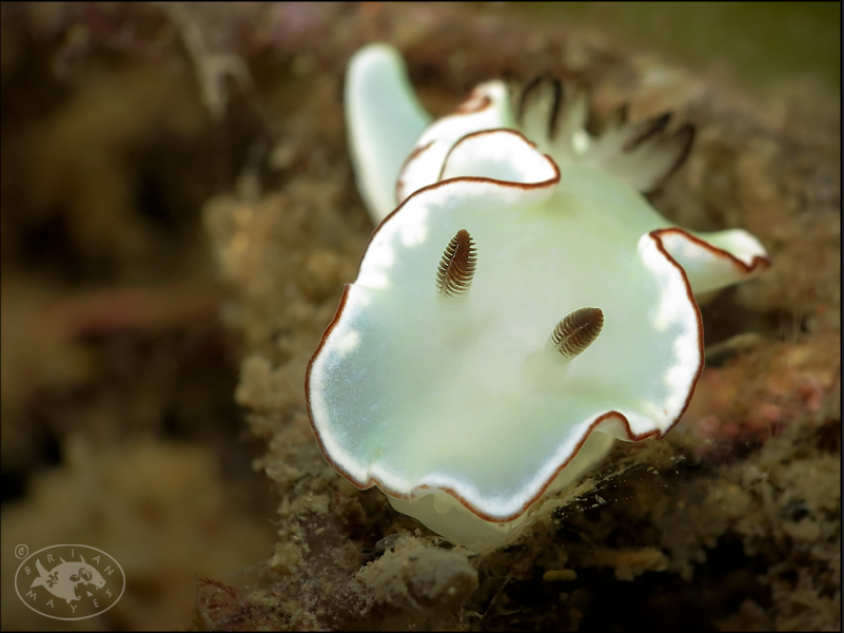 Above Glossodoris angasi by [Brian Mayes](https://www.flickr.com/photos/brianmayes/19303050476/) 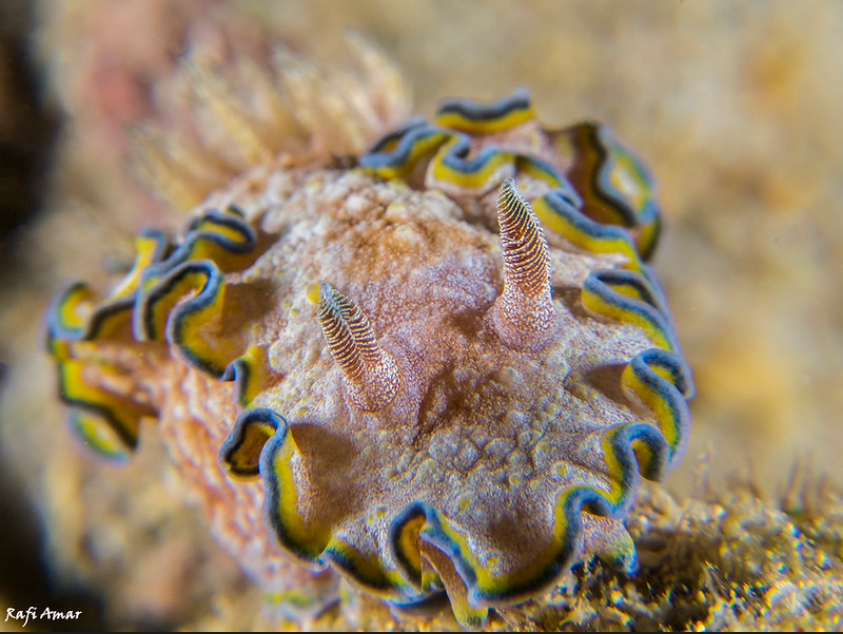 Above Glossodoris acosti by [Rafi Amar](https://www.flickr.com/photos/100123353@N08/49936819893/) 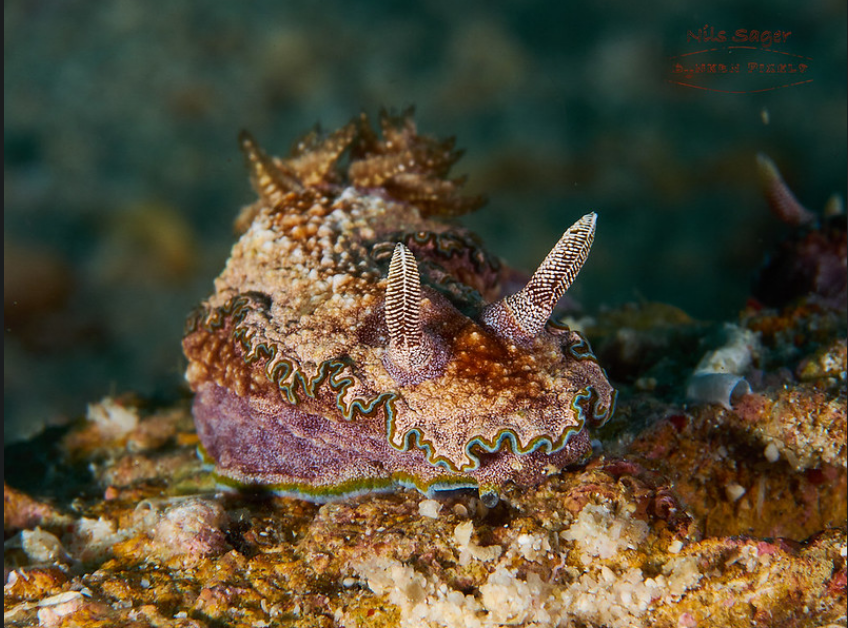 Above Glossodoris hikuerensis by [@halimeda](https://www.flickr.com/photos/nils_sager/49862758811/) 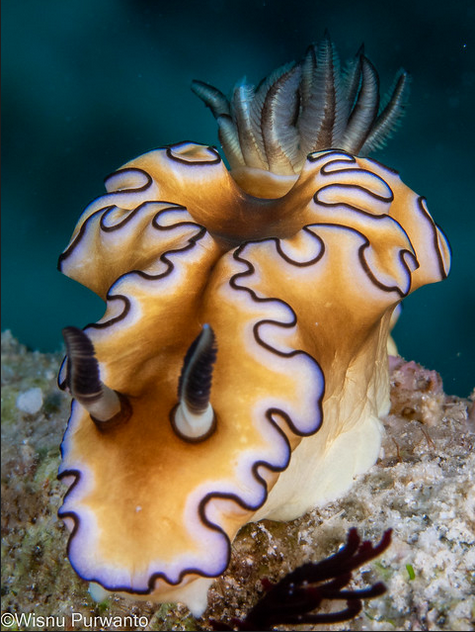 Above Glossodoris atromarginata by [Wisnu Purwanto](https://www.flickr.com/photos/wisnupurwanto/51683534019/)  Above Glossodoris sedna by [Guillem Mas](https://www.flickr.com/photos/guillem_mas/4276129857/)  Above Colemans Glossodoris by [Steve Gillespie](https://www.flickr.com/photos/theseaflea/31703996104/) 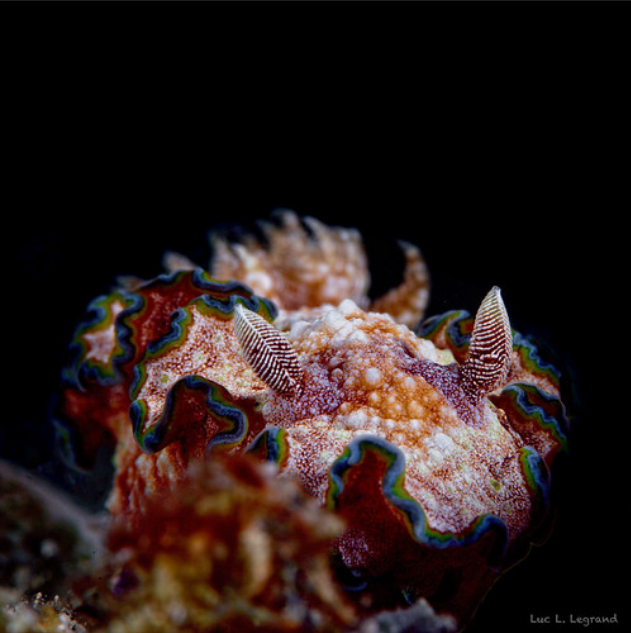 Above Glossodoris cincta by [Luc L. Legrand (thanks for 7 M views)](https://www.flickr.com/photos/capepaperu/50034488547/)  Above Glossodoris rufomarginata by [divemecressi](https://www.flickr.com/photos/berndhoppe/43190649191/) 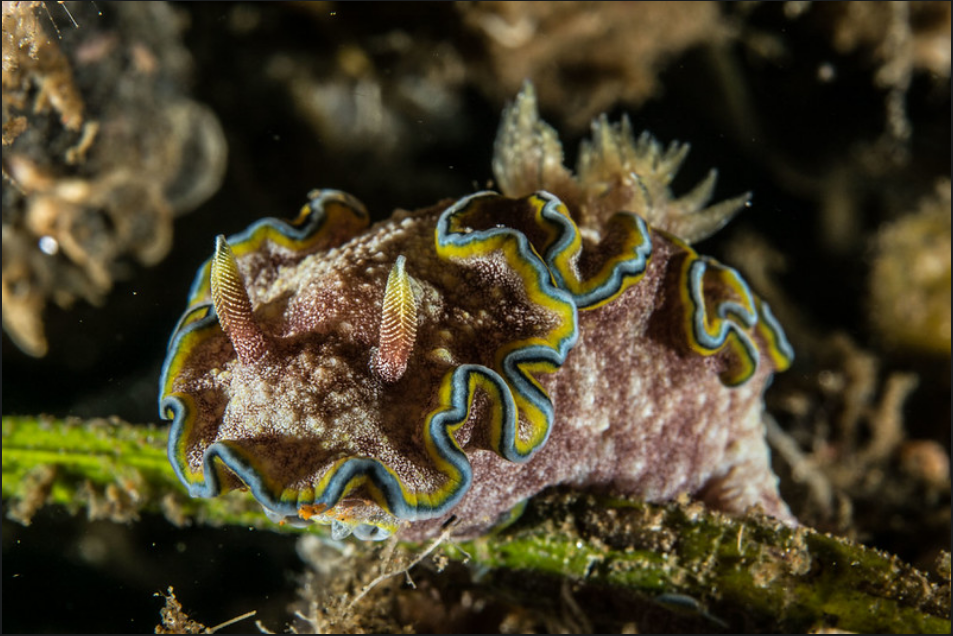 Above Gossodoris cincta by [jack pokoj](https://www.flickr.com/photos/152140870@N04/36976132641/) 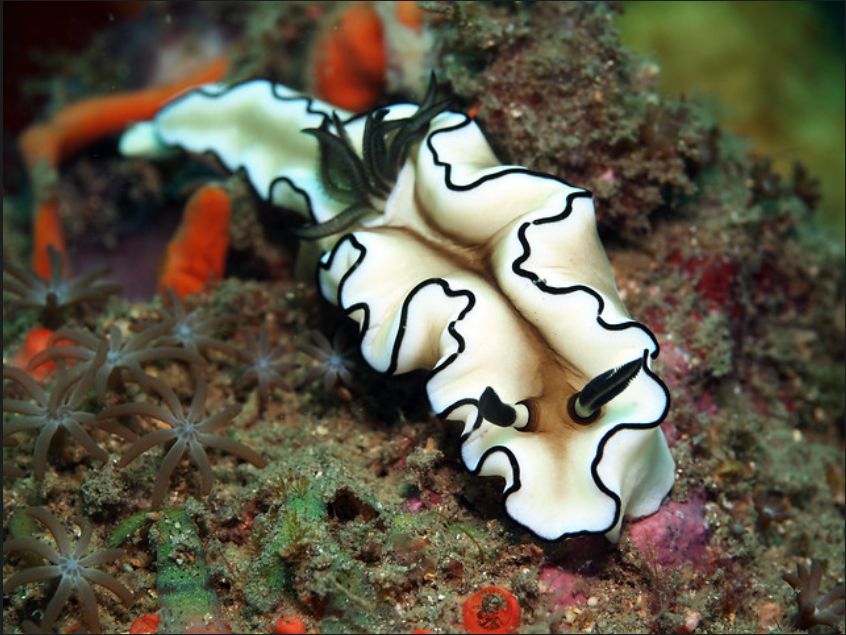 Above Glossodoris atromarginata by [divemecressi](https://www.flickr.com/photos/berndhoppe/11900340834/) 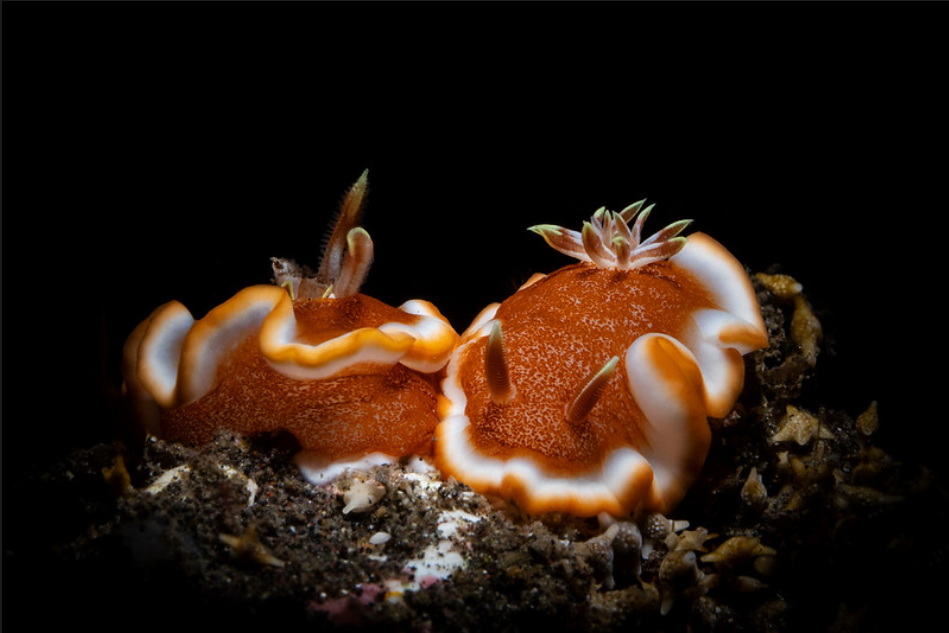 Above Glossodoris rufomarginata mating by [Ludovic](https://www.flickr.com/photos/luko/52892130945/) 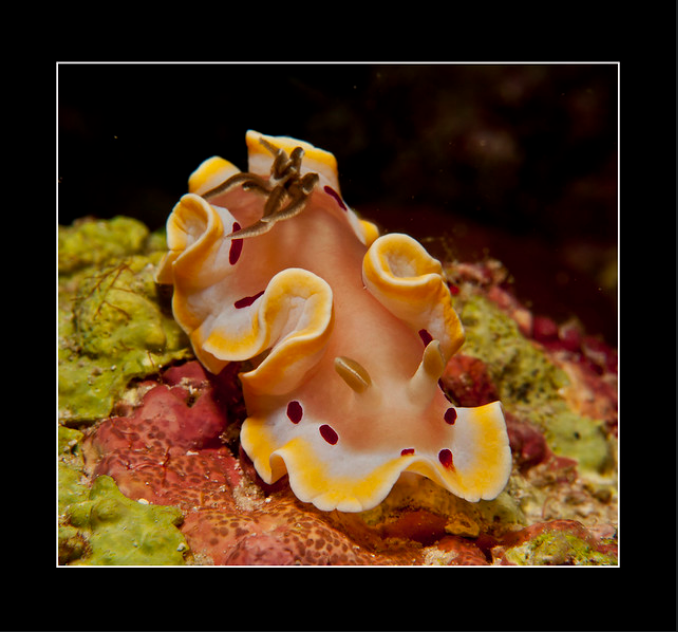 Above Glossodoris cruenta by [Tavistock](https://www.flickr.com/photos/69440424@N04/10104313525/) 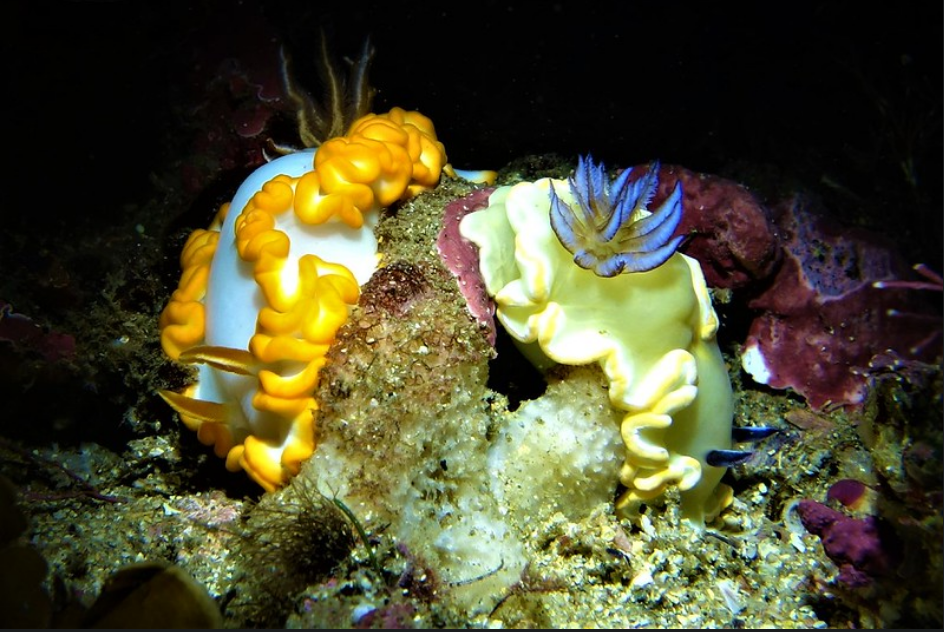 Above Averns Glossodoris with a Colemans Glossodoris by [Steve Gillespie](https://www.flickr.com/photos/theseaflea/33742888265/) 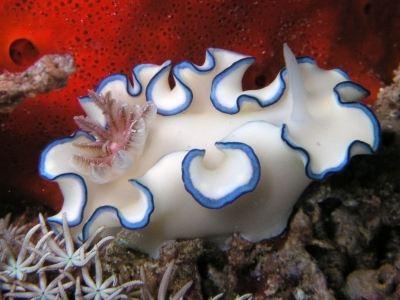 Above [Glossodoris sp. 16](http://www.seaslugforum.net/find/glossp16) 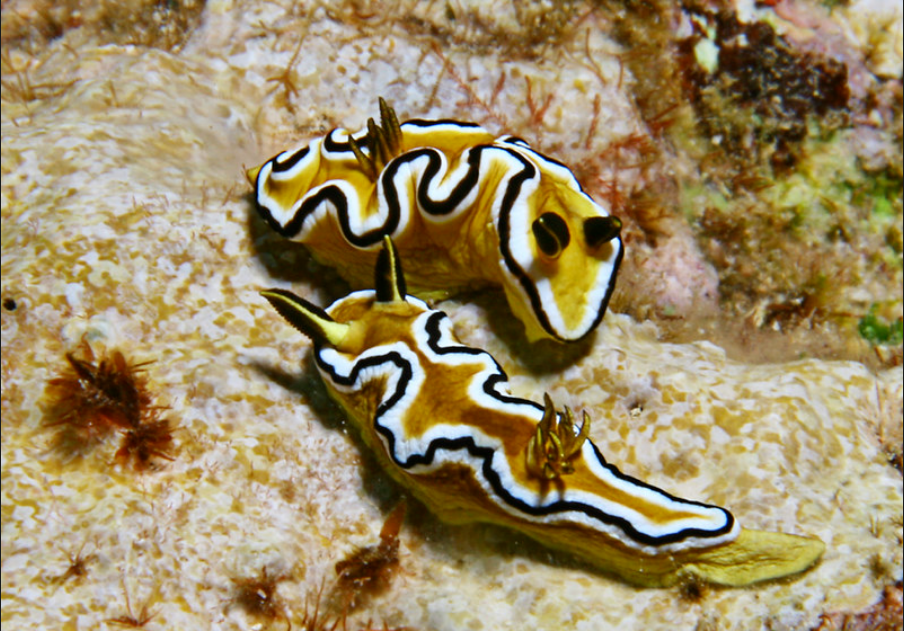 Above Glossodoris sibogae by [Thomas Vignaud](https://www.flickr.com/photos/thomasvignaud/2218123568/) 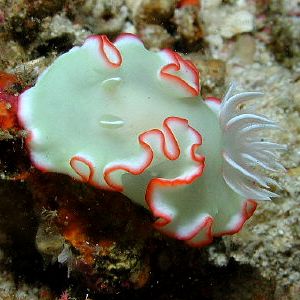 Above [Glossodoris sp. 10](http://www.seaslugforum.net/find/glossp10) 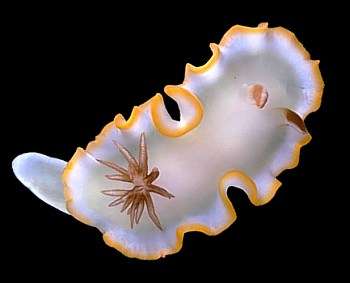 Above [Glossodoris electra](http://www.seaslugforum.net/find/gloselec)  Above [Glossodoris rubroannulata](http://www.seaslugforum.net/find/glosrubr)  Above Glossodoris buko by [Bernard Picton](https://en.wikipedia.org/wiki/File:Glossodoris_buko,_Sangeang,_Indonesia.jpg)
 quinacridone
Now
•
100%
quinacridone
Now
•
100%
Dammit! That's a much better title....why didn't I come up with that?

Main photo by [ilan Lubitz](https://www.flickr.com/photos/128664509@N04/27404312651/) Elysia marginata are Sacoglassons (a type of sea slug) and are found in the Indo-Pacific ocean at depths of 0-10 metres 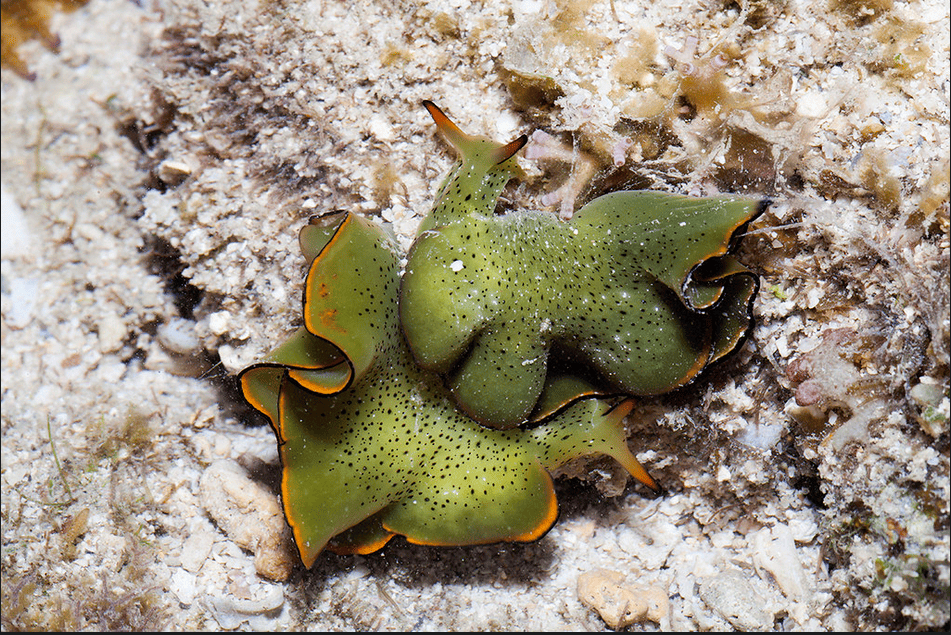 Above photo by [budak](https://www.flickr.com/photos/budak/17110702477/) They eat algae and store the chloroplasts in its body. The chloroplasts continue to photosynthesize and provide its host with a source of food!  Above 'Pair of leaf slugs on algae. They feed on green algae and can grow from 3 to 8cm long. Photo by Wesley Oosthuizen.' [source](https://xray-mag.com/content/leaf-slug-elysia-cf-marginata) They have the ability to regenerate a completely new body (including a new heart) from their head, after it detaches itself from its old body! (A process called [autotomy](https://en.wikipedia.org/wiki/Autotomy)- self amputation) 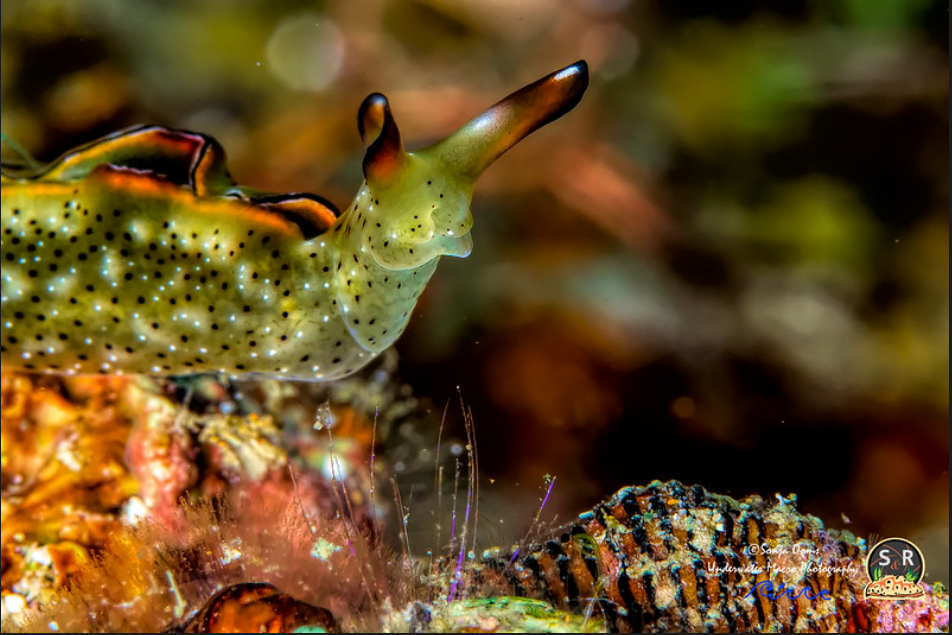 Above photo by [Sonja Ooms](https://www.flickr.com/photos/sonjaooms/51670756457/) Their ability was discovered by Sayaka Mitoh, a doctoral student at Nara Women's University in Japan, who spotted the decapitated head of E. marginata circling its separated body in one of the tanks in the lab 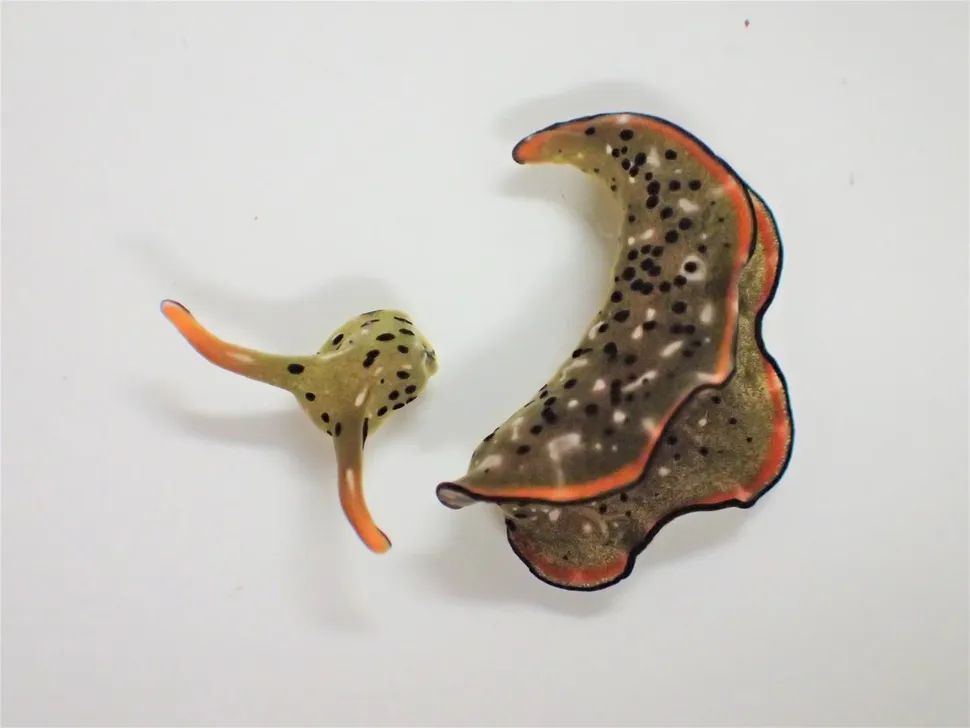 Above 'This image shows the head and the body of Elysia cf. marginata, a day after autotomy.' (Image credit: Sayaka Mitoh) [source](https://www.livescience.com/decapitated-sea-slugs-regrow-entire-body.html) Quite naturally she thought the slug would soon die, however.. >"After a few days, the head started regenerating the body and I could see [the] beating of the heart. It was unbelievable," Mitoh told Live Science. "I was really happy and relieved when I found it could regenerate the body." [source](https://www.livescience.com/decapitated-sea-slugs-regrow-entire-body.html)  [](https://mander.xyz/pictrs/image/8e5bbdb4-7381-47f1-8ccc-64416d7fd0f2.png) - A, Head and body of Elysia cf. marginata, just after autotomy (day 0), with the pericardium (heart) remaining in body section (arrow) - B, day 7 - C, day 14 - D, day 22, showing whole-body regeneration. - E, Head and body of Elysia atroviridis (individual no. 1) just after autotomy (day 0). Above text and photo [source](https://www.cell.com/action/showPdf?pii=S0960-9822%2821%2900047-6) The head continued to grow its new body over the next 3 weeks, including all vital organs, reaching about 80% of its original size! 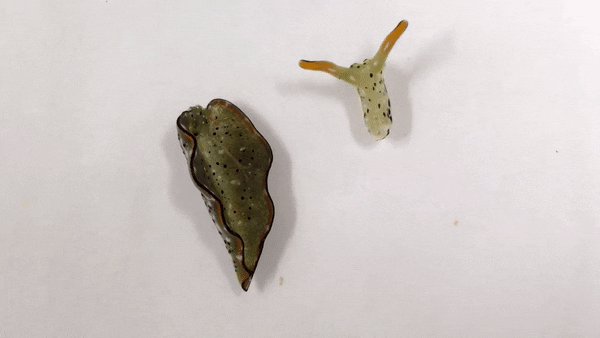 Above gif [source](https://www.scientificamerican.com/article/this-sea-slug-can-chop-off-its-head-and-grow-an-entire-new-body-twice1/) >"The [original] body continues to move and live for days to months," Mitoh said. "You can see the heart beating" inside them, she added. However, the decapitated bodies did not appear to be capable of growing new heads themselves. [source](https://www.livescience.com/decapitated-sea-slugs-regrow-entire-body.html) The old bodies remained active for several days to months, until they started to shrink, turn pale due to the chloroplast loss, and eventually died. The beating heart remained visible until the body had fully decomposed! So, why such an extreme behaviour? In other animals self amputation usually occurs when escaping a predator, however this may not be the case here.... 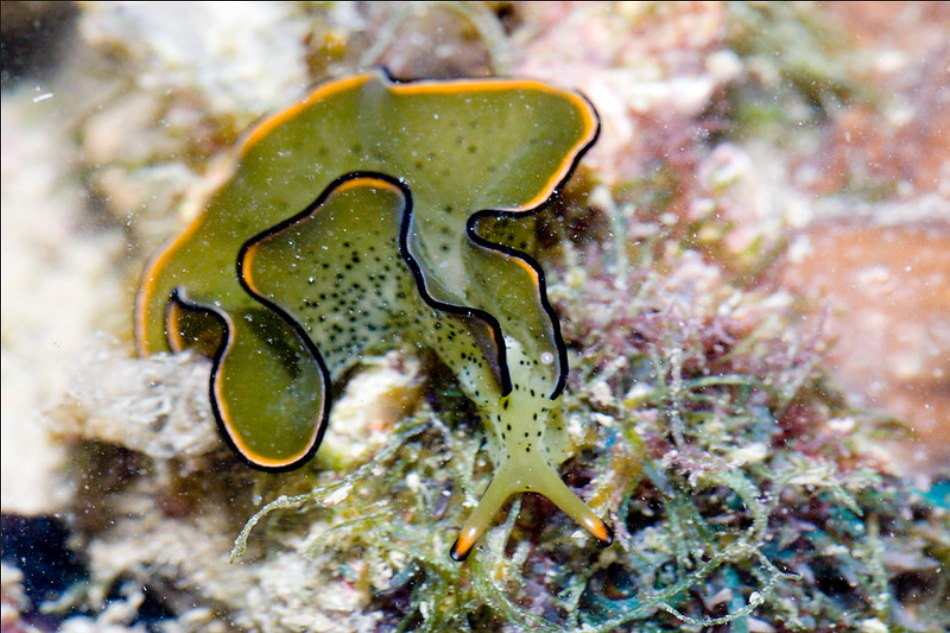 Above photo by [budak](https://www.flickr.com/photos/budak/6910393574/) The head can take several hours to detach from the body, so not exactly a quick get away from a predator Instead it is suspected that it is a means of ridding itself of parasites. There is a slight groove towards the end of the head which acts as a breakage plane, and the similar head severing species Elysia atroviridis all had internal parasites when they detached from their bodies.... However, no parasites were detected in Elysia marginata that did the same..... 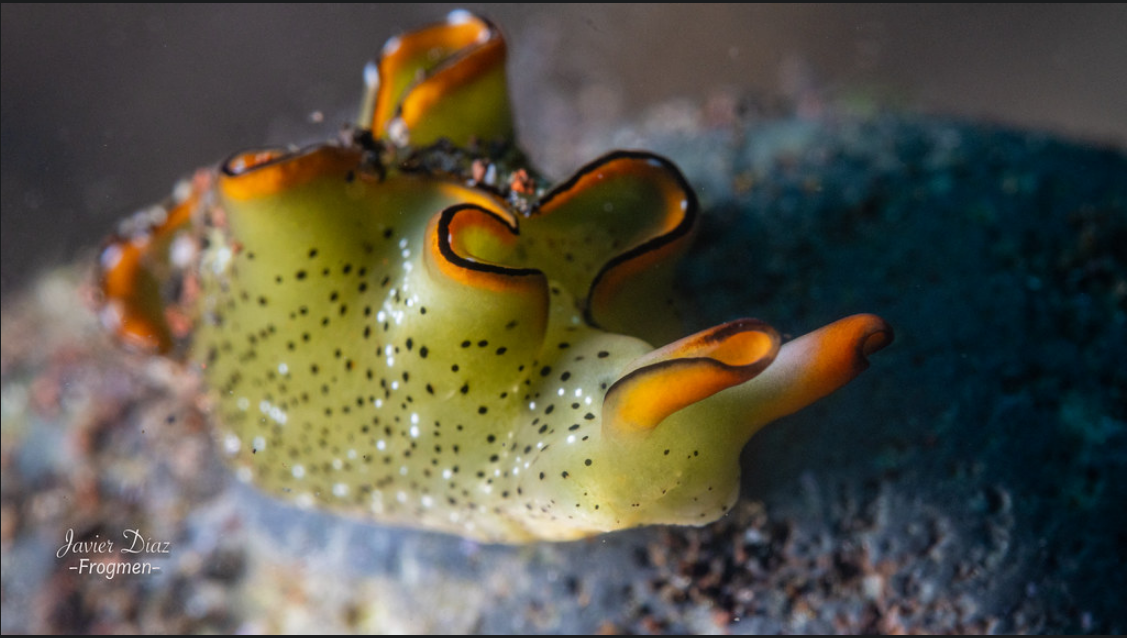 Above photo by [Javier Diaz Frogmen](https://www.flickr.com/photos/170438718@N08/53264901765/) The ingested chloroplasts are thought to help in the regeneration of the new body and keep the head alive in the absence of the digestive system organs (which remain with the body). One individual that was studied underwent autonomy and regeneration twice, which researches think is the limit...(which probably means it didn't survive the third time scientists went to work with a scalpel) Interestingly this behaviour was only exhibited by young Elysia marginata. When older animals were decapitated their heads survived up to 10 days, and didn't regenerate before dying  Above photo by [Antonio Venturelli](https://www.flickr.com/photos/189537291@N05/53395314875/) All information from [wikipedia](https://en.wikipedia.org/wiki/Elysia_marginata), [here](https://www.cell.com/action/showPdf?pii=S0960-9822%2821%2900047-6), [here](https://www.livescience.com/decapitated-sea-slugs-regrow-entire-body.html), [here](https://xray-mag.com/content/leaf-slug-elysia-cf-marginata), [here](https://www.scientificamerican.com/article/this-sea-slug-can-chop-off-its-head-and-grow-an-entire-new-body-twice1/), [here](https://www.sciencenews.org/article/sea-slug-detached-head-crawl-regenerate-grow-new-body) and [here](https://www.nytimes.com/2021/03/08/science/decapitated-sea-slugs.html) As always I'm not an expert, any errors let me know in the comments and I'll edit And I shall leave you all with a reprise of my current favourite gif.... 
 quinacridone
Now
•
100%
quinacridone
Now
•
100%
You're welcome!
I had no idea they existed, coming across them by accident while looking for something else.... I was particularly delighted by their crab jockeys
 quinacridone
Now
•
100%
quinacridone
Now
•
100%
A valuable skill!

Main photo by [Ocean Networks Canada](https://www.flickr.com/photos/oceannetworkscanada/9678458149/) 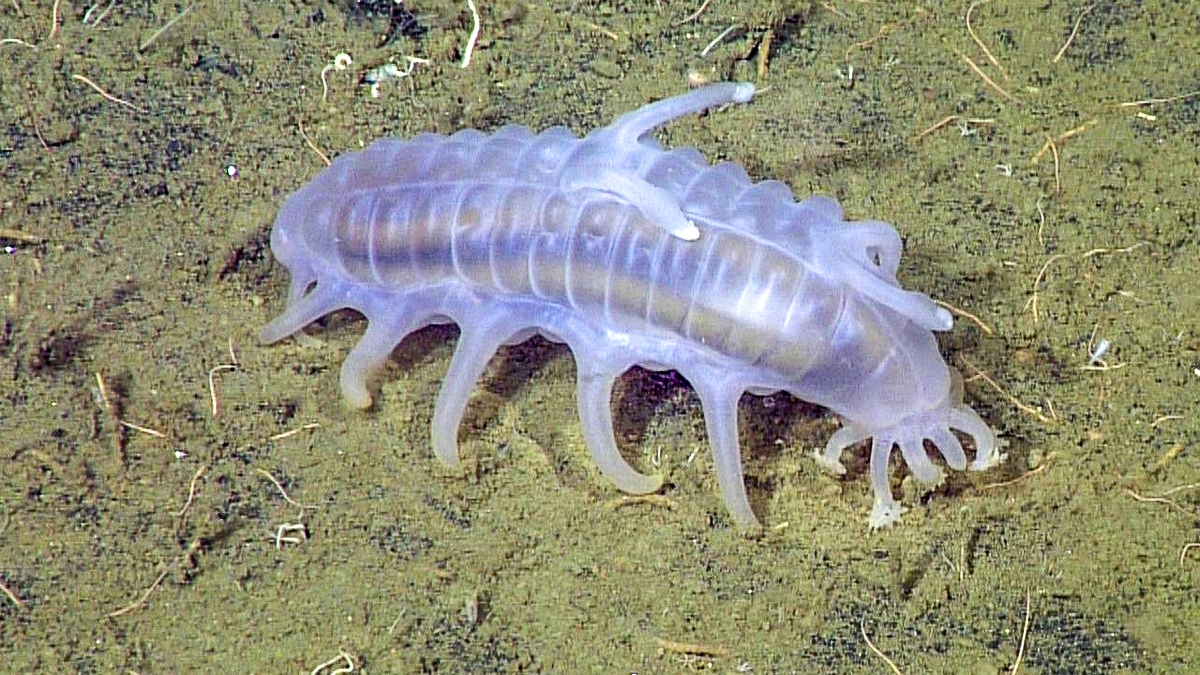 Above photo via [MBARI](https://www.mbari.org/animal/sea-pig/) Sea Pigs (Scotoplanes) are a type of Sea Cucumber They live in the deep sea, specifically on the abyssal plain up to depths of 5000m They can grow up to 4-6 inches They have 6 pairs of enlarged tubal 'feet', and use water cavities in their bodies to inflate and deflate them in order to move around, as well as ten buccal tentacles lining their oral cavity 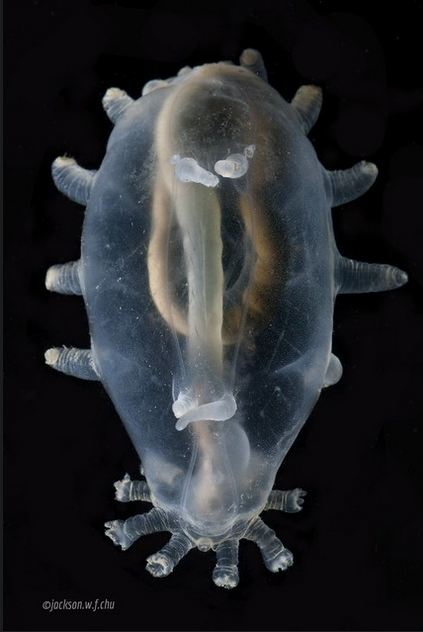 Above photo via [Ocean Networks Canada](https://www.flickr.com/photos/oceannetworkscanada/9775853991/in/album-72157635258422453/) They live on the sea floor feeding on delicious foods such as decaying animals, poo and mucus! If they are disturbed they can swim! In fact some Sea Pigs spend most of their lives swimming around in the water column using their frontal and anal lobes to propel themselves around! They will gather in large numbers around whale corpses to feed and perhaps find a mate  Above, a congregation of Sea Pigs feeding on a whale carcass via [MBARI](https://www.mbari.org/animal/sea-pig/) Their reproductive system is unique, the males only have one testis, and the females one ovary! Also their skin contains a toxin called holothurin which is poisonous to predators... They have a poorly defined respiratory system, and have to breathe through their anus! 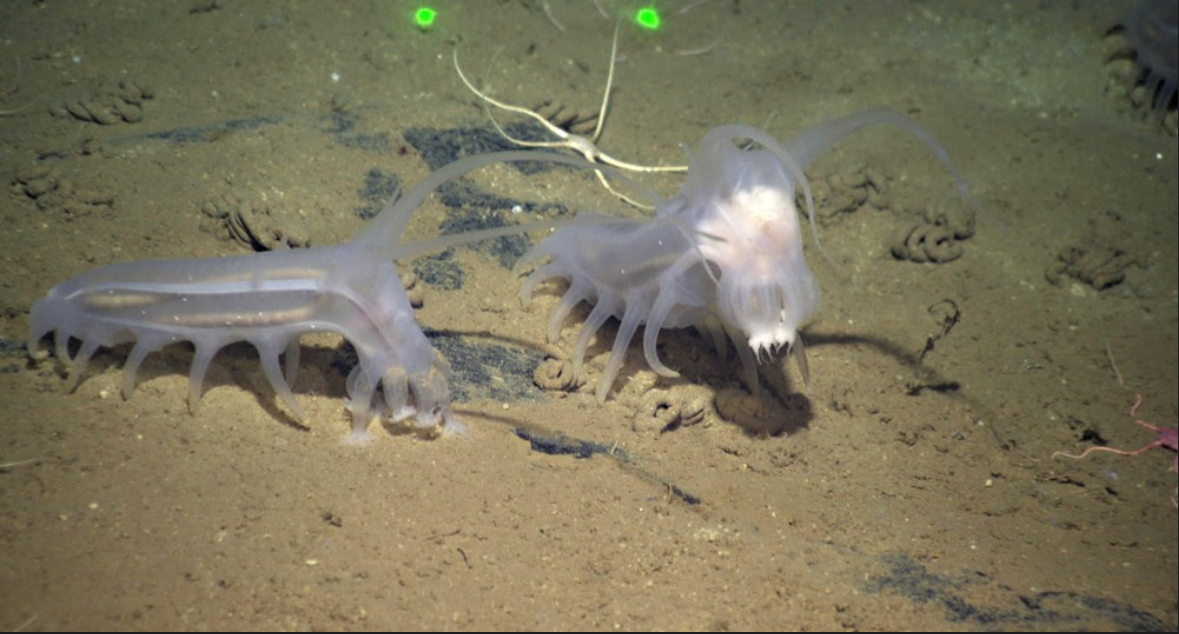 Above photo by Oceans Network Canada via [Treehugger](https://www.treehugger.com/sea-pigs-facts-4864441) As they have evolved at deep sea depths they would swell and burst if brought to the surface They are hosts to several parasitic invertebrates, including snails and small crustaceans But wait! What's this...? 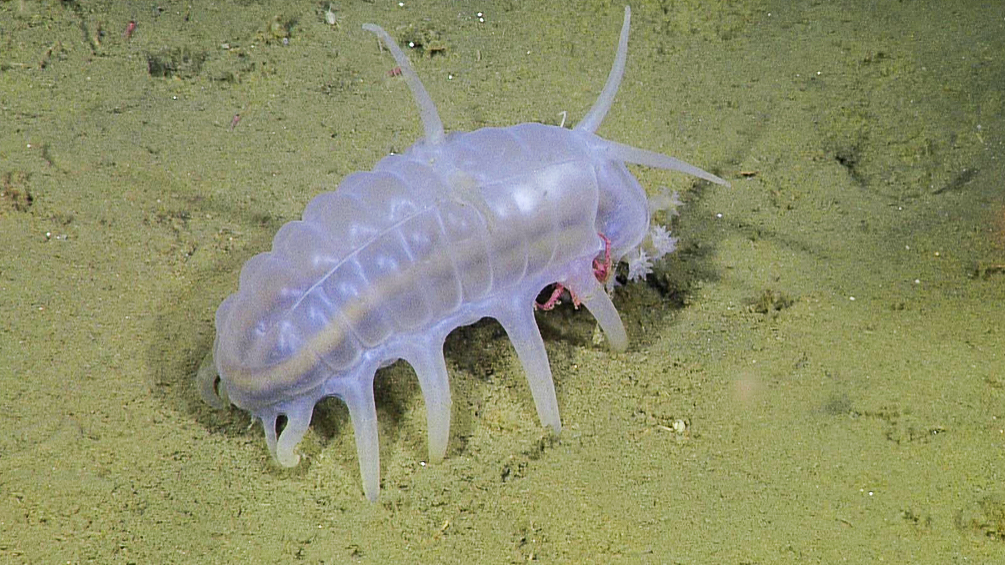 Above Above photo via [MBARI](https://www.mbari.org/animal/sea-pig/) What's that red thing hiding under the Sea Pig? 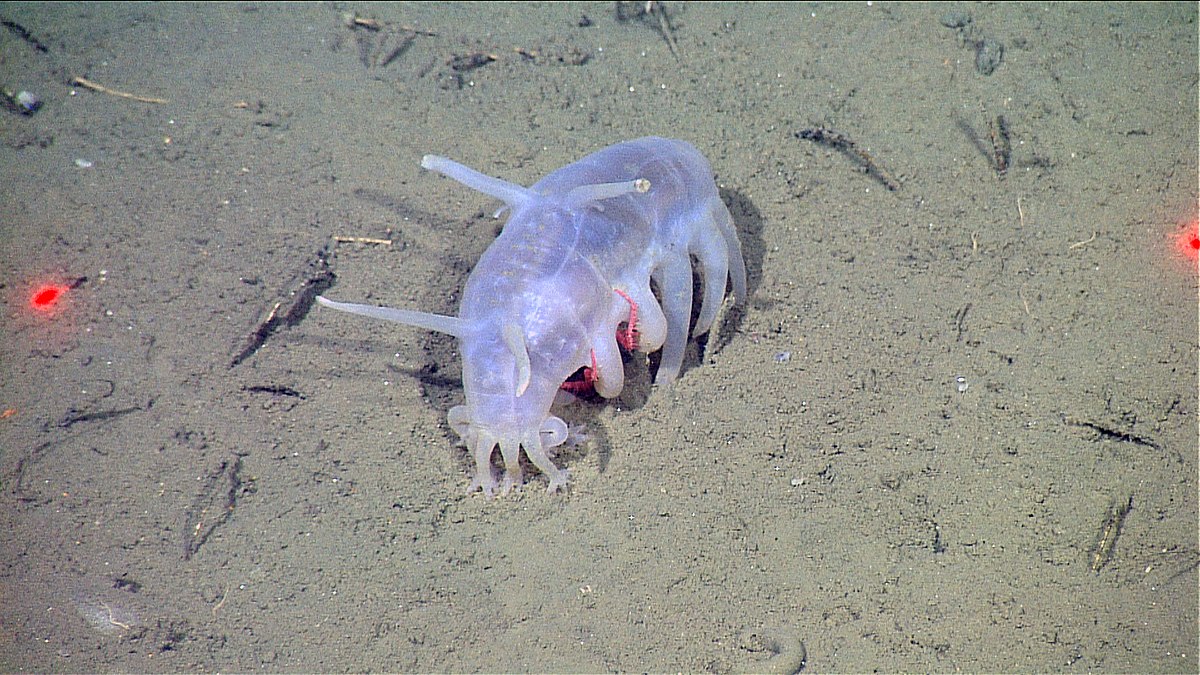 Above photo via [wikipedia](https://en.wikipedia.org/wiki/File:Scotoplanes_globosa_and_crab.jpg) It's a King Crab!  Above photo via [MBARI](https://www.mbari.org/animal/sea-pig/) Peek-a-boo! 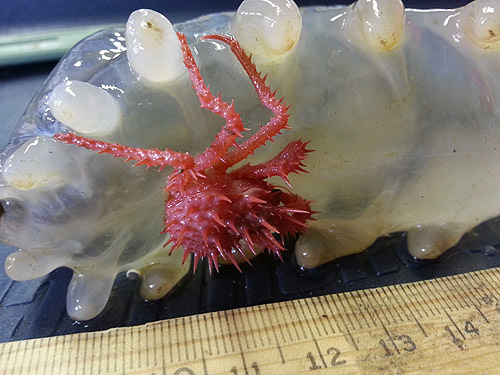 Above photo by Josi Taylor via [MBARI](https://www.mbari.org/news/young-king-crabs-found-hitchhiking-on-sea-pigs/) Why do King Crabs ride on Sea Pigs? Usually King Crabs like to hide in rocks and seaweed from predators, but it is thought that these King Crabs were carried by the ocean current while they were small larvae and ended up in the deep sea....an area devoid of such hiding places! >“It’s like looking for a port in the storm,” said James Barry, ecologist and lead author of the study at the Monterey Bay Aquarium Research Institute (MBARI) in Moss landing. Sea cucumbers are the ports or the biggest buildings to hide next to in an otherwise empty area.” [Scientific American](https://www.scientificamerican.com/blog/guest-blog/why-are-juvenile-crabs-hitching-rides-on-sea-pigs/) 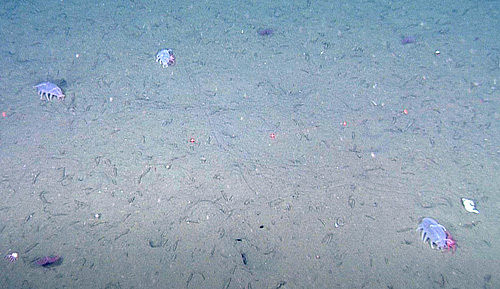 Above, ' This photograph of the muddy seafloor offshore of Monterey Bay shows three Scotoplanes sea cucumbers, at least two of which are host to juvenile king crabs.' [MBARI](https://www.mbari.org/news/young-king-crabs-found-hitchhiking-on-sea-pigs/) >Barry and his team found a total of 600 juvenile crabs, 96 percent of which were either clinging onto sea cucumbers or hanging around right next to them. Sometimes the crabs were upside down holding onto the belly of the sea pig and other times they were crawling on its side. In some cases, the researchers found more than one crab on a sea cucumber. Of the nearly 2,600 sea cucumbers videotaped, 22 percent had at least one juvenile crab clinging to them Goodbye Sea Pig, and your King Crab jockey! 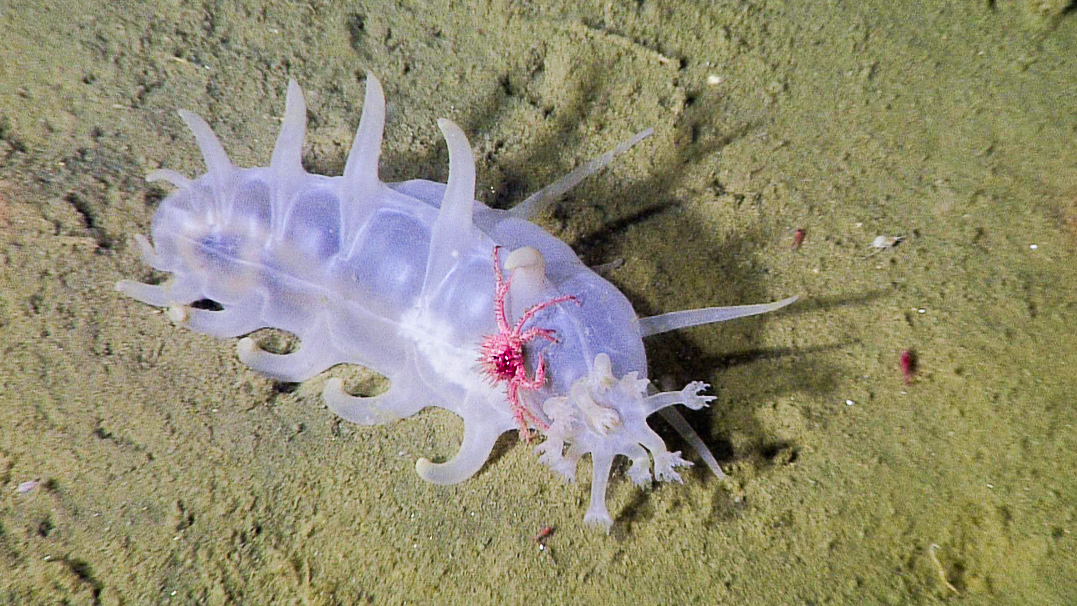 Above photo via [MBARI](https://www.mbari.org/animal/sea-pig/) edit- I completely forgot to add my sources.....[wikipedia](https://en.wikipedia.org/wiki/Scotoplanes) and [MBARI](https://www.mbari.org/news/young-king-crabs-found-hitchhiking-on-sea-pigs/), unless specified
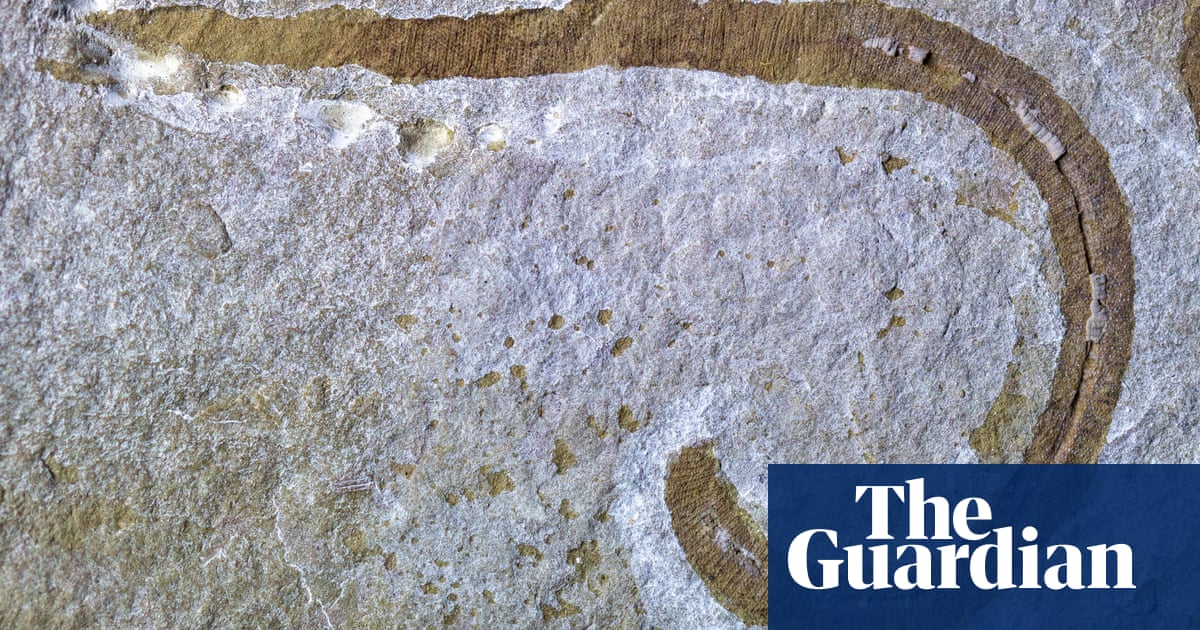 www.theguardian.com
www.theguardian.com
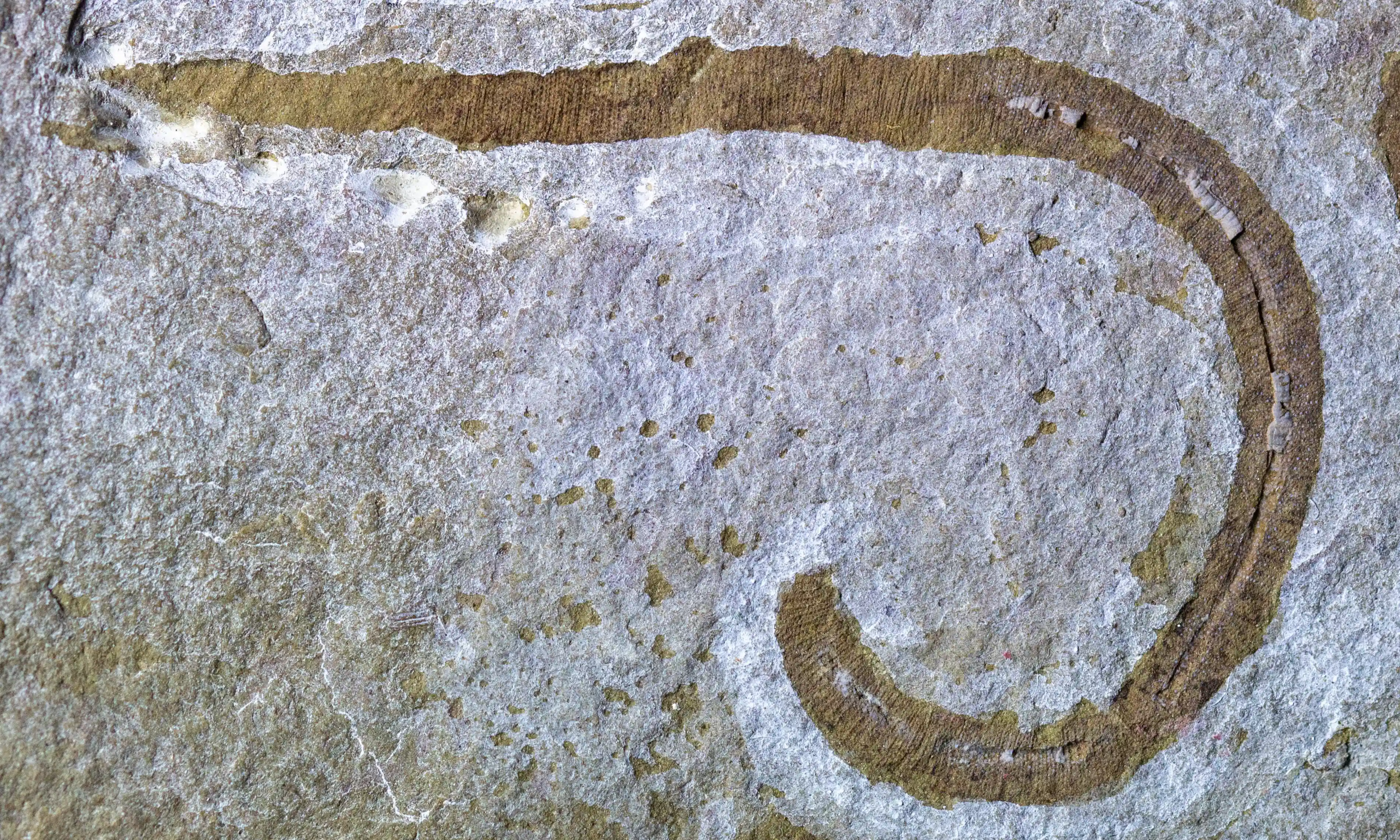 >Remnants of prehistoric worm Radnorscolex latus, unearthed in Herefordshire. Photograph: Richie Howard/Luke Parry/National History Museum/PA > > >An ancient worm unearthed in Herefordshire was a carnivorous predator that shoved its throat out to catch and eat prey, according to scientists. > >The creature, named Radnorscolex latus, was found at a disused Victorian quarry site in the village of Leintwardine, near the Welsh border. > >This marine worm is believed to have lived on the ocean floor about 425m years ago, when the region was under water. Analysis suggests it had a retractable throat that could extend out on to the seabed to capture prey hidden within the sediment. > >According to Dr Richie Howard, curator of fossil arthropods at the [Natural History Museum,](https://www.theguardian.com/culture/natural-history-museum) Radnorscolex is reminiscent of giant worms in the Hollywood blockbuster Dune. > >Howard said: “We think they weren’t too picky when it came to feeding and likely just shoved their throat out into the mud and grabbed anything they could find. > >“They certainly make you think of the sandworms in Dune in that respect.” > >Although fossil remains of Radnorscolex were first discovered a century ago, the technology was not advanced enough to allow palaeontologists to examine these in great detail. > >Experts from the Natural History Museum in London used state-of-the-art imaging techniques to analyse the remnants. > >Findings showed Radnorscolex had rows of sharp teeth and hooks on its head, which it would have used to anchor itself to the ground and drag its body forward to move. > >Despite being a predator, analysis suggests the creature only grew to be about 8cm long. > >The researchers said Radnorscolex belongs to a group of extinct worm-like animals known as Palaeoscolecids, which were wiped out completely about 400m years ago due to rapid climate and sea level change. > >The findings are published in the journal Papers in [Palaeontology.](https://www.theguardian.com/science/palaeontology) Image and text from the original article in [The Guardian](https://www.theguardian.com/science/article/2024/may/23/remnants-of-prehistoric-marine-worm-unearthed-in-herefordshire)

Main photo, Halgerda batangas by [Gerhard Batz](https://www.flickr.com/photos/tzab/53645290225/in/pool-nudibranch/) Firstly, the vast majority of photos are taken at depth so it's probably a good idea to be able to scuba dive.....and also most nudibranchs tend to look like this without the use of special lighting set ups 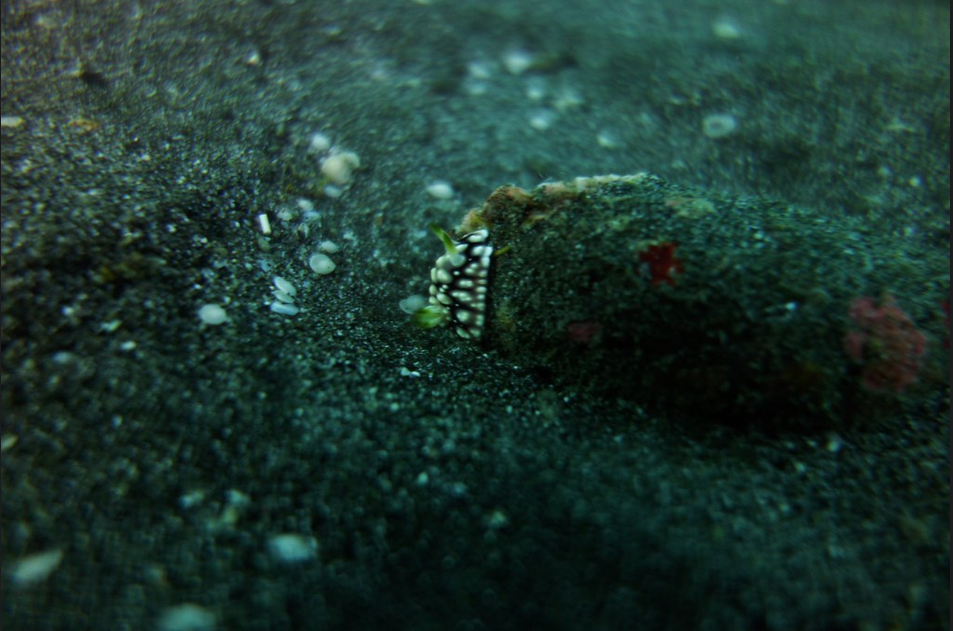 Above, by [McChuckerson](https://www.flickr.com/photos/chuckneerg/10528816773/) 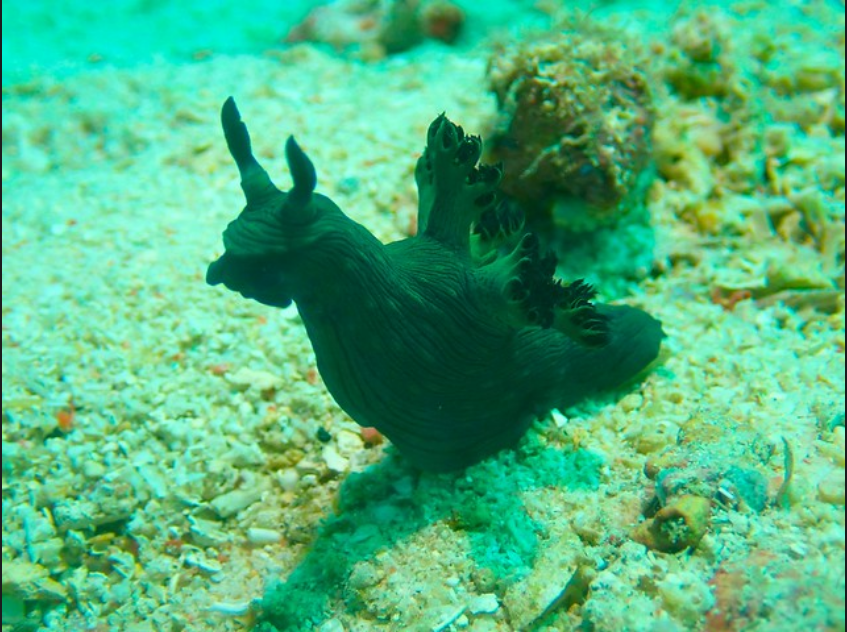 Above by [Go Zilla](https://www.flickr.com/photos/154290520@N02/53617585332/in/pool-nudibranch/) (Please note, I'm not criticizing or taking the piss out of these photos or the photographers, I just want to show how nudis look under normal lighting) A lot of nudi photos have black backgrounds which are created by using a strobe lighting set up configured like this... 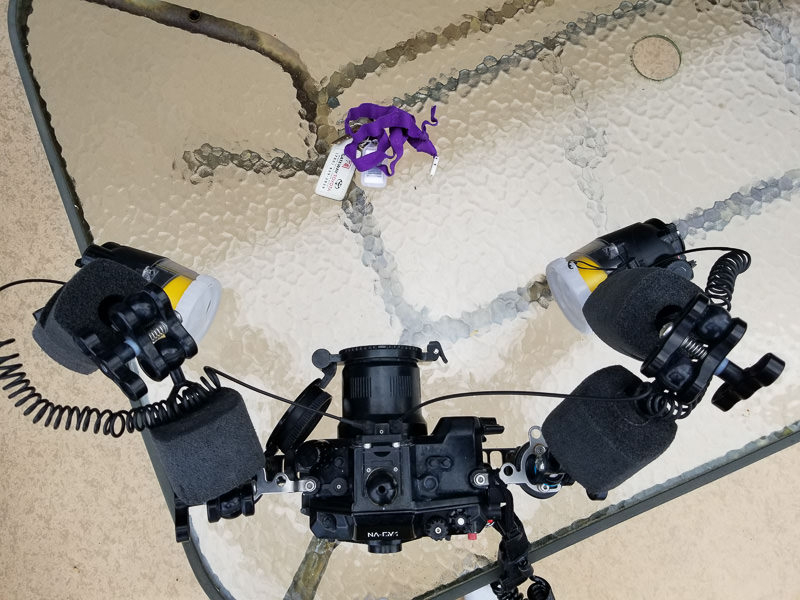 [Above](https://www.uwphotographyguide.com/black-background-strobe-positioning), 'This is how... (Bryan Chus) setup looks to get a successful test shot on land, using my 60mm macro lens (120 mm full frame equivalent).' 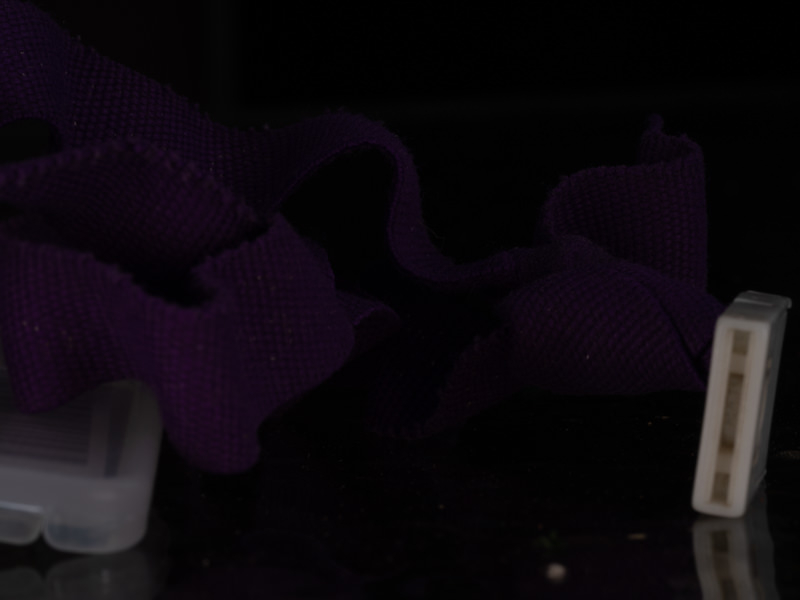 [Above](https://www.uwphotographyguide.com/black-background-strobe-positioning), 'Non-lit test subject using black background settings (1/320 sec, f/14, ISO 100).'  [Above](https://www.uwphotographyguide.com/black-background-strobe-positioning), 'Properly lit test subject with inward facing strobes.' The photos give results like these... 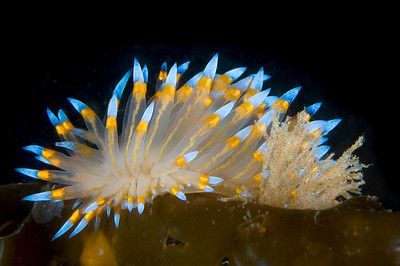 Above, [Janolus nudibranch](https://www.uwphotographyguide.com/black-backgrounds) 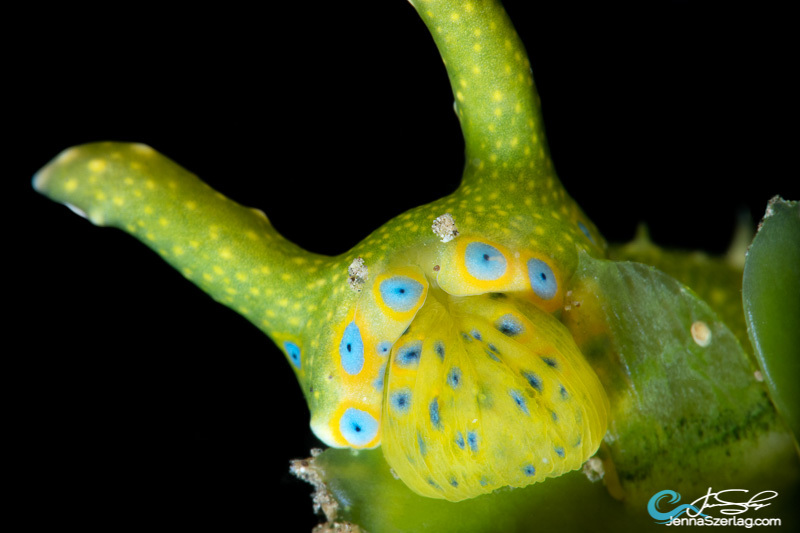 Above, 'Oxynoe jordani feeds on Caulerpa taxilfolia Canon 5DSr 100mm Lens ISO100 1/250 f/25' by [Jenna Szerlag](https://www.uwphotographyguide.com/nudibranchs#Tips)  Above by [Andrey torchuck](https://www.flickr.com/photos/157623318@N06/27714219759/) Of course there's slightly more to getting an amazing photograph than just having the right set up.... Composition, highlighting natural features, symmetry, depth of field, background contrast, animal behaviour all play their role  [Above](https://www.uwphotographyguide.com/essential-tips-nudibranch-photography), 'Showing nudibranch symmetry works well, like with this shot of a Nebrotha kuberyani. [Mike Bartick] particularly like[s] to shoot these guys because of their interesting facial features, texture and vibrant colors.' 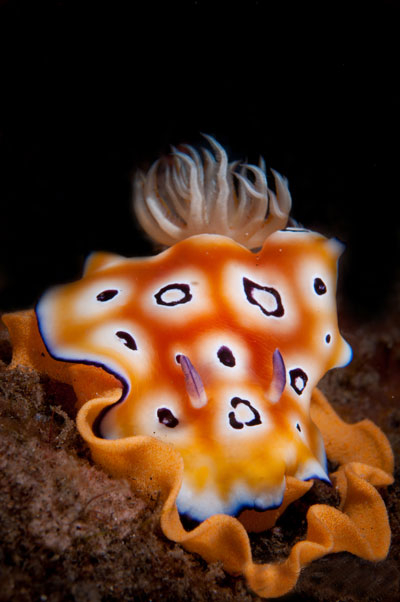 [Above](https://www.uwphotographyguide.com/essential-tips-nudibranch-photography), 'Chromodoris leopardis. Laying eggs is always a very interesting behavior to capture. The eggs are often brightly colored and textured. If eggs are found alone, inspect them, as other nudibranchs often feed on them.' 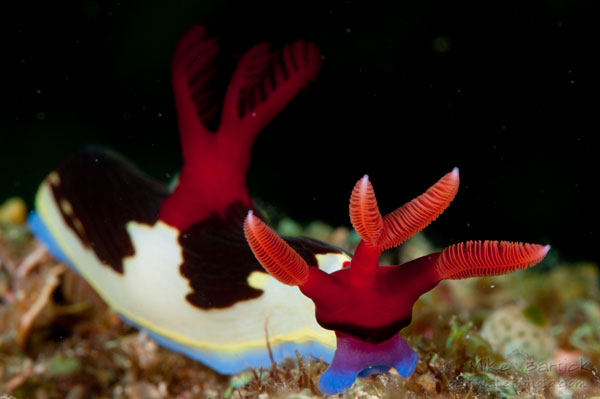 [Above](https://www.uwphotographyguide.com/essential-tips-nudibranch-photography), 'Nembrotha chamberlaini. If there is an anomaly of some sorts that sets your subject apart for the norm be sure that this anomaly is the center of the viewers’ attention.' 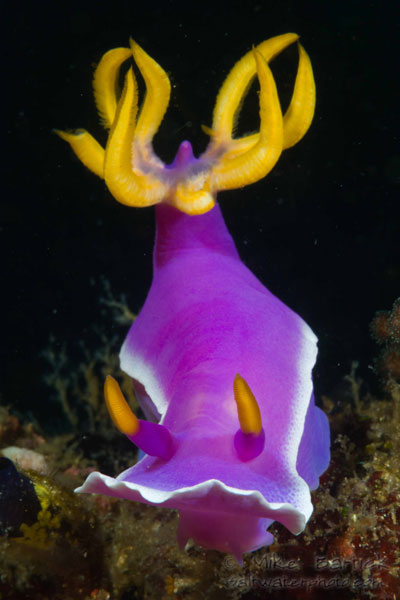 [Above](https://www.uwphotographyguide.com/essential-tips-nudibranch-photography), 'Extreme depth of field isn’t always necessary, but on a larger subject its hard to resist, especially when one is as colorful as this Hypseledoris. Backing away from your subject is an easy way to slightly increase your DOF when working with nudibranchs.' 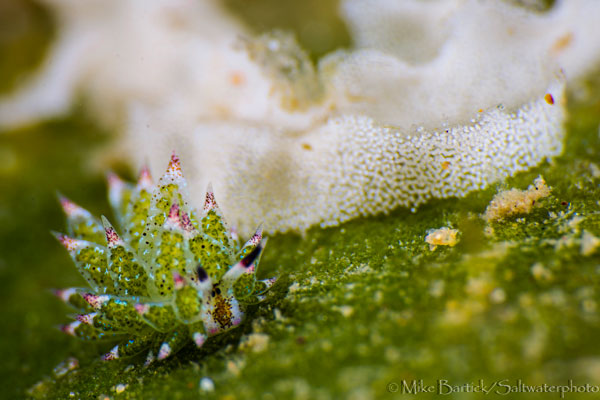 [Above](https://www.uwphotographyguide.com/essential-tips-nudibranch-photography), 'Using a quality diopter of +10 or greater will dramatically increase the size of very small subjects and allow you to fill the frame with very little cropping. These Castosiella kuroshimae are miniscule and nearly impossible to detect. Look on small algae on sandy dive sites.' 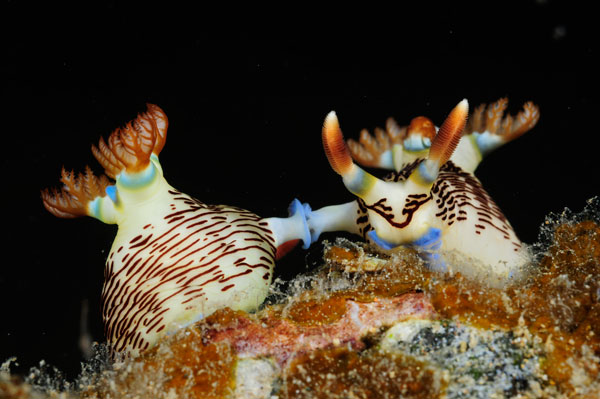 [Above](https://www.uwphotographyguide.com/essential-tips-nudibranch-photography), 'Nembrotha lineota. Get low, get close and shoot up. Use negative space and be sure your subject's Rhinophores are sharp.' 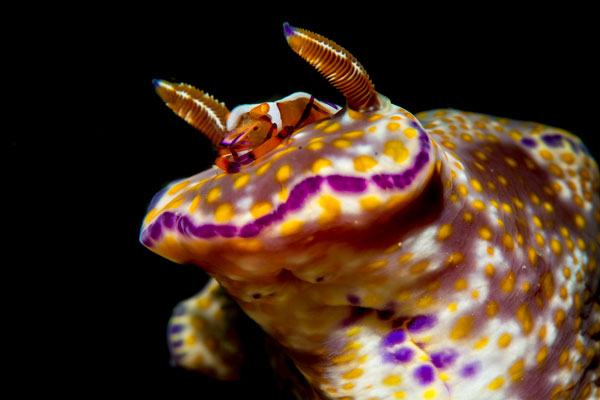 [Above](https://www.uwphotographyguide.com/essential-tips-nudibranch-photography), 'Miamira tenue aka Ceratasoma tenue can grow to impressive sizes. Some are large enough to sport accessories like this emperor shrimp that lives a symbiotic lifestyle with its host. Keeping its hosts gills cleaned and rummaging for food as the nudi moves along the substrate is priority number 1 for the shrimp, and getting photos of them on the nudi are great behavioral images.' 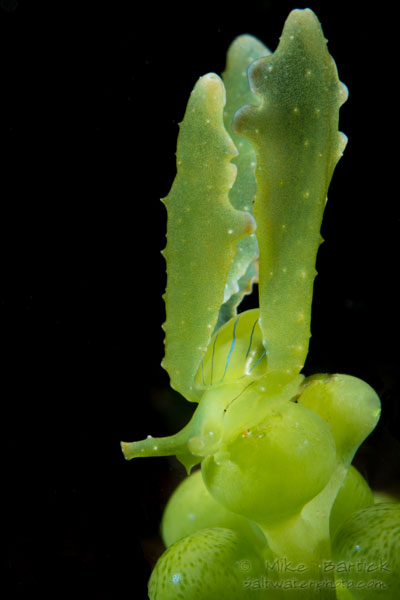 [Above](https://www.uwphotographyguide.com/essential-tips-nudibranch-photography), 'Mimicry is another behavior that an entire article could be written about, especially with these amazing Lobiger sp. Sap suckers live on algae that resembles green grapes. This image was shot in very shallow water in broad daylight. Using a high shutter speed will enable you to control the incoming light, even on the sunniest days. When a subject is tall, try turning your camera to the portrait position.' 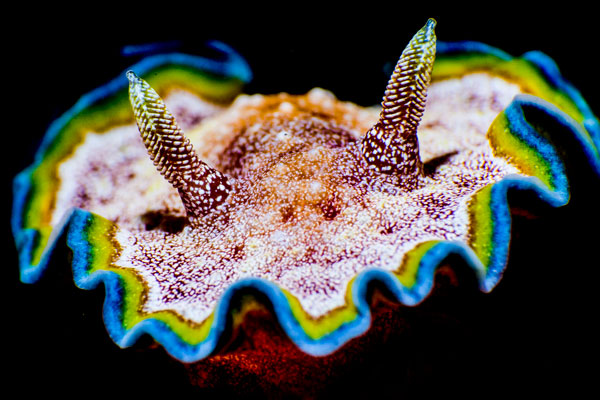 [Above](https://www.uwphotographyguide.com/essential-tips-nudibranch-photography), 'Glossodoris cincta. These larger nudis will fill your frame easily with or without a diopter. Paying close attention to the camber of your subject's Rhinophores will help with head-on composition. The gills of the cincta actually vibrate as they move and are fun to watch.' Not all photographers use black backgrounds for their photos and the results are just as beautiful.... 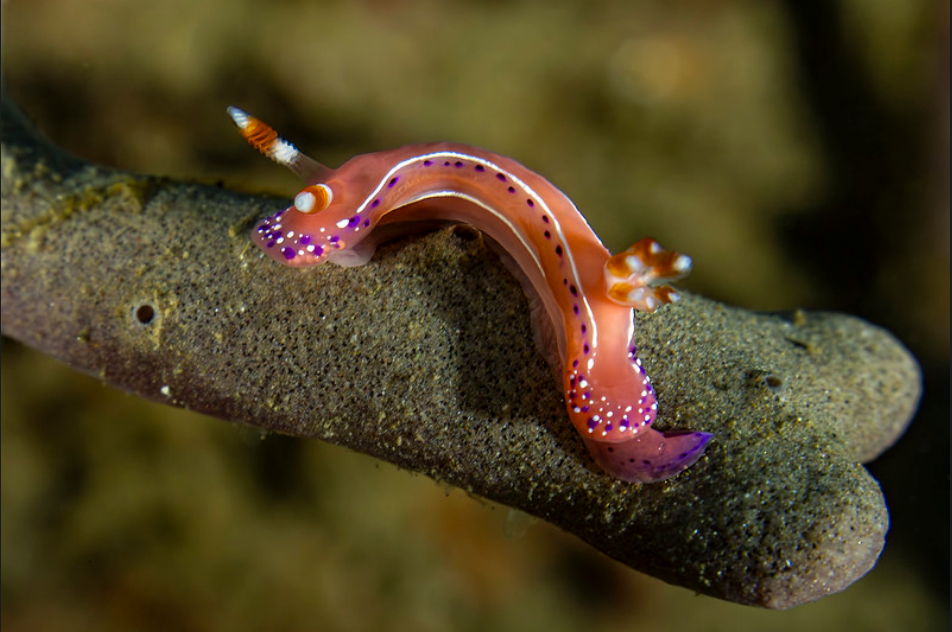 Above photo Thorunna australis, by [elebe.foto](https://www.flickr.com/photos/104413886@N07/53564993788/in/pool-nudibranch/) 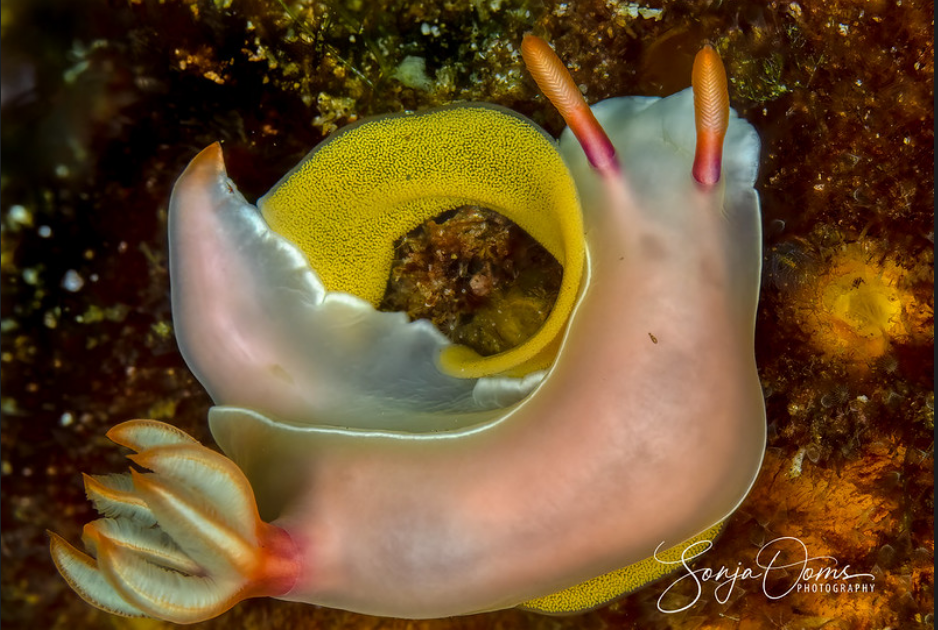 Above photo Hypselodoris bullockii laying eggs by [Sonja Ooms](https://www.flickr.com/photos/sonjaooms/52267864862/) 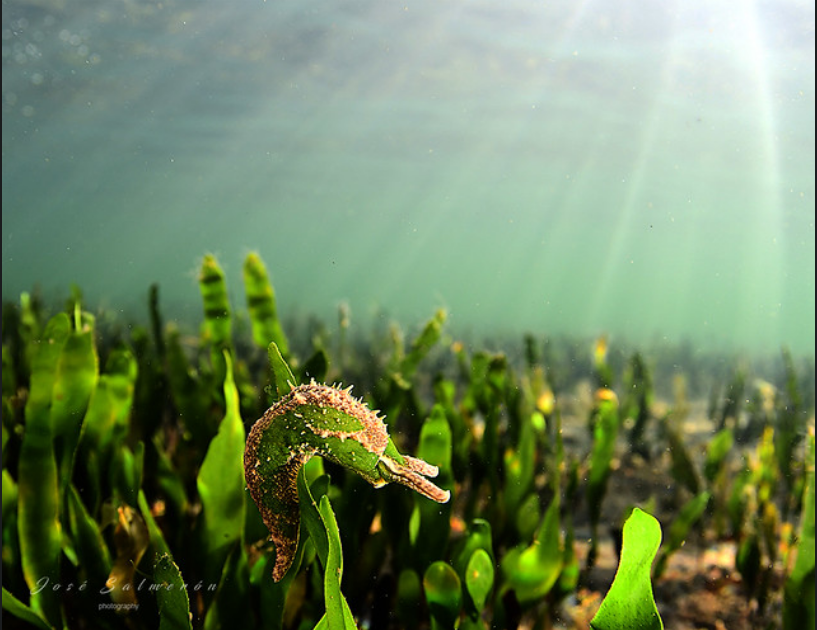 Above photo of Oxynoe olivacea by [Jose Salmerón](https://www.flickr.com/photos/salmeroncasanova/53276135934/in/pool-nudibranch/) 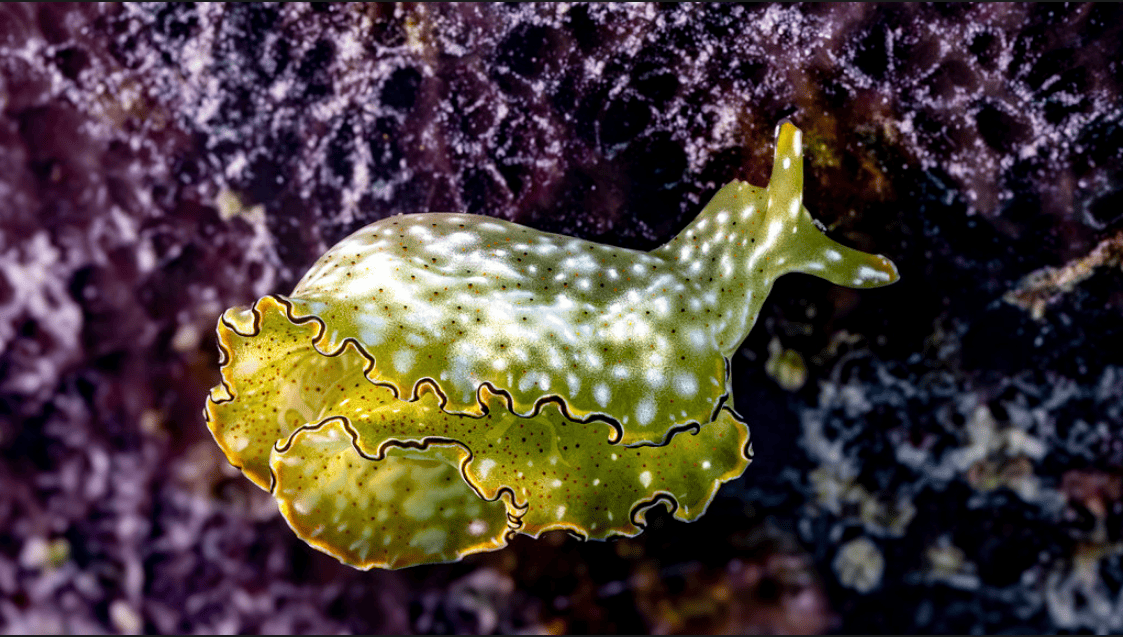 Beautiful photo that pops with contasting colours of Elysia marginata by [elebe.foto](https://www.flickr.com/photos/104413886@N07/53565177396/in/pool-nudibranch/) And also lets not forget the role of the computer in adding the final touches to a well composed and well lit photograph Some photos may need a bit of work to either remove debris in the foreground or background that distract from the main focus point... Others need work in making them pop more. Of course images can suffer through too much retouching, and also no amount of photoshop can save a poorly composed image....both sides of the debate are discussed [here](https://www.scubadiving.com/keywords/underwater-photography/ask-expert-are-we-using-too-much-photoshop-underwater-photography) 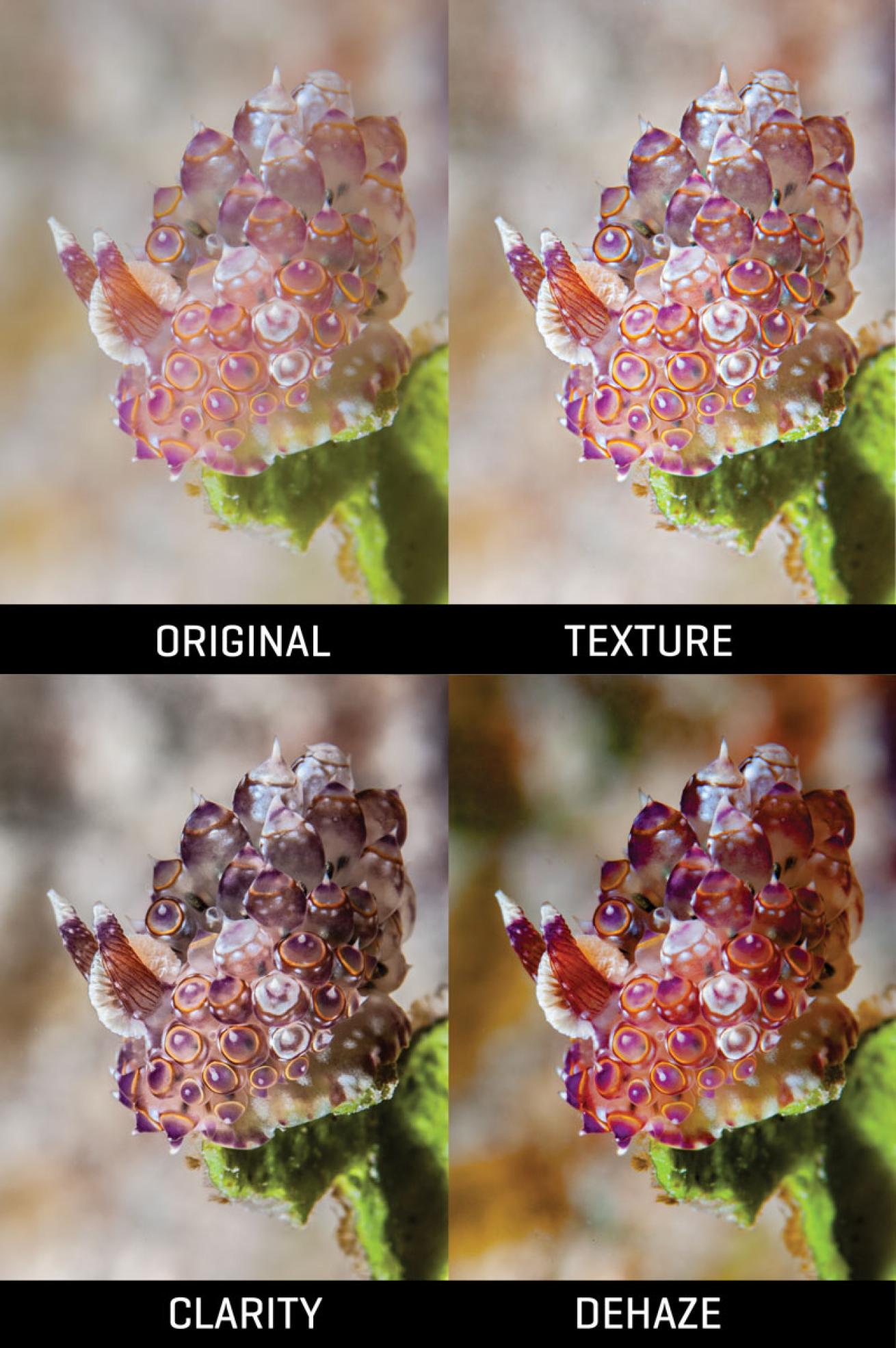 [Above](https://www.scubadiving.com/how-to-use-texture-slider-in-lightroom), 'Here's how to make Texture, Clarity and Dehaze work for you.' photo by Erin Quigley And finally a Super Pro photo by David Hall, below 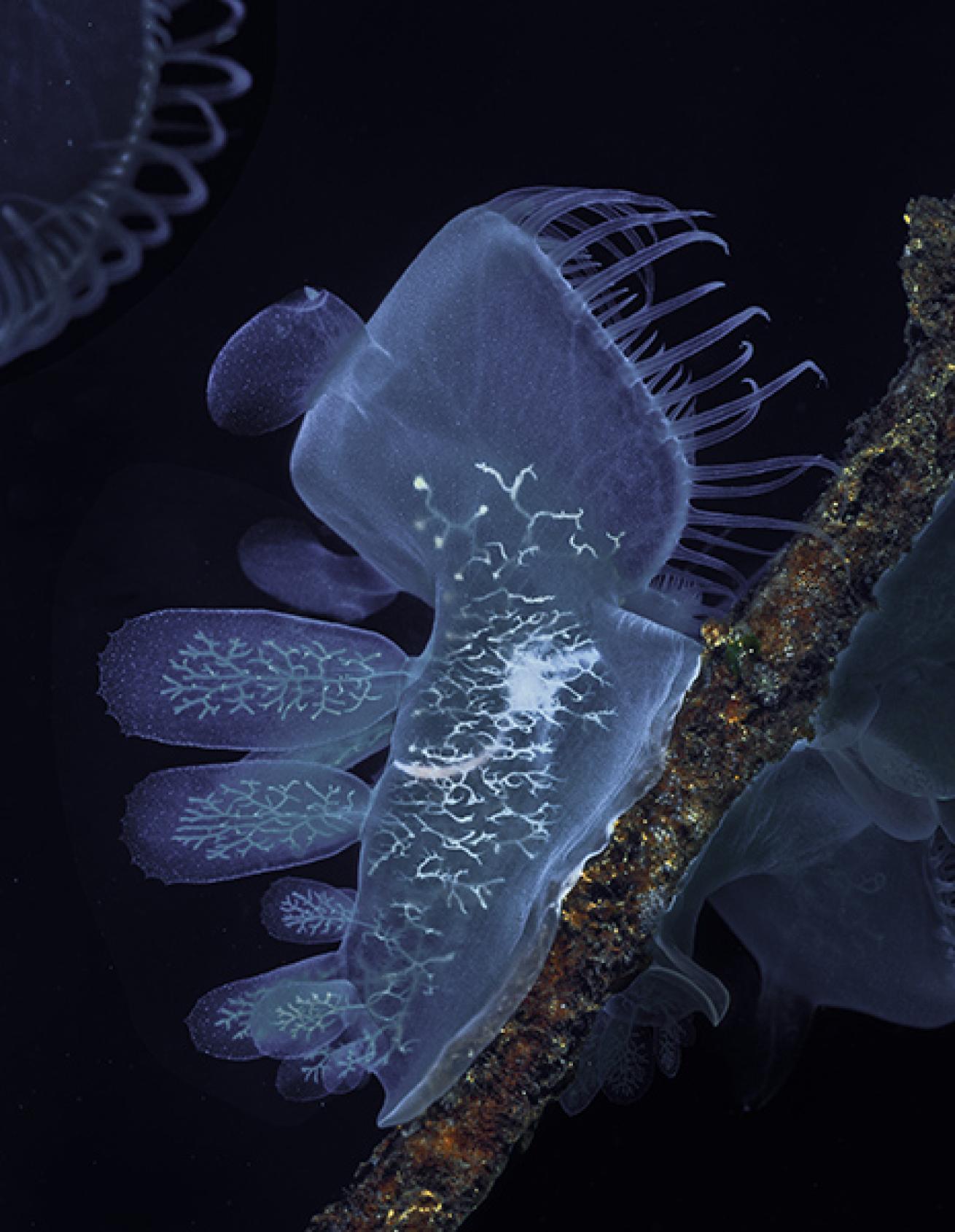 >"Imagine a bull kelp forest in which the plants are completely covered with ghostlike animals expanding and contracting rhythmically,” photographer David Hall writes of shooting the hooded nudibranch, Melibe leonine, for his award-winning book Beneath Cold Seas: The Underwater Wilderness of the Pacific Northwest. > >HOW HE GOT THE SHOT Hall used a Nikonos RS camera with a 50mm lens, two Ikelite SS-50 strobes and Fujichrome Velvia 50 film. Hooded nudibranchs are transparent, like jellyfish, and correct exposure can be difficult to estimate, so Hall bracketed the exposure generously. [here](https://www.scubadiving.com/look-hooded-nudibranch) All information from [here](https://www.uwphotographyguide.com/nudibranchs) and [here](https://www.uwphotographyguide.com/essential-tips-nudibranch-photography), unless otherwise stated As always I'm not an expert, and certainly not one in underwater photography (I'm still trying to get to grips with terrestrial photography)
 quinacridone
Now
•
100%
quinacridone
Now
•
100%
You're welcome, also do checkout the other underwater photos he has, they're full of beautiful things 👍

Main photo 'A giant dendronotid nudibranch swimming in mid-water'  Above, 'The opalescent nudibranch is a predatory mollusk with no shell'  Above, 'Hooded Nudibranchs on Kelp' 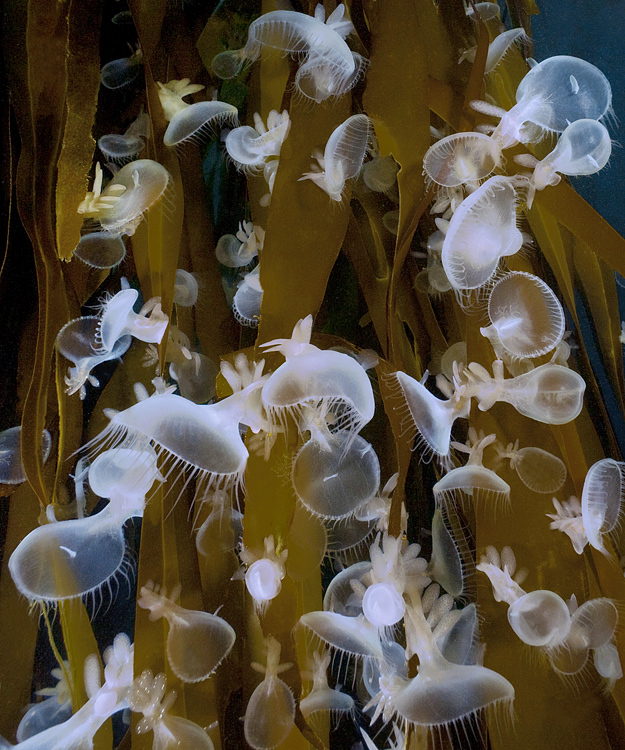 Above, 'Hooded Nudibranchs'  Above, 'Hooded Nudibranch, Melibe leonina - British Columbia, Canada'  Above, 'Opalescent nudibranchs and ascidians'  Above, 'Sea Lemon Nudibranch, Anisodoris nobilis - British Columbia, Canada' 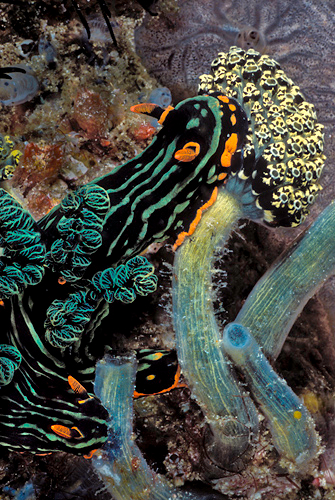 Above, 'Nudibranchs (Nembrotha kubaryana) feeding on stalked ascidians. All nudibranchs are carnivorous, mostly preying upon sessile invertebrates such as ascidians, sponges, bryozoans and cnidarians (hydroids, corals, anemones). (Komodo, Indonesia) (photo: Gayle Jamison)' 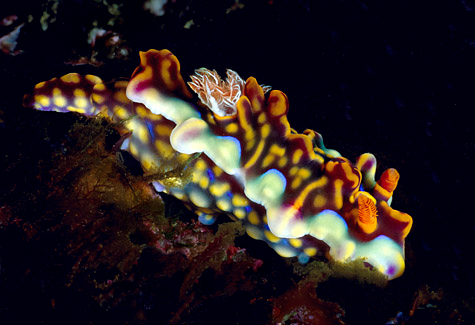 Above, 'Nudibranch, Miamira magnifica - Izu, Japan'  Above, 'Hypselodoris infucata; Lembeh Strait, Indonesia' Selected underwater photography [here](https://www.seaphotos.com/bc/), more [nudibranchs](https://www.seaphotos.com/nudibranchs.html#), and his [books](https://www.seaphotos.com/beneathcoldseas/)

Title photo by [Doug Anderson](https://www.flickr.com/photos/douga/6328729772/) More photos of Emperor shrimp (Periclimenes imperator) riding on various nudibranch hosts... Solo riding.... 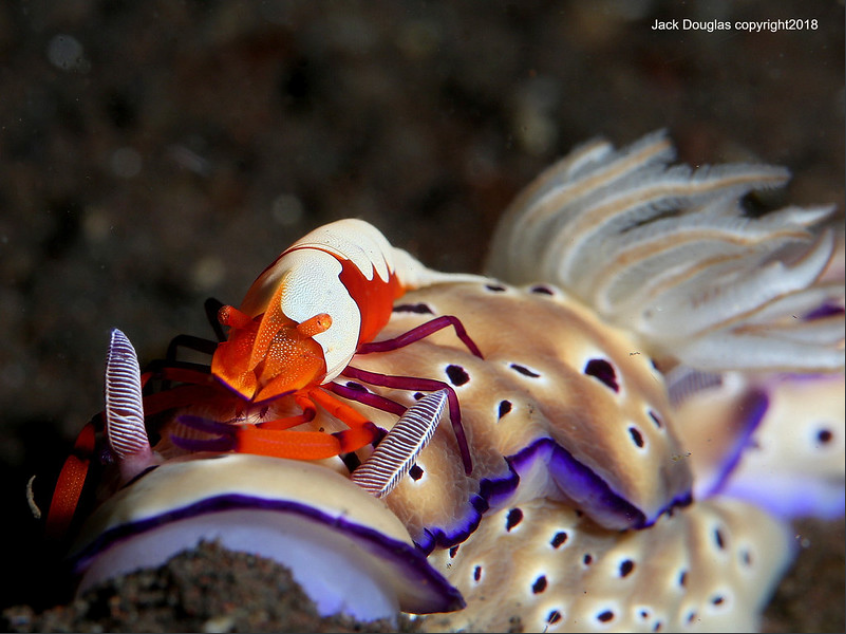 Above photo of Ceratosoma trilobatum, by [Jack](https://www.flickr.com/photos/11016640@N07/42003318874/) .....or with a pal....  Above photo of Ceratosoma trilobatum, by [Jack](https://www.flickr.com/photos/11016640@N07/42003319384/) ...Tandem.... 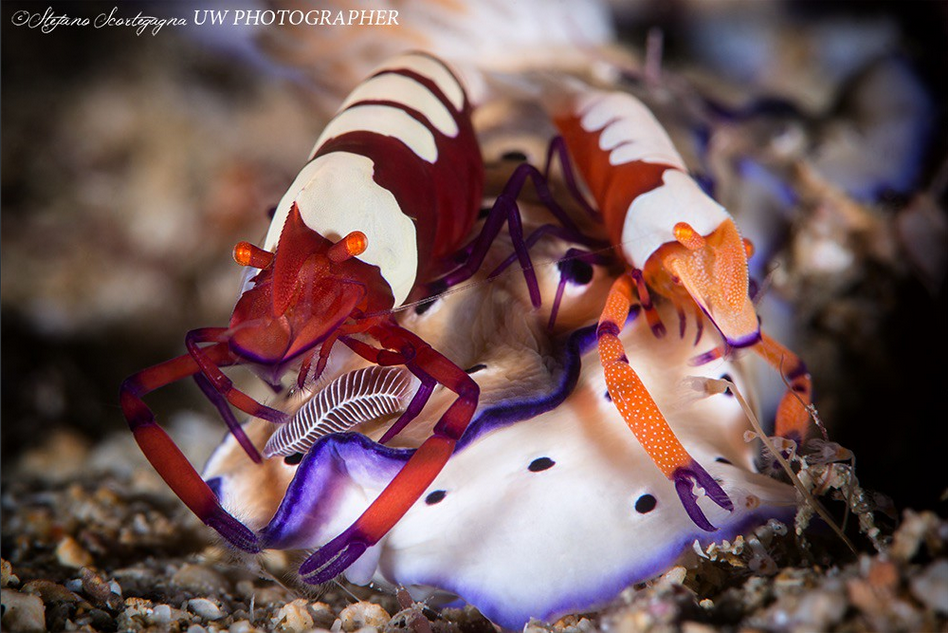 Above photo by [Stefano Scortegagna](https://www.flickr.com/photos/stefanoscortegagna/17367487930/) 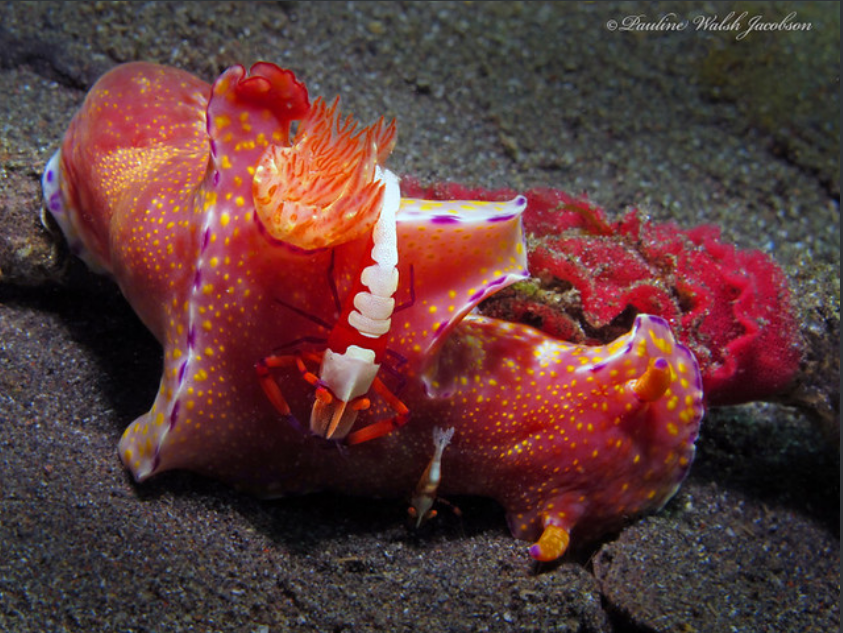 Above photo of Ceratosoma gracillimum with eggs by [Pauline Walsh Jacobson](https://www.flickr.com/photos/coralreefdreams/53111428093/) 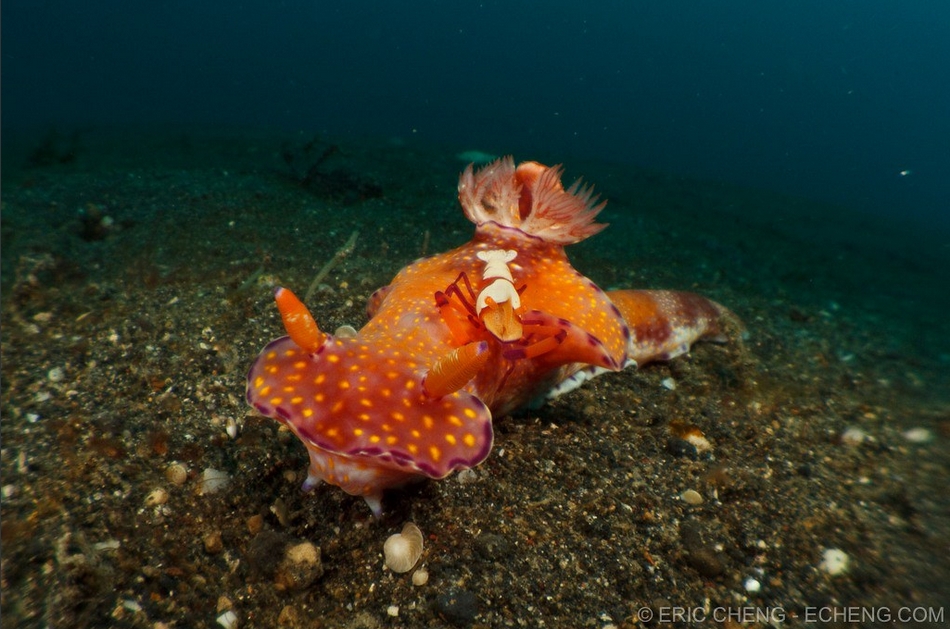 Above photo of Ceratosoma tenue by [Eric Cheng](https://www.flickr.com/photos/echeng/4431715718/) 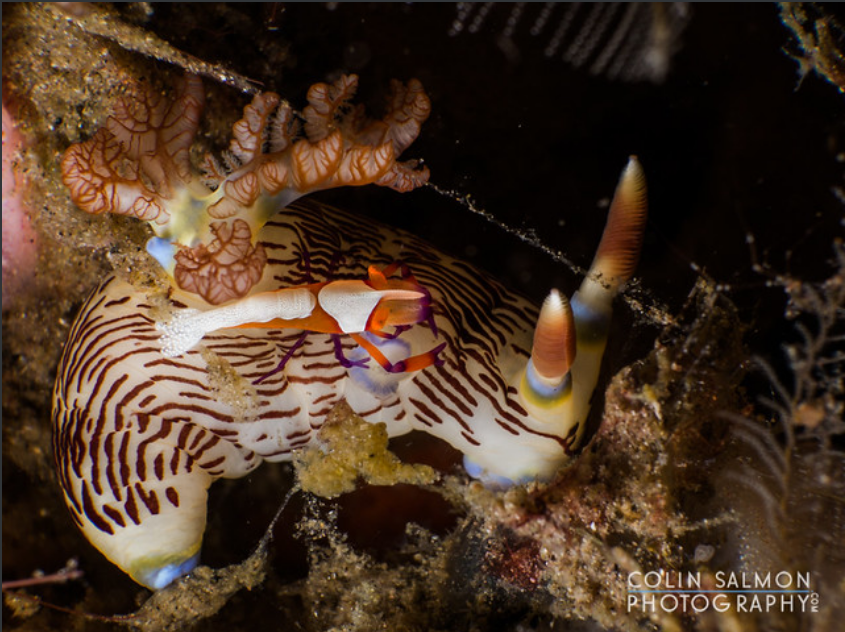 Above photo of Nembrotha lineolata, by [Colin Salmon](https://www.flickr.com/photos/colinsalmonphotography/26164286943/) 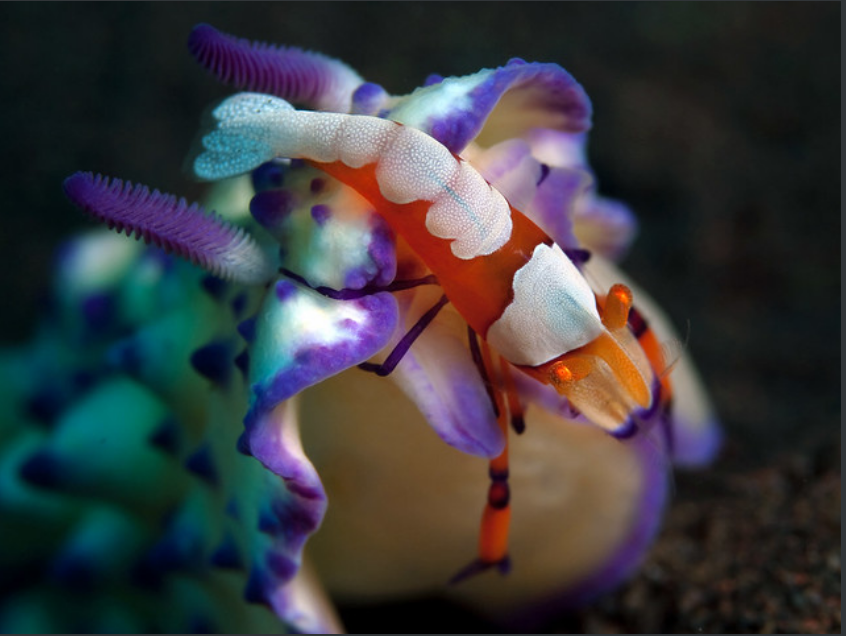 Above photo by [Doug Anderson](https://www.flickr.com/photos/douga/6179671953/) 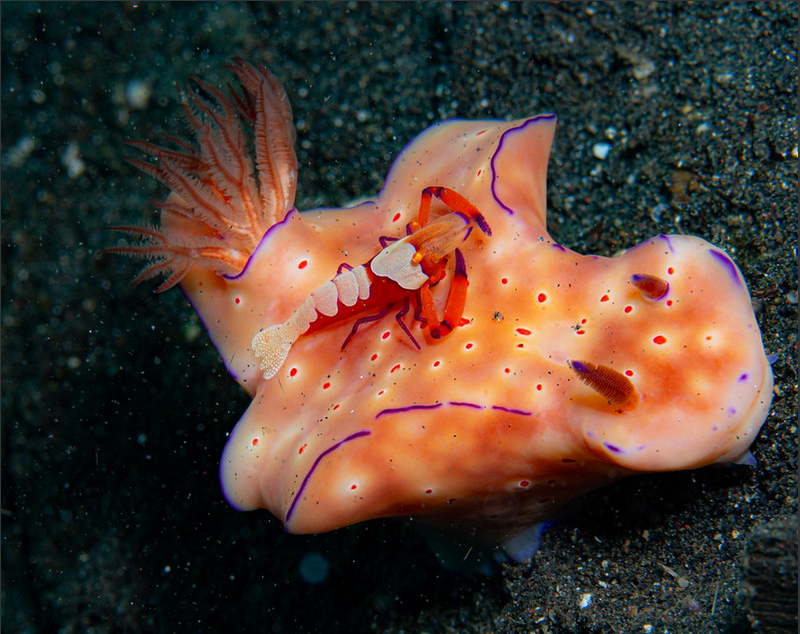 Above photo by [Michel Duchayne](https://www.flickr.com/photos/190779611@N08/50604770681/)  Above photo of Dendrodoris tuberculosa, by [Brian Mayes](https://www.flickr.com/photos/brianmayes/5986205268/)  Above photo of ceratosoma nudibranch, by [KIYOSHI OKADA](https://www.flickr.com/photos/124477069@N06/40566781253/) 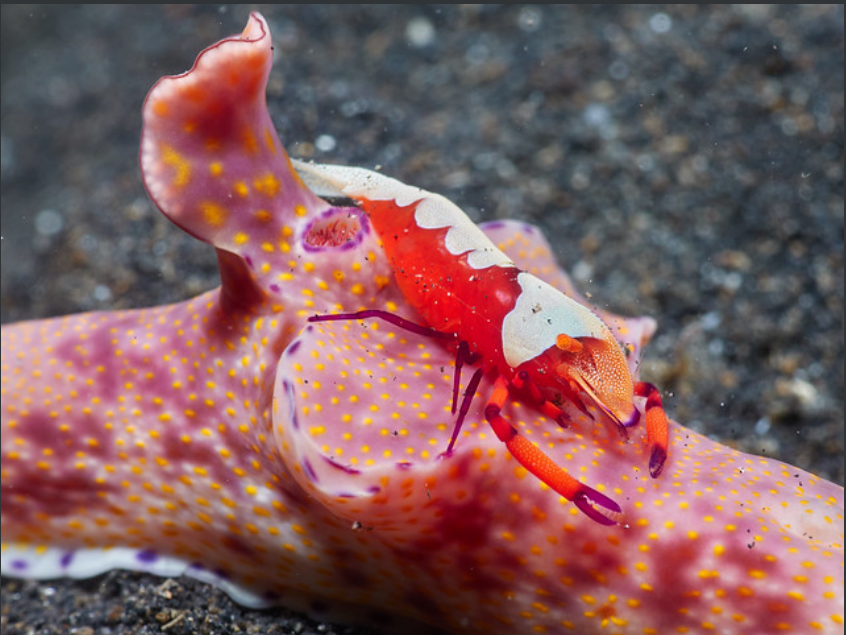 Above photo of Ceratosoma tenue, by [Gomen S](https://www.flickr.com/photos/gomensee/26348187818/)  Above photo by [Colin Robson](https://www.flickr.com/photos/22571051@N06/17387476443/) .... Hail The Emperor! 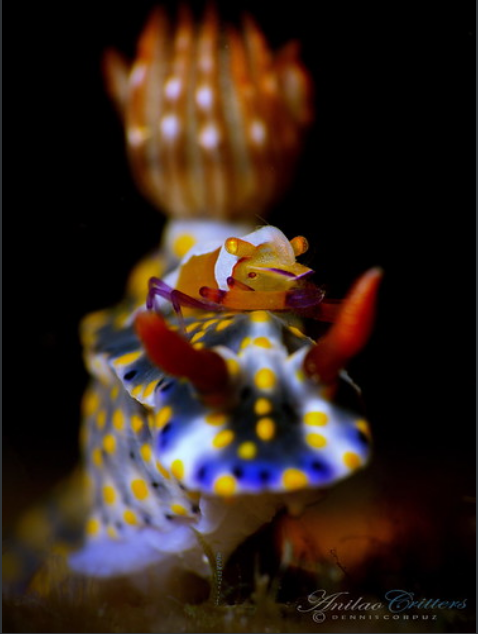 Above photo of Hypselodoris infucata, by [Anilao~Critters](https://www.flickr.com/photos/74171608@N04/15823600444/)
 quinacridone
Now
•
100%
quinacridone
Now
•
100%
Lol, I left a lot of photos out too!
The sex lives of hermaphrodites is really interesting to read up on, I'll probably do something similar on !invertebrates@mander.xyz....there's loads of freaky creatures out there
Part 2 is going to be eggs, larvae and mini-nudis, but I'm off on holiday soon so maybe a 2 week or more wait, unless it rains a lot

Title photo by [Todd Aki](https://www.flickr.com/photos/90966819@N00/10115535594/) - Nudibranchs are hermaphrodites (having both male and female sex organs), but they still require a mate in order to reproduce as they cannot self fertilize  Above nudibranch reproductive system by Carissa Shipman, found [here](https://www.calacademy.org/blogs/project-lab/nudi-sex-ed) - The reproductive organs are usually next to each other inside the nudibranchs body, and the exterior reproductive opening being on its right lateral side 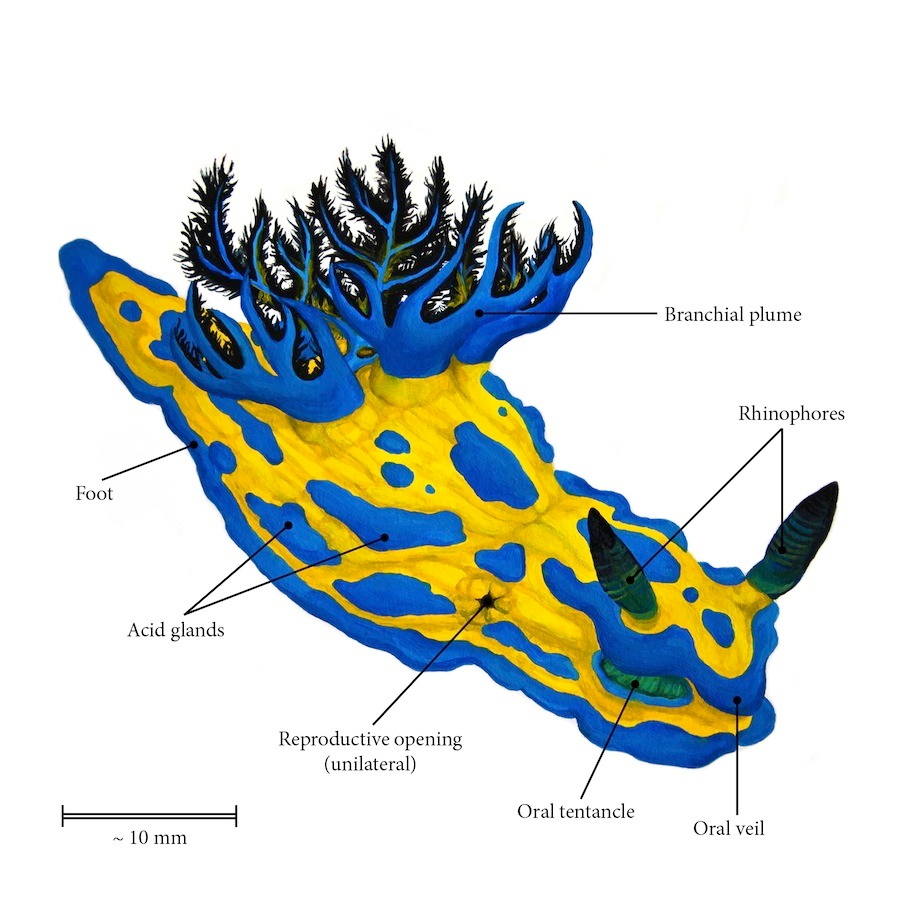 Above, 'External anatomy of a Tambja verconis nudibranch (by wadeangeliart) found [here](https://www.diveoclock.com/destinations/Asia/Philippines/Anilao_nudibranchs/) - Being simultaneous hermaphrodites increases their opportunities to find a mate, as both partners will transfer sperm, and lay eggs, via reciprocal reproduction.....although there are some exceptions as we will discover! 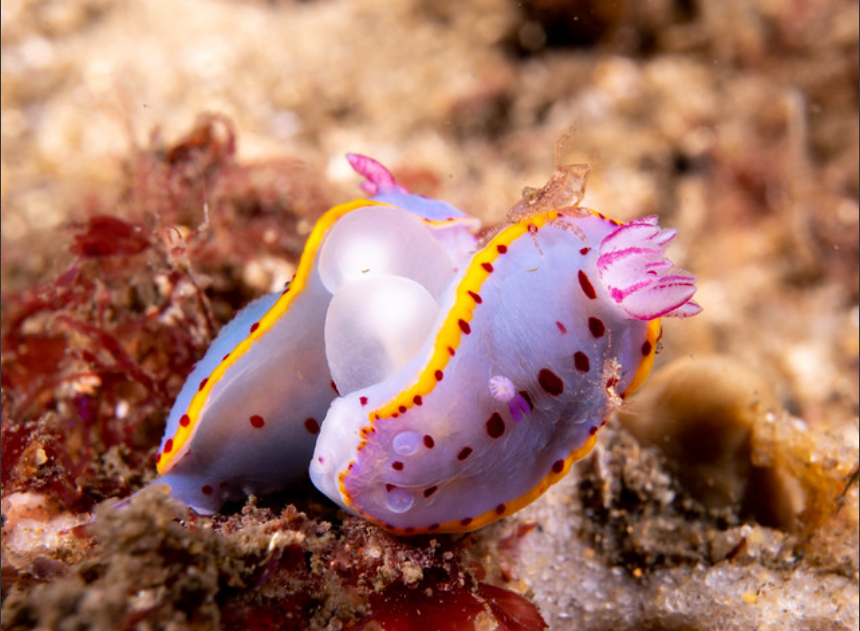 Above photo Bennett's nudibranchs Mating' by [John Turnbull](https://www.flickr.com/photos/johnwturnbull/51706507506/) - Nudibranchs will follow the scent trail left by potential partner. When they catch up with them they start courtship which involves the gentle touching of each other 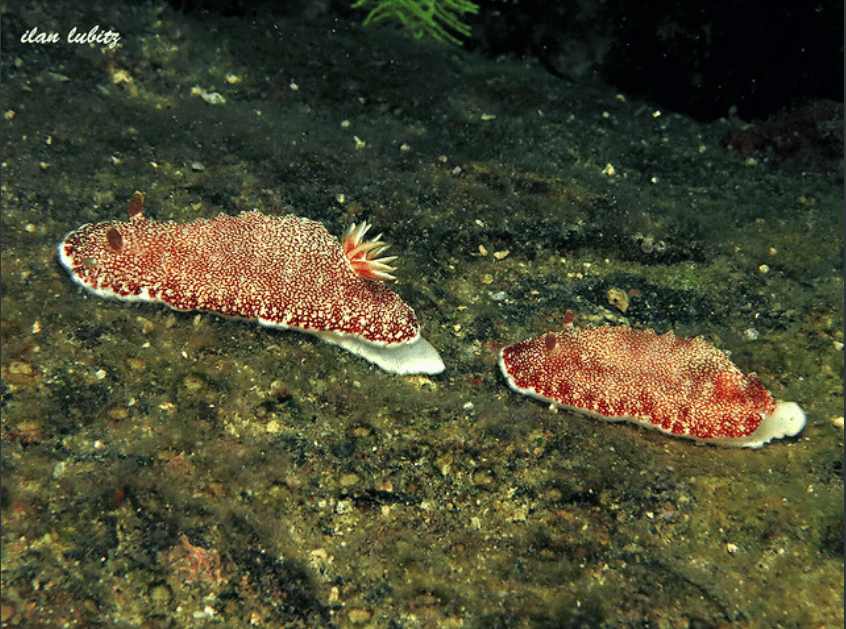 Above photo by [ilan Lubitz](https://www.flickr.com/photos/128664509@N04/26514563779/) - Depending on the species, the nudibranchs will then orientate their bodies so that their reproductive openings are facing, allowing their swollen gonopores to connect  Above photo of Nembrotha chamberlaini mating, by [Jim Greenfield](https://www.flickr.com/photos/jim1/43584566865/) 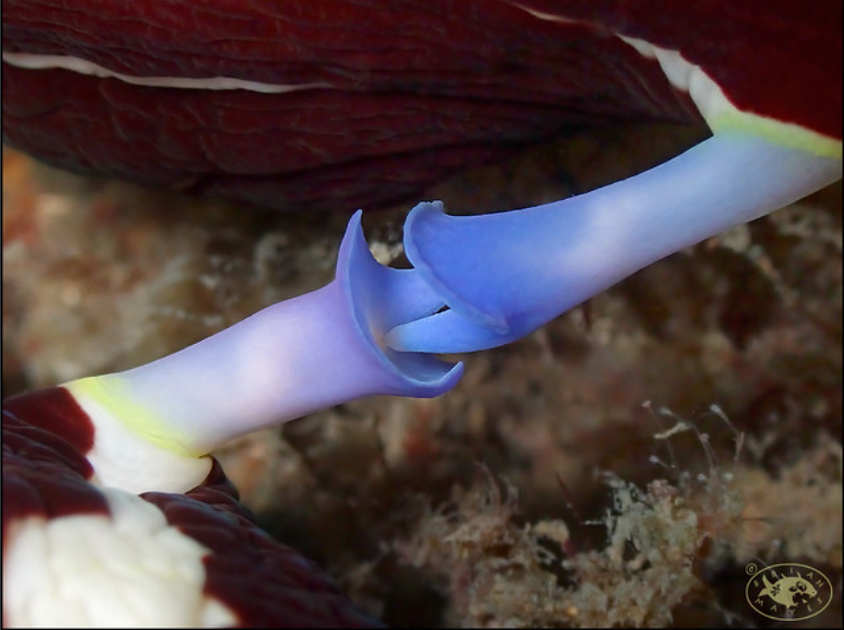 Above photo of Nembrotha purpureolineata, by [Brian Mayes](https://www.flickr.com/photos/brianmayes/53334549252/) - Nudibranchs will take every opportunity they can to mate when finding a partner. One quirk of their anatomical development whilst maturing into adults is that the male reproductive organs will grow, and be functional before their female organs. This is called protandry.... 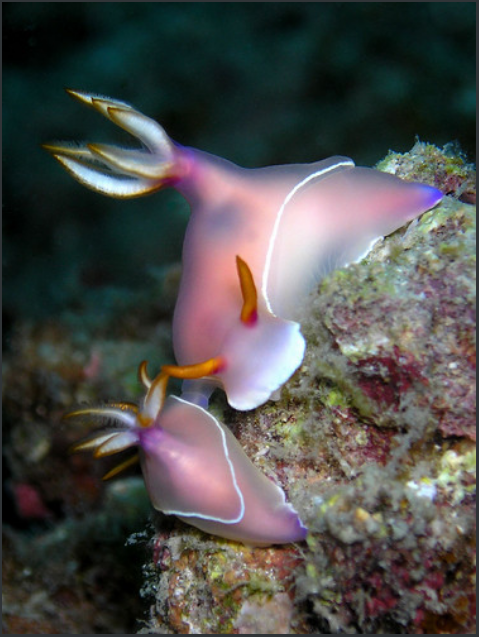 Above photo of Hypselodoris bullocki mating, by [Coppertane](https://www.flickr.com/photos/coppertane/130836284/)....a possible protandry mating, due to size difference - They can still take the opportunity to mate though as a 'male'..... It has been suggested that any sperm passed to the 'male' partner, can be stored within their bodies until their female organs have matured. It will then use the stored sperm to fertilize its eggs!  Above photo of pelagic nudibranchs mating by [Rajiv Bhambri](https://photocontest.smithsonianmag.com/photocontest/detail/mating-pelagic-nudibranchs/) - Mating duration depends on species, and can vary from brief encounters to several hours! 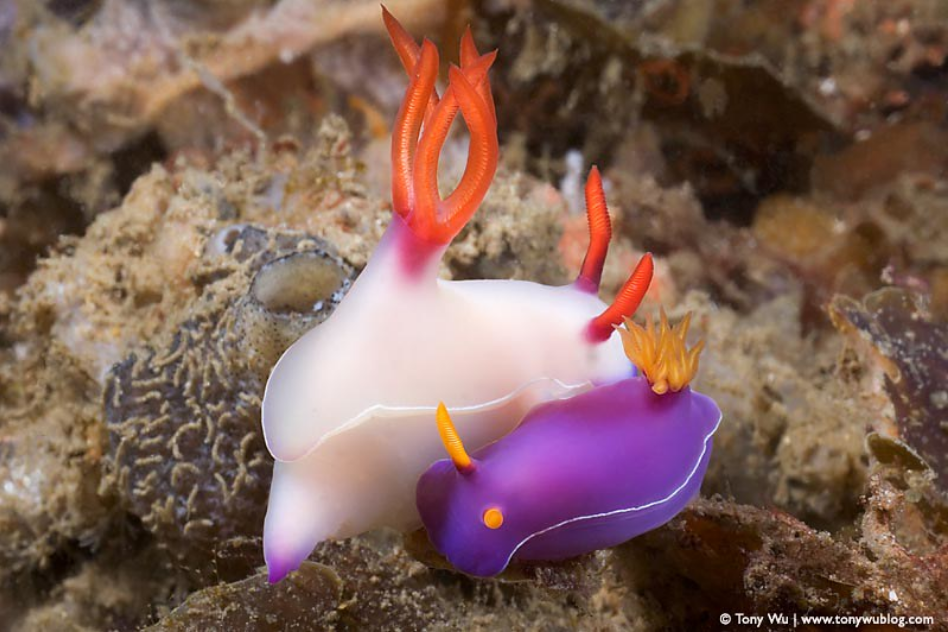 Above photo by [Tony Wu](https://www.flickr.com/photos/tonywublog/322931873/) - There are 3 basic mating positions depending on species- right side to right side..... (see photo below) 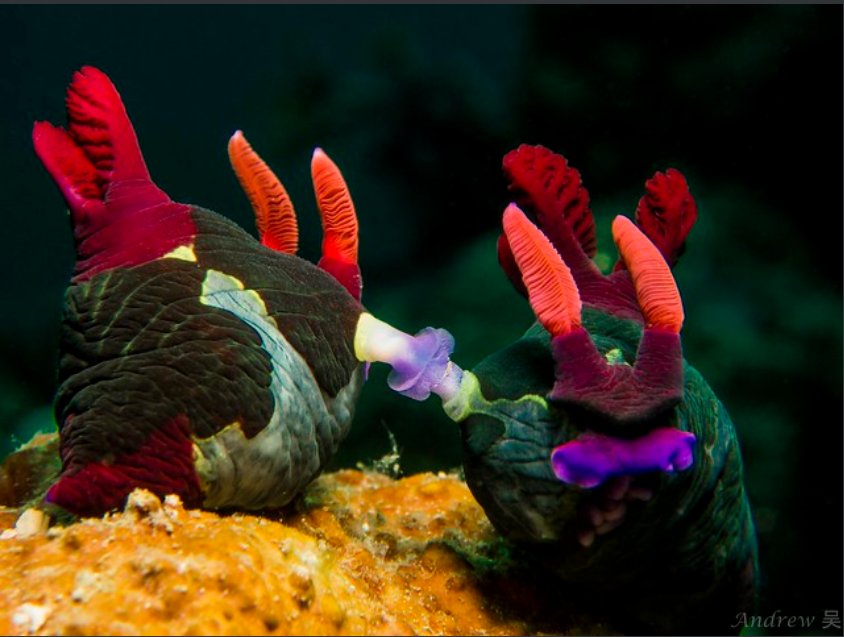 Above, Nembrotha chamberlaini, by [Andrew Wu](https://www.flickr.com/photos/namelessbear/13350412323/) - .....Head to head.....(see photo below)...... 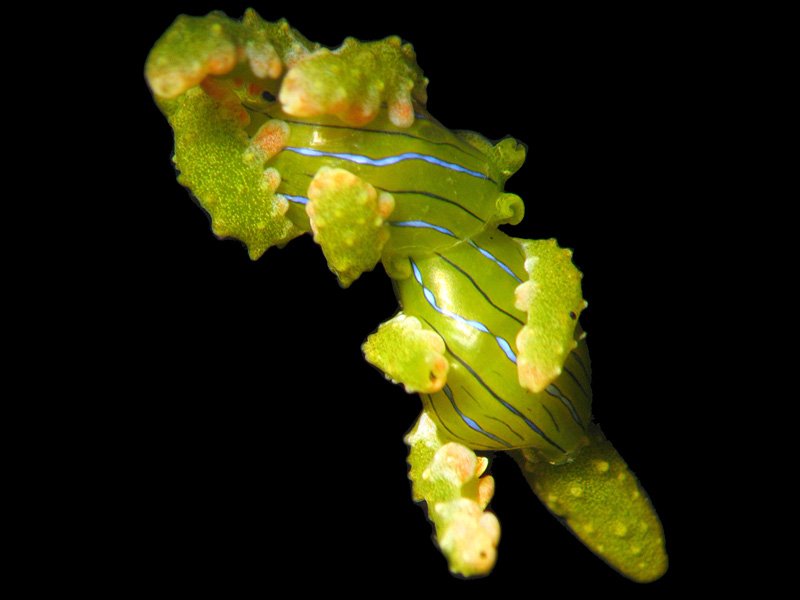 Above, Lobiger viridis, from [here](https://nudibranchdomain.org/rudie-nudies-the-mating-game/) - ......And head to tail, which is either a reciprocal, or a unilateral process depending upon flexibility of the species, or even partner aggression......(see photo below)... 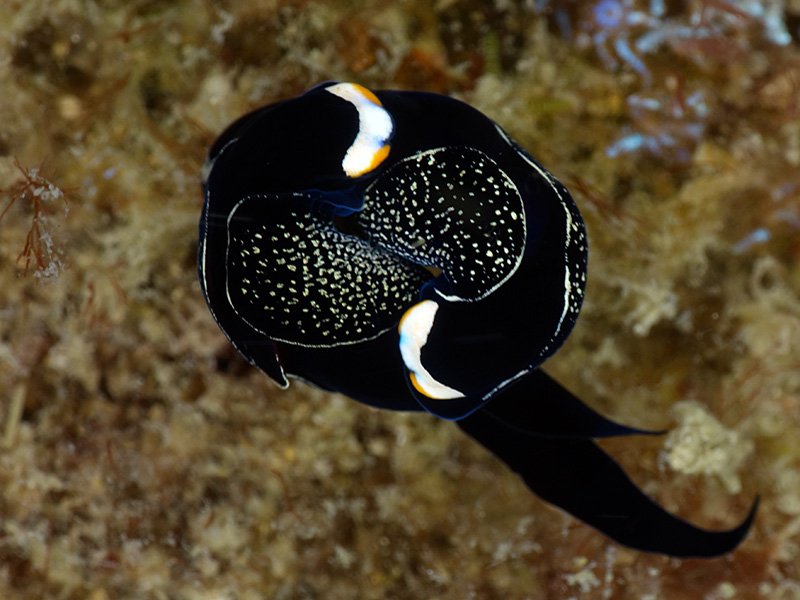 Above, Mariaglaja inornata, from [here](https://nudibranchdomain.org/rudie-nudies-the-mating-game/). The genitals are separate in this species- the penis is in the head, and the vagina in the tail 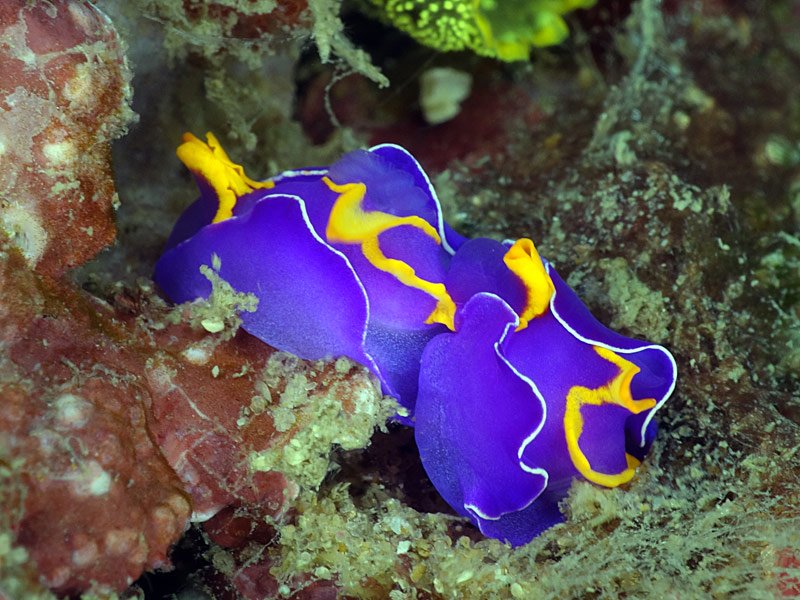 > [Above] The gastropterid sea slug Sagaminopteron ornatum will sometimes form a circle of two to achieve reciprocal mating, or at other times as illustrated here, act unilaterally as a male by approaching from behind to copulate with another acting as a female. [source](https://nudibranchdomain.org/rudie-nudies-the-mating-game/) - Hypodermic Insemination is the preferred method used by some species. The penis has a sharp point which is used to stab the partner in order to deliver a packet of sperm. This can be done either as a mutual act, or happening unilaterally with one nudibranch taking advantage to inseminate another....This can occur amongst some of the sacoglassans 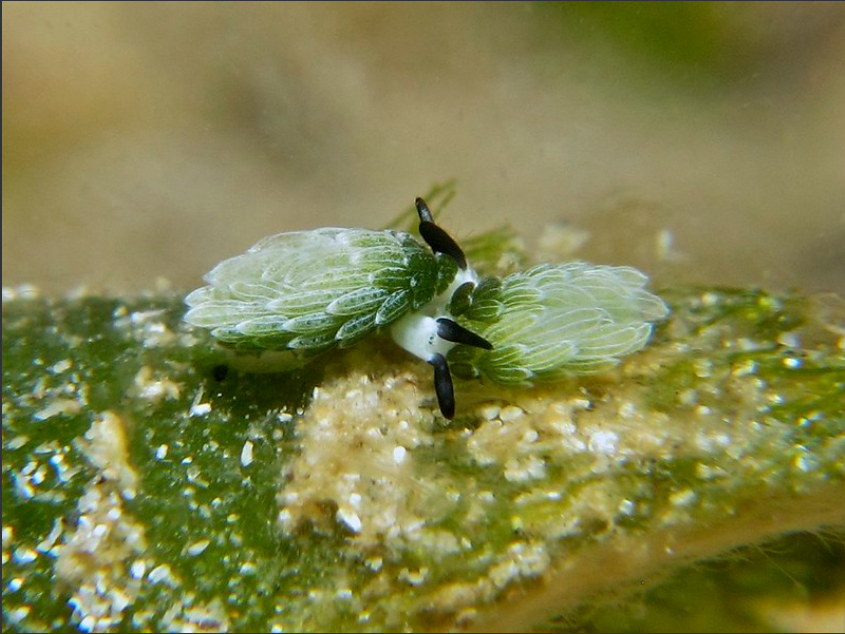 Above photo of Costasiella usagi, by [eunice khoo](https://www.flickr.com/photos/mermate/14194152102/)....not as cute as I originally thought.... - Goniobranchus reticulatus is an unusual nudibranch as after it has mated the external part of its penis detaches! And within 24 hours it grows back.....! >Scientists think this mating strategy has evolved so the sperm of rival nudibranchs stored in the vagina of their mate will not accidentally get passed on to future mates [source](https://www.calacademy.org/blogs/project-lab/nudi-sex-ed) 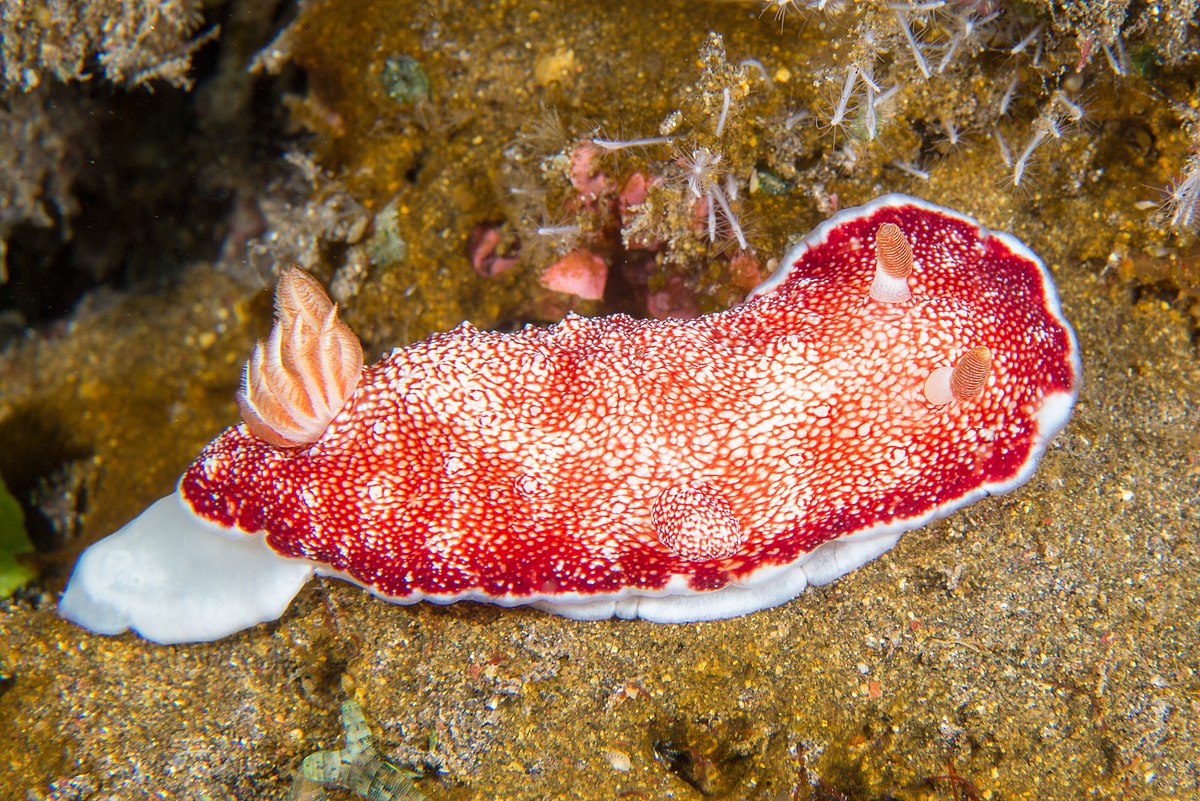 Above photo of Goniobranchus reticulatus by [Bernard Picton](https://en.wikipedia.org/wiki/File:B150318_Goniobranchus_reticulatus.jpg)...with or without penis...(Schrodinger's penis?) ...And finally a shrimp jockey on a pair of mating nudis.... 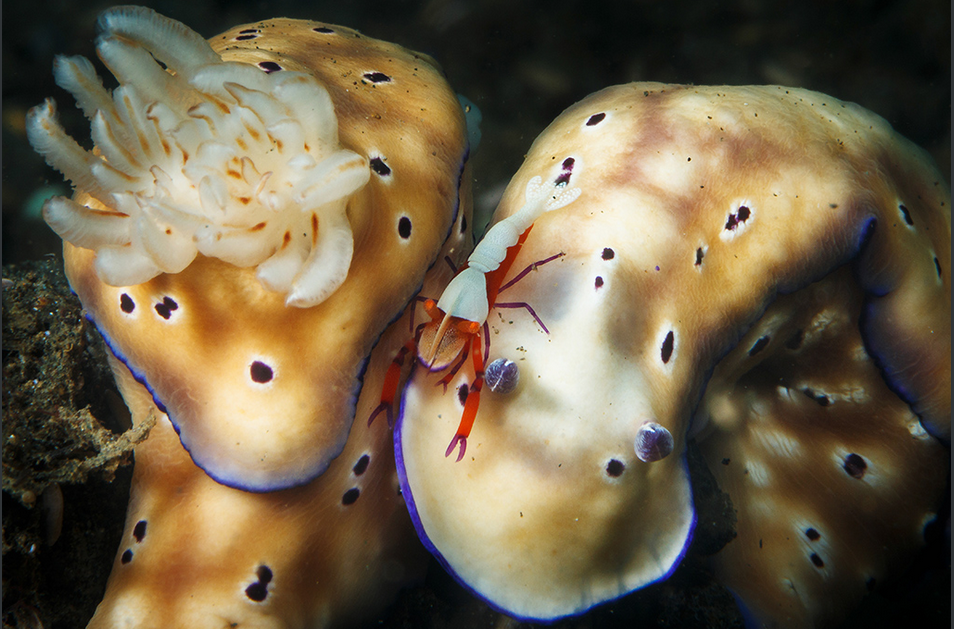 Above photo by [Ludovic](https://www.flickr.com/photos/luko/34086526786/) Information from- [here](https://biologydictionary.net/nudibranch/) [here](https://en.wikipedia.org/wiki/Goniobranchus_reticulatus) and the fantastic [Nudibranch Domain](https://nudibranchdomain.org/rudie-nudies-the-mating-game/) As always, I'm not an expert...any errors let me know in the comments, and I'll edit my post!
 quinacridone
Now
•
100%
quinacridone
Now
•
100%
No probs, it gives me an excuse to scroll through flickr 👍

Main photo by [Dusan Beno](https://www.flickr.com/photos/29855281@N06/5867100103/in/pool-insects-studio-stacks/) 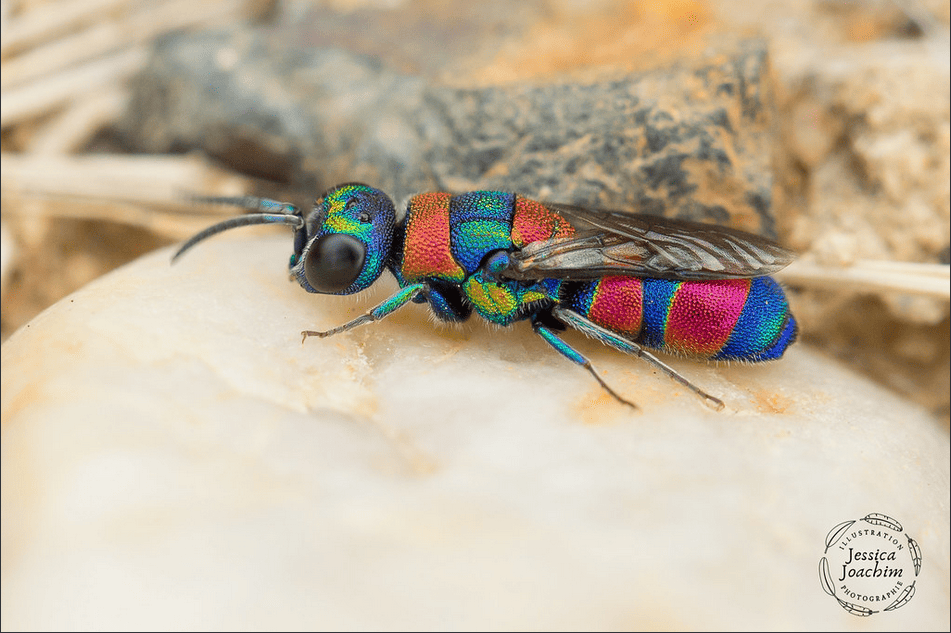 Above, 'Chrysis semicincta' by [Jessica JOACHIM](https://www.flickr.com/photos/tifaeris/48821515013/in/gallery-42145526@N03-72157720322864224/)  Above, 'Cotinis Mutabilis, also known as the Figeater Beetle' by [Cotinis Mutabilis](https://www.flickr.com/photos/tanneryates/6024877920/in/pool-insects-studio-stacks/)  Above photo by [philux66](https://www.flickr.com/photos/pcoffe/51975661218/in/pool-insects-studio-stacks/)  Above, 'Green Tortoise Beetle, Cassida viridis' by [Duncan Cooke](https://www.flickr.com/photos/happydayzphotography/52077353016/in/pool-world_wide_amazing_nature/) >Length; 7 - 10mm. > >Distribution; Widespread in England and Wales, although sparse in the north and rarer in Scotland. > >Habitat; Grassland, Heathland & Moorland, Farmland, Wetlands, Woodland & Gardens. > >Found; April to October. > >The Green Tortoise Beetle is one of a group of several closely related beetles. Host plants include White Dead-nettle, Hemp Nettles, Hedge Woundwort, Gypsywort and Water Mint and is often found in gardens. When disturbed, the adults behave just like tortoises, retracting their antennae and feet, and pulling their 'shell' tight down around them as they grip tightly on to the leaf they are. > >The Green tortoise beetle is round, flattened and lime green. Tortoise beetles are easy to identify as a group, but there are several closely related species that are very difficult to tell apart. the Green Tortoise Beetle is entirely green and generally lacks the markings of other species. Cassida viridis is similar to Cassida rubiginosa but can be distinguished by the rounded rear corners of the pronotum which are sharp in C. rubiginosa. It is also usually more apple green in colour. > >Adults spend a few weeks feeding on host foliage and possibly also pollen before mating in April and May and ovipositing from May to July. Between 1 and 10 eggs laid in firm-walled and distinctive egg cases which are stuck to stems or under lower leaves and covered with frass and leaf fragments. They hatch within 6 to 10 days and the larvae initially feed below the leaves, moving to the upper surface as they grow, they pass through 5 instars and develop rapidly. They are fully grown within 4 to 6 weeks. > >Pupation occurs from June to September. The fully grown larvae move to stems and petioles and become attached by a secretion before they pupate. This stage is also brief, generally lasting about a week, and new generation adults emerge from July to October.  Above 'Green vegetable or Shield bug' by [Bernard Spragg. NZ](https://www.flickr.com/photos/volvob12b/52651443368/in/pool-world_wide_amazing_nature/) >Nezara viridula, commonly known as the southern green stink bug, southern green shield bug or green vegetable bug, is a plant-feeding stink bug. Believed to have originated in Ethiopia, it can now be found around the world. 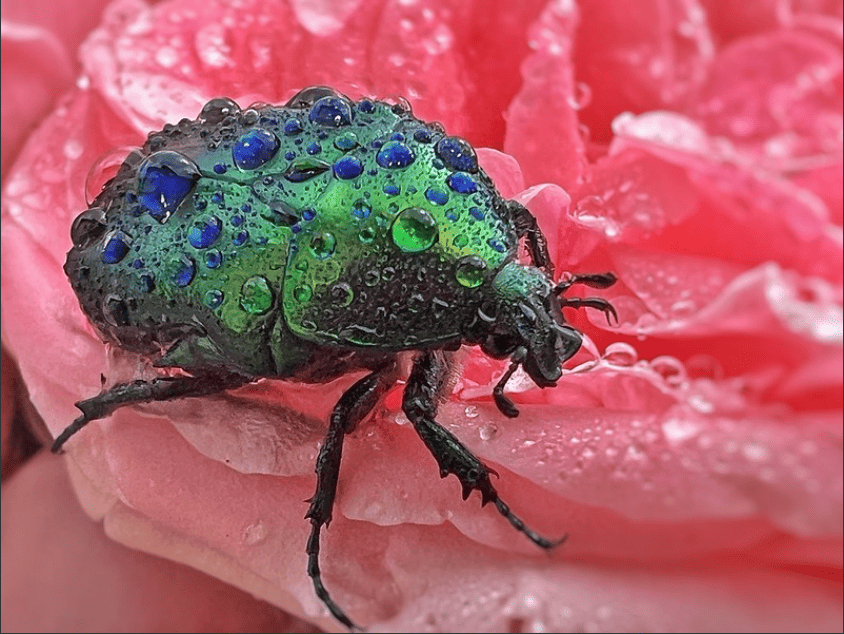 Above, 'Golden Beetle' by [Ivan Anisimov](https://www.flickr.com/photos/outstanding_macro/53611793101/in/pool-closeupandmacrophotograpygroup/)
 quinacridone
Now
•
100%
quinacridone
Now
•
100%
Follow the photographer links and you'll find plenty more! There are a lot of talented people out there...... who aren't me lol
 quinacridone
Now
•
100%
quinacridone
Now
•
100%
Reverse cowboy and side saddle
....and on top of fornicating nudis, anything goes under the sea!
 quinacridone
Now
•
100%
quinacridone
Now
•
100%
As it turns out: me! I want to see shrimps riding on Nudibranchs
Yay! There's literally dozens of us!
And you're welcome, it was nice to browse through some quality nudi pics 👍
 quinacridone
Now
•
100%
quinacridone
Now
•
100%
[they] use the chloroplasts of the algae on which they feed, which they keep alive for hours to months after their ingestion...
Sacoglossans have been known to survive for months living solely on the photosynthetic products of their acquired plastids
Sacoglossans are able to choose which method of feeding they use. The switch from active feeding to photosynthesis in sacoglossans is triggered by the shortage of food resources, and typically not preferred
starvation periods (with photosynthesis and no active feeding) vary between species of sacoglossans from less than a week to over four months, and photosynthesis is used as a last-resort mechanism to avoid mortality
All from wikipedias page on sacoglassa...the whole process is fascinating and worthy of a post in itself, probably one for next week 👍
 quinacridone
Now
•
100%
quinacridone
Now
•
100%
Yep, it's probably why they were only discovered (relatively) recently and good photos are hard to find, unlike their bigger relations....Having said that I didn't realise they'd be that tiny!
 quinacridone
Now
•
100%
quinacridone
Now
•
100%
Cockchafer is a totally safe google, I don't know how it would show without 'safe' or 'moderate' though
Cockchafer.....

 quinacridone
Now
•
100%
quinacridone
Now
•
100%
They are excellent for that!
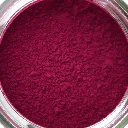 Now
Now
quinacridone
quinacridone@ mander.xyzThis is the mander account for @quinacridone@lemmy.ml
mod of....